for one another



Poet and organizer JazStarr builds bridges on the page and in the community.
 By ALEJANDRO HERNANDEZ 40
By ALEJANDRO HERNANDEZ 40

FREE AND FREAKY SINCE 1971 | SEPTEMBER 29, 2022
SHOWING UP
The Reader’s guide to World Music Festival Chicago Special 16-page insert inside!
CITY LIFE
04 Shop Local Sewing, selfdefense, and other classes to sharpen your mind
leaders to take the reins.
20 Sports The WNBA season is over. Brittney Griner remains in a Russian prison. What’s next?
22 Brown | History A new exhibit at the American Writers Museum features prominent and lesserknown Black authors, poets, and journalists.
and Trap Door’s The Ugly One is a cautionary tale.
FILM
34 Interview Billy Eichner and Luke Macfarlane discuss their new LGBTQ+ film Bros
36 Review Andrew Dominik’s epic allegory Blonde has Melvillian ambition.
FOOD & DRINK
06 Sula | Feature Jaren Zacher takes a nose-to-tail fin approach to eating the invasive copi.
COMMENTARY
08 Joravsky | Politics The Bears finally make their play for public money to build their private stadium.
10 Isaacs | Culture Anti-abortion activists float a new argument: ageism.
12 Ehlers | Prisons Harsh penalties for gun crimes don’t make communities safer.
NEWS & POLITICS
14 Garcia | Public Space
Organizers of the People’s Fest want Douglass Park to be accessible to the community yearround.
16 The TRiiBE | Black Caucus There’s an opportunity for new—and possibly more progressive—Black
ARTS & CULTURE
24 Galleries William Horberg’s art evokes memories of a Chicago gone by.

26 Museums A survey of work from MENA region artists visits Evanston’s Block Museum.
THEATER
29 Performance Marcela Torres blends historical dances in an exploration of crop cultivation and colonialism.
30 Review Enough to Let the Light In gives a thriller twist to a couple’s secrets.
32 Plays of Note Idle Muse’s take on Jekyll/Hyde dissects gender and class politics, Tebas Land maps the territory between artist and subject,
38 Movies of Note Don’t Worry Darling can’t follow through on its promises, Catherine Called Birdy’s gentleness and conventionality may surprise Lena Dunham fans, and The African Desperate offers wry commentary on everything from undecipherable artspeak to racism.
and Tar, plus reviews of releases by Magma, Open Mike Eagle, Petbrick, and others

TO CONTACT ANY READER EMPLOYEE, EMAIL: (FIRST INITIAL)(LAST NAME) @CHICAGOREADER.COM
PUBLISHER AND PRESIDENT TRACY BAIM MANAGING EDITOR SALEM COLLO-JULIN PRODUCTION MANAGER KIRK WILLIAMSON SENIOR GRAPHIC DESIGNER AMBER HUFF STORY EDITOR SUJAY KUMAR NEWS EDITOR JIM DALEY
THEATER AND DANCE EDITOR KERRY REID MUSIC EDITOR PHILIP MONTORO
CULTURE EDITOR: FILM, MEDIA, FOOD & DRINK TARYN ALLEN

ASSOCIATE EDITOR AND BRANDED CONTENT SPECIALIST JAMIE LUDWIG SENIOR WRITERS LEOR GALIL, DEANNA ISAACS, BEN JORAVSKY, MIKE SULA STAFF WRITERS DEBBIE-MARIE BROWN, KELLY GARCIA, KATIE PROUT
LISTINGS COORDINATOR MICCO CAPORALE
48 Early Warnings New concerts and other updated listings
48 Gossip Wolf Fire-Toolz sails even further off the map with a genre-obliterating new EP, the Empty Bottle says goodbye to festival season with Thee Best Western block party, and Chicago punk band Nora Marks celebrate a new album at Gman Tavern.
SAVAGE LOVE
VICE PRESIDENT OF OPERATIONS ANN SCHOLHAMER
DIRECTOR OF DIGITAL JOHN DUNLEVY
DIRECTOR OF MARKETING VIVIAN GONZALEZ MARKETING PROJECT STRATEGIST SHAWNEE DAY
DIRECTORS OF CIMA SAVANNAH HUGUELEY, YAZMIN DOMINGUEZ
MUSIC & NIGHTLIFE
40 Profile Poet and organizer JazStarr builds bridges on the page and in the community.
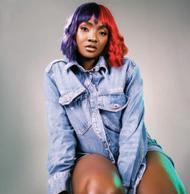

42 The Secret History of Chicago Music Pianist Erwin Helfer has survived more than a virus to carry forward the legacy of the progenitors of blues and jazz.
44 Shows and Records of Note Previews of concerts including Kali Malone, the Medicine Singers,


50 Deal or No Deal Dan Savage offers advice to a man whose wife slut-shames him when he hook ups with other women.
CLASSIFIEDS
Jobs
Rentals and Real Estate
ON THE COVER: PHOTO BY THOUGHTPOET. FOR MORE OF THOUGHTPOET ’S WORK, GO TO THOUGHTPOETSOPINION.COM.
EXECUTIVE ASSISTANT SANDRA L. KLEIN ADVERTISING
312-392-2970, ADS@CHICAGOREADER.COM
CLASSIFIEDS: CLASSIFIED-ADS@CHICAGOREADER.COM
VICE PRESIDENT OF SALES AND BUSINESS DEVELOPMENT AMBER NETTLES
VICE PRESIDENT OF SALES AMY MATHENY SALES TEAM VANESSA FLEMING, TIM OGDEN, TED PIEKARZ, WILL ROGERS DIGITAL SALES ASSOCIATE AYANA ROLLING
NATIONAL ADVERTISING VOICE MEDIA GROUP 1-888-278-9866
VMGADVERTISING.COM
JOE LARKIN AND SUE BELAIR
DISTRIBUTION CONCERNS distributionissues@chicagoreader.com 312-392-2970
READER INSTITUTE FOR COMMUNITY JOURNALISM, INC.
CHAIRWOMAN EILEEN RHODES
ACTING SECRETARY KIM L. HUNT DIRECTORS ALISON CUDDY, VANESSA FERNANDEZ, ROBERT REITER
READER (ISSN 1096-6919) IS PUBLISHED BIWEEKLY BY THE READER INSTITUTE FOR COMMUNITY JOURNALISM 2930 S. MICHIGAN, SUITE 102 CHICAGO, IL 60616 312-392-2934, CHICAGOREADER.COM
THE READER’S GUIDE TO WORLD MUSIC FESTIVAL CHICAGO

The festival’s 11 free concerts, spread out over ten days and 11 venues, o er more than inspiration and fun—they invite us to forge new bonds of community and care.
COPYRIGHT © 2022 CHICAGO READER PERIODICAL POSTAGE PAID AT CHICAGO, IL
ALL RIGHTS RESERVED. CHICAGO READER, READER, AND REVERSED R: REGISTERED TRADEMARKS ®
2 CHICAGO READER - SEPTEMBER 29, 2022 ll
52
53
THIS WEEK CHICAGO READER | SEPTEMBER 29, 2022 | VOLUME 51, NUMBER 26
IN THIS ISSUE

SEPTEMBER 29, 2022 - CHICAGO READER 3
CITY LIFE
Shop Local
Continuing education

Sewing, self-defense, and other classes to sharpen your mind.
By SALEM COLLO-JULIN
It’s never too late to learn a new skill, or polish an old one. Chicago has many organizations that o er adult education classes and workshops designed to teach students new concepts, technical skills, or even new dance moves. Taking a class is a good way to set an ongoing friend date if you’re someone who has a tough schedule and misses hanging out with people. And you can meet new friends and network! Here’s a few ideas to get you started.
Stories of Our Genes and Ancestry
Sites like Ancestry.com have made it easier for us to map out our family trees, but what do you do after you’ve found all the names and dates?
Through the Newberry Library’s Adult Education program, Dr. Aaron Greenberg, cofounder of the storytelling technology company Biograph and lecturer at the School of the Art Institute of Chicago, teaches this four-session virtual seminar to assist amateur genealogists and family story keepers in transforming research into narratives that contextualize facts and create a deeper picture of our ancestral pasts.
Saturdays 10/29-11/19, 2-4 PM, $193.50-$215, newberry.org
Sewing 101
Maybe you’re not interested in appearing







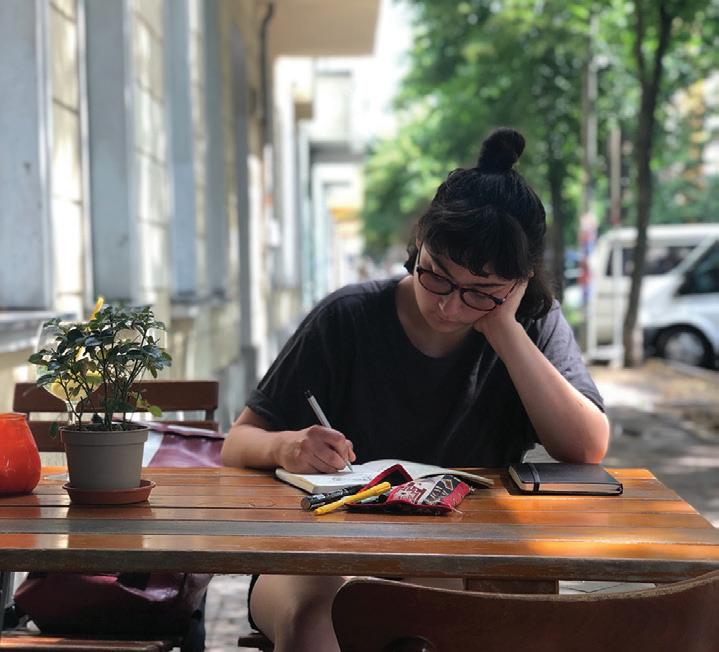
on Project Runway , but wouldn’t it be nice to be able to confidently hem those jeans or at least get that big button back on to your winter coat? Learn some basic skills from a real fashion designer, Chicagoan Anastasia Chatzka, who will teach you how to use a sewing machine, attach buttons and zippers, and even read a sewing pattern. No experience is necessary to start. If you get the hang of it, Chatzka also o ers advanced classes in tailoring, knitwear, and streetwear. Students can opt for Sunday or Saturday morning or Monday evening sessions that happen at Chatzka’s
studio (2041 W. Carroll, Suite 222). Next six-week sessions start Sun 10/23, $345 includes materials, anastasiachatzka.com
City Colleges City Colleges of Chicago offer an array of both in-person and online instruction designed for adults who need affordable professional certifications, GED courses, and also . . . stepping. You can still get in on Steppin’ for Fun and Fitness , a late fall offering at Daley College (7500 S. Pulaski) that will teach you the basic moves and flair
of stepping—a partner dance form created in Chicago and often performed to R&B music.
Wednesdays 10/19-12/7, 6-7 PM, $55
And if you’re interested in working on your drawing techniques, let the city be your muse with Urban Sketching: An Introduction, an in-person class hosted by Harold Washington College (30 E. Lake). Most classes will be held at destinations in the Loop or reachable by public transportation. Students will learn to draw what they see in the city using pencil and ink.
Saturdays 10/1-11/5, 10 AM-1 PM, $189 Information and registration for both at ccc. edu
The Five Fingers of Self-Defense Self-defense isn’t just about knowing a martial art—in fact, skills like risk assessment, positioning strategies, and verbal tools are essential to navigating crisis situations. The people at Thousand Waves Martial Arts and Self-Defense Center teach the “five fingers” approach: think, yell, run, fight, tell. These strategies can also lead to better awareness and communication skills within all your interpersonal relationships. Training is available to people of all genders ages 12 and up.
Two-hour workshop, future dates Sat 10/8 4-6 PM and Fri 12/9 6-8 PM, $50 (sliding scale available), 1220 W. Belmont, 773-472-7663, thousandwaves.org v


SECOND-CHANCE PROMOTION












Enter for a chance to win up to $50 MILLION in Las Vegas!

4 CHICAGO READER - SEPTEMBER 29, 2022 ll
Learn to sketch and never be bored at a cafe again KLAUDIA PIASKOWSKA/UNSPLASH
The Price is Right®/© FremantleMedia Netherlands B.V. 2022 Licensed by Fremantle. All Rights Reserved. www.fremantle.com See
O
icial
Rules, which govern, for complete details.
See Ticket for Details
@hollo













































































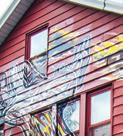








SEPTEMBER 29, 2022 - CHICAGO READER 5 sites150+ 15 – 16 October neighborhoods20+ discoveriesENDLESS The Chicago Architecture Center app is your key to sites across the city during OHC weekend. Plus, programs and self-guided tours throughout the month. openhousechicago.orgGET IT ON
Chả Cá Nuggs takes a nose-to-tail fin approach to eating the invasive copi
Jaren Zacher’s Asian carp nuggets are coming to Monday Night Foodball, the Reader’s weekly chef pop-up at the Kedzie Inn.
 By MIKE SULA
By MIKE SULA
The invasive fish formerly known as Asian carp was renamed “copi” earlier this summer by the Department of Natural Resources. Short for “copious,” the state hopes that a vaguely Mediterranean-sounding rebranding will entice consumers to eat more of the bony, obscenely prolific, freshwater filter feeders that have outcompeted native species for all
that good Illinois River algae and zooplankton since the aughts—after they’d apparently escaped the southern catfish and water treatment ponds they were imported to clean up.
The state’s Choose Copi campaign brought in the big guns, recruiting chefs like Brian Jupiter of Ina Mae Tavern and Frontier, Beverly Kim of Parachute and Wherewithall, and Paul Virant of Gaijin and Vie, to extol the firm,

clean-tasting, healthy flesh of the leaping leviathans.
It’s not the first attempt to redeem the erstwhile Asian carp, a group of four surface swimming species—silver, bighead, black, and grass—whose nominal association with their whiskered, bottom-feeding, muddy-flavored cousins have kept them out of markets and restaurants, just as much as their obstinate,
unfilet-able bone structure.
Neither factor has ever been an issue in southeast Asia where they’re a staple—valued additions to hot pots and soup bowls, either chopsticked whole or emulsified into cakes and fish balls.
That was Jaren Zacher’s thinking a year ago when he embarked on an independent R&D project in his home kitchen, looking for a “holistic” approach toward eating the fish into oblivion, or at least environmental manageability. “It doesn’t present as a filet really well just because of the Y bones and general structure of the fish,” says Zacher, who runs a copi-focused bar snack pop-up called Chả Cá Nuggs. “A lot of Americans aren’t exposed to fish that hasn’t been fileted. But I come from a Jewish background. I’ve been eating gefilte fish since I was a kid. I think that’s why I felt comfortable going into it like this. I looked at where these fish were originally coming from—southwestern China, Thailand, Vietnam—and what they do there is they use it in fish cakes. So, ‘OK, let’s look at it that way.’”
Zacher, who’s 28, has worked in restaurants since he was a teenager, mostly in the front of the house—and for a two-year stint in Lettuce Entertain You Enterprises’s accounting department. He became interested in the carp problem when their potential threat to the Great Lakes made headlines about a dozen years ago. “I tuned in on that, and it was something always in the back of my mind. Like, there’s definitely a way to solve this problem from a food perspective. But I was a young twentysomething; I didn’t really have the experience to figure out what that was.”
Zacher found his way into the kitchen often enough. As the lead food runner and expeditor for LEYE’s rotating chef concept Intro, he volunteered to stage in the kitchen throughout its one-year-and-change run. When he took o for Australia in 2018, he landed a stint in the kitchen of John Niland, the Sydney-based chef at the forefront of sustainable fish cookery.
“He’s all about using as much of the fish as possible—kind of that nose-to-tail mentality—he uses o al; he makes charcuterie. It made me reevaluate how I was looking at copi.”
When Zacher returned home last fall he cleaned out the limited minced Asian carp reserves at Dirk’s Fish and then reached out to
6 CHICAGO READER - SEPTEMBER 29, 2022 ll FOOD & DRINK
Jaren Zacher preps an assortment of dishes with copi. GREG ROTHSTEIN FOR CHICAGO READER
FEATURE
Find more one-of-a-kind Chicago food and drink content at chicagoreader.com/food.
FOOD & DRINK
the DNR who pointed him in the direction of Roy Sorce of downstate Peoria’s Sorce Freshwater Company, a “family-owned purveyor of tasty invasive fish.”
“He works directly with a cooperative of fishermen who fish the Peoria Pool of the Illinois River. He’s got a processing facility that backs up to the river down there. The guys pull the fish right out of the water and drive their boats right up to the facility. They’re processed straightaway, so it’s a quick, clean, fresh process. You don’t get any of the stagnation that can happen with river and lake fish.”
Zacher started out with small amounts of Sorce’s minced copi, and began experimenting with binders, seasonings, and batters until he settled on a standard fish cake base he was happy with, emulsifying the fish with cassava flour and cornstarch for elasticity and chew; seasoning it with onion and garlic powder, salt and pepper, and bit of paprika; and dredging McNugget-sized cakes in cornmeal and rice flour tempura before deep frying.
He named his concept for Hanoi’s storied turmeric-seasoned freshwater fish dish, Ch ả Cá Thăng Long, and incorporated a magnolia blossom into his logo to refer to New Orleans and the undersung cross-cultural Vietnamese-Cajun cuisine that emerged along the gulf coast starting in the 80s. “I wanted to pay service to the food traditions I was pulling from without appropriating. I see the fish as cross-cultural. The preparation is inspired by where the fish are from, and the flavor profile demonstrates how it could adapt here. I’m trying to present both angles to show how much
of a blank slate copi can be.”
He debuted his deep-fried copi nuggs at a pop-up at Kimski in June, served with a handful of vegan dipping sauces: miso BBQ, honey mustard, lime cilantro crema, and remoulade. “It surprises a lot of people that I’m making a vegan remoulade. It’s not like I need to make vegan sauces, but I want to showcase this fish as much as I possibly can.”
He o ered a trio of po’boys too, built on Ba Le bread, which included a ri on a banh mi, with a variant steamed and fried fish cake; a take on a traditional New Orleans oyster po’boy subbing in carp nuggs; and a nod to the McRib, with pickles, onions, and barbecue sauce.
“It was absolutely terrifying,” he says. “This is definitely a one-man show, and I didn’t know what I was getting myself into.” But the feedback was encouraging enough that he followed up with two more pop-ups at Ludlow Liquors in August and September. His fourth is this October 10th at Monday Night Foodball, the Reader’s weekly chef pop-up at the Kedzie Inn in Irving Park. More on that later.
For now Zacher’s not trying to get into food manufacturing or restaurant supply. His efforts are purely public-spirited.
“This is a self-funded brand awareness campaign,” he says. “Maybe I’m a little too altruistic about it all, but I think it’s a good quality fish, and I’ve got no problem putting my time, sweat, and e ort behind it to get more people to try it out.” v
@MikeSula
The Active Transportation Alliance discusses its campaigns to fight car-dependency

 by John Greenfield
by John Greenfield
The leaves are falling over the Kedzie Inn, and that means it’s a new lineup for
Monday Night Foodball
the Reader’s weekly chef pop up series. Follow the chefs, @chicago_reader, and @mikesula on Instagram for weekly menu drops, ordering info, updates, and the stories behind Chicago’s most exciting foodlums.
Oct. 3: Pasta night with Tony Quartaro of Gemma Foods @gemmafoods
Oct. 10: Night of the Copi (the invasive species formerly known as Asian carp) with Cha Cá Nuggs @chacanuggs
Oct. 17: Traditional Jewish deli with a modern purpose with Schneider Provisions @schneider_provisions
Oct. 24: Sausage party with the Hot Dog Box
@thehotdogboxofficial
Oct. 31: Halloween bye night Nov. 7: Plant-focused taqueria pop-up Piñatta @pinattachicago
Nov. 14: The return of barbecue ronin Heffer BBQ
@therealhefferbbq
Nov. 21: An all-star Umamicue Friendsgiving @umamicue Nov. 28: Thanksgiving break Dec. 5: Spotlight on Lao cuisine with Laos to Your House
@laostoyourhouse773 Dec. 12: Kimski rumspringa with Won Kim @revisecmw Dec. 19: First night of Hanukkah with Zeitlin’s Delicatessen and Schneider Provisions @zeitlinsdelicatessen @schneider_ provisions
See chicagoreader.com/food-drink/ for weekly menus and ordering info
Paid Sponsored Content
Over the next six issues of the Chicago Reader, we'll be talking with local sustainable transportation organizations that are working to make the Chicago area a safer, more just, more efficient, and more fun place to get around on foot, bike, transit, and other green modes We're starting with the Active Transportation Alliance Founded in 1985 as the Chicagoland Bicycle Federation, the ATA works to improve conditions and increase opportunities for bicycling, walking and transit I recently caught up with the group ’ s managing director of advocacy Jim Merrell, to discuss some of the challenges facing Chicagoland when it comes to transportation equity.
"We still have a very car centric policy regime in the area, where cars are still king," Merrell said. "Prioritizing car traffic over other considerations, such as safety and quality of life, unfortunately continues to be a big driving force for a lot of decisions that are being made "
On the bright side, Merrell added, the U S has a new $1 2 trillion federal infrastructure bill, Illinois has a nearly $45 billion state capital plan, and the city of Chicago has a $3.7 billion infrastructure program "Money's flowing in a way that it hasn't in some time "
Still, too much of that cash could be allocated to highway expansion, he added For example, Governor JB Pritzker wants to use billions of federal dollars to add lanes to the Ike and Stevenson Expressways. "Any project that expands road capacity is going to lead to more driving," Merrell noted "That's inherently an inequitable outcome when it comes to who bears the burden of that additional driving, its impact on climate and air quality. . . . When we talk about equity, the big picture is breaking the cycle of car oriented policy at all levels of government "
So if we can't beat traffic jams through highway expansion, how can we help people get where they need to go more efficiently? One of ATA's key campaigns is to improve bus service a non sexy but crucial mode especially for Black, Latino, and lower income residents Well enforced bus lanes help provide faster, more reliable service. But while New York has 138 miles of these facilities and Los Angeles has 107, Chicago has a measly 11 miles which are often disrespected by motorists
Read the rest of this interview online at chicagoreader com/transportationseries
Coverage funded by The Darrell R Windle Charitable Fund and Polo Inn
SEPTEMBER 29, 2022 - CHICAGO READER 7ll
COMMENTARY
POLITICS
Just like we told you
The Bears finally make their play for public money to build their private stadium.
By BEN JORAVSKY
We’ve reached an “I told you so” moment, dear readers, where I get to say . . . I told you so.
It was roughly one year ago that I predicted the Bears would probably call upon the good citizens of Arlington Heights to fork over a TIF handout to build their new football stadium on the site of the old racetrack.
And so it was that last week George Halas McCaskey, chairman of the Bears, held a dog and pony show at Hersey High School in Arlington Heights to say, “Yeah, that hippie guy from the Reader had it right. We’re about to sock it to you.”

OK, McCaskey’s far too smart to put it so bluntly. Instead, he said: “The Bears will seek no public funding for direct stadium structure construction. However . . .”
Get ready, Arlington Heights, cause what
comes after “however” is never a joke.
“We will need help,” McCaskey continued. Just like I told you.
Now McCaskey has not mentioned exactly what kind or how much help they will need. But I think we can all agree that before this is over the Bears will have stuck their big ol’ paw into that Tax Increment Financing honeypot.
Courtesy of the Arlington Heights taxpayers.
As a taxpaying resident of Chicago all I can say is thank goodness it’s them and not me.
For once.
By the way, I made that initial prediction a year ago after an unintentionally funny headline in Crain’s Chicago Business that said: “A new Bears stadium: Who’d pay for it?” Like there was any doubt as to the answer to that question.
This year’s funny headline ran in the Sun-
Times. It said: “The Bears have had preliminary talks with [Governor] Pritzker, lawmakers about subsidies—and no one has slammed the door.” You know, like the Bears are waiting with bated breath to see if they get what they want.
Call me jaded, people, but I do not believe the Bears would have gone this far—placing an option to buy the old racetrack and hiring consultants to do tra c surveys—if they weren’t reasonably assured that it was only a matter of time before the handout was theirs.
That means we’ve reached what I call the get-that-o cial-an-Oscar phase of TIF deals. I call it that because public o cials will conjure their inner Brando as they play the role of unbiased public servants, objectively sifting through the evidence to determine if, in fact, a handout is warranted.
As opposed to having already made up their minds to give the Bears what they want.
If Arlington Heights is anything like Chicago, its leaders will eventually find themselves reassuring taxpayers that, after carefully studying the matter, they’ve concluded that handing over public money to the Bears is in the public’s best interest. So it will be like the Bears are doing the taxpayers a favor, as opposed to the other way around.
At last week’s dog and pony presentation, the Bears promised that no public dollars will go to construct the football stadium. Which is a distinction without much meaning to taxpayers. Since taxpayers will be shelling out money for other parts of the stadium project.
And, really, what di erence does it make if public money goes for seats in the stadium, as opposed to the parking lot around the stadium, or the foundation on which the stadium rests, or the roads leading to the stadium and so forth? It’s still public money helping the Bears pay for their stadium.
Curiously, McCaskey’s pledge undercuts the Bears’ argument that they need money at all. Because if they can a ord to build a stadium without a subsidy, why take the subsidy at all?
I’ll say this for the Arlington Heights deal— at least it’s generated some resistance. This one from the right, which has been notoriously silent in regards to Chicago’s TIF scam.
Specifically, opposition comes from the Americans for Prosperity-Illinois, a local a l-
iate of an outfit created by the Koch brothers, those far-right libertarians whose policies I generally abhor.
But I agree with them here. They say they’re sick and tired of “corporate welfare.” And I say, right on to that. For all these years, I’ve been watching Mayors Daley, Emanuel, and Lightfoot doling out TIF money to wealthy developers on the grounds that it’s an “investment” in Chicago.
And then I watch them turn around and say we can’t a ord mental health clinics in poor neighborhoods or librarians and nurses in public schools.
When they give money to rich people, it’s always an “investment.” But when they spend the money on people who really need it, it’s treated like a waste. So, yes, I find myself in the unlikely position of cheering on the Koch brothers bunch. In fact, Brian Costin, one of their leaders, will be a guest on my podcast.
Costin and his allies submitted to the Arlington Heights Village Board over 600 signatures from voters, asking the board to pass an “Anti-Corporate Welfare Ordinance” that would prohibit “offering or extending any financial incentive to any business or corporation to operate in the village.” If board members vote down that ordinance—as I suspect they will—Costin and his allies will move to Plan B.
They will attempt to gather over 7,000 signatures to a petition that would put the issue on the ballot, probably in next April’s municipal election. In other words, let the voters decide if they want to give public dollars to the Bears.
It’s pretty exciting to watch democracy in action. On the other hand, there’s a chance— admittedly, very remote—that they might get their measure on the ballot. And that the voters of Arlington Heights might reject a Bears handout.
In which case, guess what? The Bears will turn around and look to Chicago for a sweetheart deal, which knowing our mayors, they will probably get.
Just goes to show you, when it comes to TIFs, one way or another taxpayers in Chicago always stand a chance of losing. v
@bennyjshow
8 CHICAGO READER - SEPTEMBER 29, 2022
ON
Red Grange (top) and Joe Zeller, photographed during a 1935 Bears practice by Alan Fisher for the World Telegram & Sun . They didn't have to deal with TIFs or helmets that year. COURTESY LIBRARY OF CONGRESS ARCHIVES


SEPTEMBER 29, 2022 - CHICAGO READER 9 TheReaderisembarkingonanewchapter,withanewnonprofitmodelthatputsreadersattheheartof everything.Thekeytooursuccesswillbereaderswhoarewillingandabletochipinafewdollarsto keeptheReaderfreeandaccessibleforallChicagoans,allacrossthecity. Introducingournewmembershipprogram Help Keep theReader Free WillyouhelpkeeptheReaderfreeforeveryonebybecomingamembertoday? Paywhatyoulike,startingat$5amonth.Foralimitedtime,we’reofferingannualmembershipsata20%discount. FreeordiscountedentrytoallReader-sponsoredevents AnadvancePDFofeachnewissue Allmemberswillreceive: Anexclusivemembershiplapelpin Extrasandsurprises Whenyoubecomeamember,you’llbeensuring thattheReaderremainstrulyfreeand accessibletoeveryone—inprint,online,everywhere. Becomeamemberatchicagoreader.com/member
COMMENTARY
CULTURE
Anti-abortion activists float a new argument: ageism
But the 14th Amendment isn’t on their side, yet.
By DEANNA ISAACS
Northwestern University student John Jameson protests Created Equal’s antichoice campus display.
Move over, Grandpa.
You think ageism is your cause?
Last week, Created Equal, an Ohio-based organization opposed to ending unwanted pregnancies came to town, making stops at the city’s largest college campuses. At Northwestern, they set up shop on Sheridan Road, displaying enlarged images of dismembered fetal parts and passing out leaflets announcing that “Abortion is Ageism.”
“Preborn babies di er from born humans in size, level of development, environment, and dependency. But toddlers and adults differ from one another in these ways as well, yet we don’t kill them based on these arbitrary di erences,” their leaflet says.
It’s a perfectly logical argument as long as you’re willing to overlook the fact that the “preborn” environment is somebody else’s body.
They were ignored by all the students I saw, except for theater major John Jameson, who had stopped to stage his own counterprotest, with a sign that said “Pro-Lifers SUCK.”

According to a Created Equal press release, the organization’s president, Mark Har-
rington, maintains that “Preborn babies deserve equal protection under the Fourteenth Amendment of the U.S. Constitution. Depriving younger humans of their natural right to life is an age-based discrimination.”
Huh? The 14th Amendment, ratified in 1868, granted citizenship to “all persons born or naturalized in the United States,” and equal protection under the law to all “persons.” Does that mean an embryo or fetus has civil rights? Could this be something that happened with the overturning of Roe v. Wade?
I put that question to Ameri Klafeta, director of women’s and reproductive rights at ACLU of Illinois.
“Fetal rights are not recognized under the equal protection clause,” Klafeta says. “Not even this [federal] Supreme Court has gone that far.”
And here, in the state of Illinois, “Our state supreme court has been very clear that a fetus cannot have independent rights. That was case law in Illinois, and it’s now codified in the 2019 Reproductive Health Act.” That act says, very specifically, “a fertilized egg, embryo, or
fetus does not have independent rights under the laws of this state.”
“It’s untenable to have a situation where a fetus could have independent rights, and it would be inconsistent with a whole host of other laws,” Klafeta says. For example, “Courts consistently refuse to force one person to have a medical procedure, even if it would benefit someone else. A woman cannot be compelled to have a C-section, even if that’s purportedly in the best interest of the fetus. So this idea that there can be two separate interests when a woman is carrying a pregnancy that could be competing with each other wouldn’t fit under Illinois law.”
As for federal law, “a fetus has never been recognized as a person under the 14th Amendment. It does not have the same rights as a child that’s been born.
“One of the holdings in Roe was that there’s not constitutional protection for the fetus, that the fetus is not a person, as that word is used in the constitution. The Dobbs decision reverses Roe, but in the decision Justice Alito also said that the opinion is not based on any view about whether or not a fetus would have
the same rights constitutionally as a person.”
So that leaves it open?
“It creates a confusing landscape. And organizations like this one, that came to the universities here, will try to capitalize on it. Dobbs just said there is no right to an abortion. It did not take that extra step and say ‘There is no right to an abortion because there are fetal rights under the constitution.’ This group is trying to take the next step. But that would be an untenable legal position. It’s inconsistent with the idea that someone cannot be compelled to undergo any kind of invasive bodily procedure for the benefit of anyone else. The protections around that are many, including a U.S. Supreme Court case [Cruzan] that says you have a right not to undergo medical treatment if you don’t want to.
“I think anti-abortion organizations are going to try to push ahead to get fetal rights recognized under the Constitution. But that’s not something the Supreme Court has already done.”
Not yet. v
@DeannaIsaacs
10 CHICAGO READER - SEPTEMBER 29, 2022
ON
DEANNA ISAACS
love poem with homemade cookies
I’m nervous about writing about my kitchen and how you kiss it. And about how I like to lick the outside curve of the spoon. Spoon, I’m grateful for you and your strong soft hands. I like that they sweat for no reason, I’m nervous, but why? Love is serious. It’s all we’re ever writing about anyway. Half of war is the defense of love the other half is blood money. Race is some people saying we love ourselves enough to fight to live. And anyway, I love you and how your body relaxes, creaks and cracks as it settles down onto the couch, where I scritch your head and you scritch the fat cat’s head, and I feed you cookies it took only hours to complete. I felt the ache in my left ankle and shifted to stir cardamom and salt with sugar for you. I want to make you things. I mention paint and you build a studio. I mention books and you build desks and shelves. What can I give you but a girl on your couch wearing your too-big sweater, dreams you can touch, a sweet treat that says: I think of you, I retrieve all of the bits I need to make for you something more—crumbs to put in your mouth with my lips.
By Maya Marshall

Maya Marshall is the author of All the Blood Involved in Love and cofounder of underbelly, the journal on the practical magic of poetic revision. Marshall has taught at Emory University, Northwestern University and Loyola University Chicago, and holds fellowships from MacDowell and Cave Canem among others. You can find her writing in Boston Review, Crazyhorse, Best New Poets, and elsewhere. She is an assistant professor of English and creative writing at Adelphi University.
Poem curated by Jacob Saenz. Saenz is the author of Throwing the Crown, winner of the APR/Honickman First Book Prize. His poetry has appeared in American Poetry Review, Memorious, PANK, RHINO, Tammy and other journals. A CantoMundo fellow, he’s been the recipient of a Letras Latinas Residency, a Ruth Lilly Poetry Fellowship and a Latinx Scholarship from the Frost Place.
A biweekly series curated by the Chicago Reader and sponsored by the Poetry Foundation.

Free Programming from the Poetry Foundation!






Maya Marshall in Conversation with Nicole Homer (In Person)
A reading and conversation, in partnership with Haymarket Books. Thursday, October 6, 2022, 7:00 PM
Hours
Wednesday, Friday, and Saturday: 11:00 AM–4:00 PM Thursday: 11:00 AM–8:00 PM
Learn more at PoetryFoundation.org
SEPTEMBER 29, 2022 - CHICAGO READER 11
COMMENTARY
ON PRISONS
Shooting ourselves in the foot
Harsh penalties for gun crimes don’t make communities safer.
By ANTHONY EHLERS
Gun violence across the nation, and especially here in Chicago, seems to be all we see on the news.
Politicians like Darren Bailey, the Republican nominee for Illinois governor, would have you believe that gun violence is right outside your door. But gun violence is not evenly distributed across the entire city. Instead, it is concentrated in neighborhoods that experience many forms of disadvantage, from poverty to segregation, food and job deserts, and rampant unemployment.
Would it surprise you to know that Illinois has some of the strictest firearms laws in the country? According to Everytown USA, Illinois is the sixth-strongest state for gun laws, due to its state-mandated background checks, laws keeping guns away from domestic abusers, and “red flag” laws. And the state’s firearmenhancement penalties can add 15 to 25 years to sentences. I fail to see how our gun laws could get much tougher.
For decades, American policies have been driven by the idea that bad behavior is caused by bad people. This led to the tough-on-crime politics of the 1990s, which in turn led to the construction of the world’s largest prison system. The United States incarcerates more of its citizens than any other country. This legacy comes at a ruinous cost to our society, especially in Black and Brown communities.
In 2006, while sentencing William Lang to seven years for aggravated unlawful use of a weapon, a Cook County Circuit Court trial judge said, “I don’t understand what I or society gains by putting you in prison for possession of a weapon. If I thought it was going to deter you or anybody else, it might make sense. But I’m fully aware that what I do to you is going to be zero e ect on anyone else out there carrying a weapon.”
In 2016, dozens of organizations signed onto a report entitled Building a Safe Chicago: Calling for a Comprehensive Plan, which
Non-Violence by Carl Fredrik Reuterswärd MARIA LYSEKNO VIA UNSPLASH
noted, “In recent years, our state has increased penalties for firearm possession six times, instituting new mandatory minimum sentences. As a result, the number of Illinoisans incarcerated for possessing a weapon in violation of licensing laws tripled, while arrests remained flat. Consistent with research showing that sentence severity is unlikely to deter violent crime, homicide rates fell no faster here than they did in states which had not increased such sentences—and seem to have increased at a faster pace.”
Obviously, being more punitive doesn’t work.
As a crime prevention measure, firearm enhancements are useless—and a colossal waste of taxpayer money. Harsher penalties are reactive, and they’re lazy politics. There is, however, a growing concern about what, if anything, can be done.
Shootings are rare on the more affluent north side, but not on the poorer west and south sides. Black and Brown Chicagoans are most likely to be the victims of shootings, and poverty can explain part of the disparity. But make no mistake, individual poverty is not the full explanation. Exclusionary housing policies and discrimination have pushed Black and Brown people into segregated neighborhoods, and segregation remains significant in Chicago. Both the government and the private sector have neglected Black and Brown neighborhoods, leaving people without good schools, banks, grocery stores, and other neighborhood institutions.
The government tends to disengage from urban issues, and respond with punitive policies that exacerbate the problems therein. This approach is characterized by abandonment, disinvestment, and punishment. “That’s no coincidence,” says Alex Kotlowitz, author of There Are No Children Here, a 1992 book about the lives of two boys in the now-demolished Henry Horner Homes, and producer of The Interrupters , a documentary about violence-mediation workers. “That’s no coincidence. We’ve got to recommit ourselves to finding ways to fortify and rebuild these communitieseasy—all the obvious things, which is a ordable housing, accessible health care, better schools, community centers. That’s the part that drives me crazy. All the things we already know but we’re unable or unwilling to address it in a really robust manner.”
In 2019, Mayor Lori Lightfoot announced
the creation of a Memorial Day violencereduction program called Our City, Our Safety, which she expanded in 2020 to year-round citywide gun-violence reduction. However, South Side Weekly reported that in May 2020, the Chicago Police Department began using the city’s gun-violence prevention center to surveil political demonstrations against everything from police brutality to gun violence itself, and since then the Our City, Our Safety initiative has apparently existed as little more than an online dashboard.
Our national urban policy cannot be neglect and disinvestment; it must be investment and help. You don’t often hear this from today’s politicians—they take the easy way out and scream about punishment. Politicians love the status quo: it favors them, gives them a platform and agenda, while seemingly allowing them to actually accomplish next to nothing for their constituents. Punishment has been the most consistent response to the challenges of urban crime, violence, and poverty. All you have to do is look at your news every night to see that it has been a failure.
Harsh penalties such as eliminating parole, so-called truth in sentencing, and mandatory gun-enhancement penalties, combined with more aggressive policing and prosecution, trap more and more Black and Brown people into the criminal legal system.
Instead of punishment, the focus has to shift to the fundamental root causes—poverty, segregation, disinvestment, and the widespread availability of guns to people who shouldn’t have them.

I freely admit that I don’t come armed with all the answers to this complex problem. However, I have eyes, and even I can see that if Illinois’s tough gun laws do not help, punishment is a failed strategy. And I can also see some of the answers, such as addressing root problems like poverty and disinvestment, that could help. How is it that our elected o cials can’t think of any answers to address one of the biggest issues in the state?
We must demand real answers from those who want our vote. Stricter penalties do not work, as we can all plainly see. If politicians can’t come up with honest answers and solutions to the root problem of violence, don’t give them your vote! The status quo only helps them. We must demand more.
@Chicago_Reader
12 CHICAGO READER - SEPTEMBER 29, 2022
v
Septemberis


NationalSuicide Prevention AwarenessMonth
Suicideisanimportanttopicthatpeopleareoftenhestianttodiscuss.Butthe morewetalkaboutit,themorewecanbreakthestigmas,andthemoreliveswe cansave.Misinformationsurroundingmentalhealthcancauseustodownplaythe severityofsymptomsinfriendsandlovedonesexperiencingdepression,and perpetuatethemyththatseekinghelpisasignofweakness.Thisdefieslogicwhen seekinghelpisamongthebravestthingsapersoncandowhentheyarestruggling withdepressionorthoughtsofsuicide.
Whilesuicidesarepreventable,theyarealltoocommoninoursociety.Accordingto the2020datafromtheWorldHealthOrganization:
Suicideisthe12thleadingcauseofdeathintheU.S.andthe15thinIllinois

In2020,approximately46,000peoplediedbysuicide 1deathoccursevery40secondsand130peoplediebysuicideperday Menare3.88timesmorelikelytodiebysuicidethanwomen.
Evenso,manycommunitieslackadequatementalhealthresources,especiallylowincomecommunitiesandcommunitiesofcolor.A2021studyfromtheCDCshowed thatwhiletherewasanoveralldecreaseinsuicidesintheU.S.between2019and2020, therewerespikesamongBlack,Latino,andIndigenouspopulations.

NationalSuicidePreventionAwarenssMonthwasestablishedin2008,andheldin SeptembertocoincidewithWorldSuicidePreventionDayonSeptember10.Every yearsince,peoplearoundthecountrygathertorememberthoselosttosuicide, celebratethosewhohavesurvived






SeptemberisNationalSuicidePreventionAwarnessMonth.Ifyouoralovedonearein crisisorhavingthoughtsofsuicide,pleasedial988,call1-800-273-TALK(8255),ortext TALKto741741.If911isneeded,askspecificallyforanambulanceandforaCrisis InterventionTrained(CIT)policeofficer.

Readmoreonlineatchicagoreader.com/suicideprevention



ThissponsoredcontentispaidforbyNature'sGrace


















SEPTEMBER 29, 2022 - CHICAGO READER 13
PaidSponsoredContent
REP THE READER! store.chicagoreader.com
NEWS & POLITICS
PUBLIC SPACE
A performance for the people
Organizers of the People’s Fest want Douglass Park to be accessible to the community year-round.
By KELLY GARCIA
On a cloudy afternoon a couple of Saturdays ago, faint lyrics could be heard echoing down Marshall Boulevard, which exits Douglass Park on the park’s south side. The sound was not coming from any of the bands performing at Riot Fest inside the park, but a small crowd had gathered under the shade of nearby trees to watch the performer: an older woman playing guitar in front of a banner that read NO RIOT FEST.
We don’t want your Riot Fest, no We don’t want that tall black fence, no We want trees and the singing lark Give us back our Douglass Park
It had been a few years since organizers held the first People’s Fest, a celebration of a growing movement to protect Douglass Park from privatization, but the scene was familiar. A group of residents set up tents, hung banners, and assembled a small stage. They greeted onlookers with friendly smiles and o ered fresh produce, activities for kids, and live music—free and open to all.
The focus of their protest was taking place simultaneously just blocks away. Concertgo-
ers, fresh o the CTA, streamed into Douglass Park’s already torn-up fields for another year of Riot Fest. The ticketed, for-profit music festival that includes punk, alt-rock, and hip-hop bands has caused tens of thousands of dollars in damages to the park in previous years and—along with other summer festivals—left neighborhood residents without a park for weeks on end.
But on that Saturday, the residents who spent their summer lining up to speak at park district board meetings, writing letters to city officials, and collecting petition signatures were still—perhaps at peace in each other’s company. They set blankets down over patches of green and settled in for a long afternoon featuring a variety show of their own.
The next song was an acoustic cover of the 1937 folk song “Hello Stranger” by Chicago-based “tape explorer” Magic Ian. Rapper Veg@ P played a set from his newly released EP D@zed and Confused . Johnny Marshall performed some stand-up. The Black queer punk trio Bussy Kween Power Trip gave an exhilarating performance. Slowly, the crowd of bobbing heads grew.
I found myself starstruck by The Breathing Light, an Alabama-bred, unapologetic Afro-
punk trio.
Their electric sound sent shockwaves through the air. Drummer Dwayne Robinson wore a shirt that had a Blue Lives Matter flag with the words “Burn this flag” underneath. Their presence was fitting for a much larger stage at a festival like the one occupying Douglass Park.
“A lot of it has to do with what it means to be a successful band,” front man Kyle Ozero told me. “Some people think it makes you successful to play at a show like Riot Fest . . . but we don’t care enough about that.”
The band was fearless about the repercussions of speaking out against one of the largest independently owned music festivals in the country. Speaking out is actually their brand.
Pointing to his shirt, Ozero told a story of when he pissed some people o after visiting Hollywood Forever, the iconic resting place of Hollywood’s biggest stars.
“I made a sign and got in front of Johnny Ramone’s grave site and called him a racist,” Ozero said, with obvious pride. With Riot Fest, it’s nothing di erent for the band.
“It’s disappointing to see punk-inspired, counterculture-inspired bands playing at a fest like that,” Julie Aziza, another band mem-
ber, said. “Even for it to be named Riot Fest as though it’s something radical . . . it’s ‘gentrification fest’ at this point.”
On a bench, Jorge Angel, a resident who’s been living across the street from Douglass Park for ten years, sat pensively.
“We’re hoping to get more signatures,” he said in Spanish, nodding to the table in front of him with stacks of petitions. As of publication, Concerned Citizens of Riot Fest in Douglass Park, which Angel is active with, has gathered close to 3,000 signatures in support of removing the large music festivals from Douglass Park.
But Angel was frustrated from an incident earlier that day when he was standing outside his porch with two kids on his watch. Parked in front of his house, he says, were two Riot Fest-goers snorting what appeared to be cocaine o the hood of their cars.
“I have nothing against people who do that,” he said. “I just think they need to respect the residents who live here.”
Several tables with local vendors were spread throughout the grass. Some were selling handmade jewelry, scarves, and candles. A group of abolitionists known as the Chi Capys were selling T-shirts for donations to people who are incarcerated.
One vendor who asked to speak anonymously said they used to go to Riot Fest before the festival was kicked out of Humboldt Park by angry residents, but they stopped going when the makeup of the audience changed.
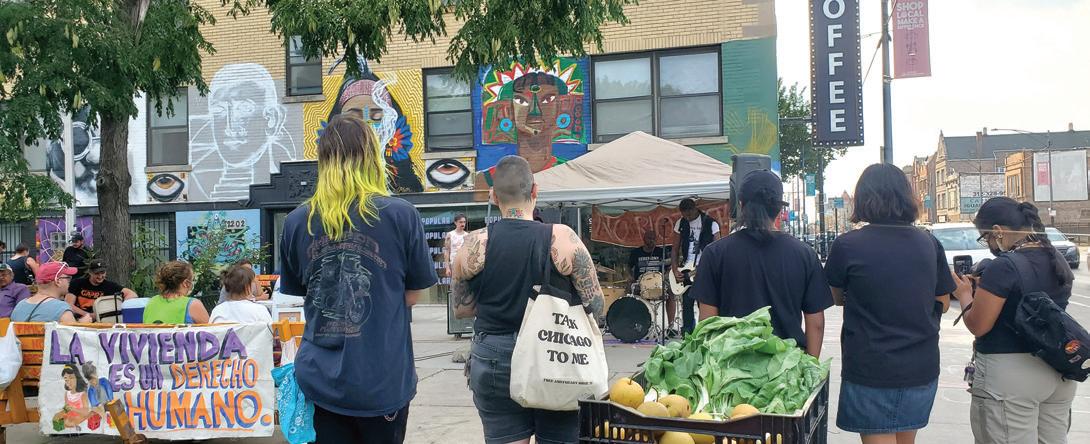
“It’s mostly white people now, and they’re rude and disrespectful,” they said. “They don’t take into consideration the people around the neighborhood in addition to the lack of organization by the festival.”
As day turned to night, the crowd simmered. Many stood attentively, as if waiting for a signal. Others lay peacefully on the grass—dreaming of a better tomorrow.
“Do you have hope?” I asked Jorge Angel.
“Yes,” he said without pausing. “We’re growing in numbers, and I’m confident this will be the last year of Riot Fest.” v
@_KellyGarcia__
14 CHICAGO READER - SEPTEMBER 29, 2022 ll
A crowd looks on as The Breathing Light perform at the People’s Fest.
KELLY GARCIA
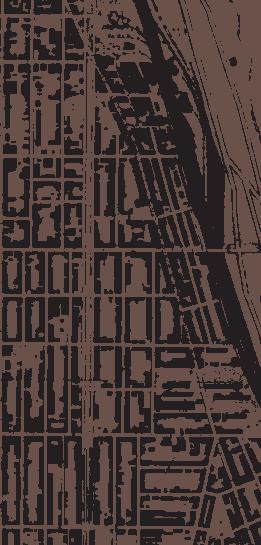















































SEPTEMBER 29, 2022 - CHICAGO READER 15
A changing aldermanic Black caucus
There’s an opportunity for new—and possibly more progressive—Black leaders to take the reins.
By TONIA HILL AND THE TRIIBE
The Chicago Aldermanic Black Caucus (CABC) is changing. So far this year, a total of 15 City Council members have either stepped down, announced plans to retire, or launched campaigns to challenge Mayor Lori Lightfoot in the 2023 mayoral election. And there’s also one alderperson, Patrick Daley Thompson, who was convicted of filing false income tax returns in February; another, Ed Burke, remains under federal indictment.

Of those 15 alderpeople, six are members of the 20-person CABC, a group charged with
“representing the needs and interests of Chicago’s Black communities,” according to its website.
Three Black alderpeople—Carrie Austin (34th Ward), Leslie Hairston (5th Ward), and Howard Brookins (21st Ward)—will retire at the end of their terms. Hairston was elected in 1999 and Brookins in 2003. Austin, elected in 1994, is currently the longest-serving Black alderperson; additionally in 2021, a federal jury indicted Austin and her chief of sta on bribery charges for allegedly conspiring to receive home improvements for construction contractors that sought city assistance for a development project in her ward.
Two Black alderpeople have thrown their
hats into the mayoral race: Sophia King (4th Ward) and Roderick Sawyer (6th Ward). The latter is the son of the late Eugene Sawyer, who was appointed mayor after the sudden death of former Chicago mayor Harold Washington in 1987.
Alderperson Michael Scott Jr. (24th Ward) retired from the City Council in May after serving since 2015. Out of 19 vying for the seat, Lightfoot appointed his sister Monique Scott to take his place.
With Chicago’s municipal election season now in full swing, the aldermanic shakeup comes as self-styled progressive alderpeople appear ascendant in a City Council that is still finding its identity after decades of
lockstep allegiance to machine bosses in the mayor’s o ce.
Such unprecedented shifts could attract young Black Chicagoans—and others disillusioned with politics—to vote in the municipal election, which has experienced low voter turnouts in recent years. But whether that will prompt the CABC to become more independent or progressive as well is yet to be seen.
“If you ask a person, a Black person in particular, what do you think we can do to improve public safety or how do you feel about people in your community having oversight over the police, most people would say that’s a great idea,” said Greg Kelley, president of
16 CHICAGO READER - SEPTEMBER 29, 2022 ll
NEWS & POLITICS
CABC members (from le ) Alderpersons Roderick Sawyer (6th), Sophia King (4th), Leslie Hairston (5th), Carrie Austin (34th), and Howard Brookins Jr. (21st). DAVID ELUTILO FOR THE TRIIBE
This article was co-published in partnership with The TRiiBE.
CITY COUNCIL
SEIU Healthcare Illinois Indiana Missouri & Kansas. SEIU Healthcare is a union representing health care, child care, home care, and nursing home workers in the Midwest.
“That’s a progressive thing,” Kelley added. “But I wouldn’t necessarily call it ‘progressive’ if I were talking to someone like my mother, for example.”
Republicans and right-wing extremists have turned the word “progressive” into a derogatory term, using it as a dog whistle to describe cities with Democratic leaders like Chicago as “lawless.”
The word, Kelley said, can elicit a certain reaction from older Black voters.
“I think we need to do a better job at explaining the issues and relying less on buzzwords like ‘progressive.’ This messaging isn’t reaching certain folks and they may be resistant because they are unfamiliar with the terms,” Kelley said. “So, our job is to communicate the issues without the labels.”
The TRiiBE reached out to Black political experts, City Council members, organizers, and labor leaders to weigh in on what a shift in City Council could mean for Black
Chicagoans.
The consensus from the group is that candidates and leaders must not only be progressive in name, but also in action.
Think back to the administrations of former mayors Richard M. Daley and Rahm Emanuel. During each of those administrations, the CABC voted for controversial initiatives supported by the respective mayors, including Daley’s 75-year parking deal and Emanuel’s closure of half the city’s public mental health clinics and plans for a cop academy.
During Mayor Lightfoot’s first term, the CABC has largely voted in agreement with her 89 percent of the time, according to an analysis conducted by the University of Illinois at Chicago’s political science department.

Those decisions have had long-lasting impacts on Black communities. For example, Black youth organizers with the #NoCopAcademy campaign pushed back against Emanuel’s $95 million cop academy for Chicago police in West Garfield Park because investing more in the police would mean
more violence for Black and Brown communities. Instead, they demanded through their grassroots campaign that the city fund and provide resources for schools and youth.
City Council voted 38-8 in favor of the cop academy in March 2019. In September 2020, Lightfoot’s administration asked for an additional $20 million for phase two of the cop academy, raising the cost for the cop academy to $128 million.
“That was a campaign largely driven by young Black people,” Kennedy Bartley told The TRiiBE. She is one of the lead organizers for the #DefundCPD Campaign and director of campaigns at the Chicago Torture Justice Center, which seeks to address the traumas of police violence and institutionalized racism through access to healing and wellness services, trauma-informed resources, and community connection.
“So, I think as far back as I can remember, but also as recently as the cop academy, as budget votes continue to increase police budgets and fund Black communities and Latinx communities and poor communities at abysmal rates, the Black Caucus has historically
NEWS & POLITICS
taken violent votes,” she added.
The term progressive has become a buzzword in recent years and election cycles—so much so that Lightfoot co-opted the language and concerns of young Black and queer organizers to aid her run for mayor in 2019.
Although the term dates back to the 1900s, according to NPR, the 2016 presidential campaign of U.S. senator Bernie Sanders breathed new life into it. “Progressivism is now a way for politicians to appeal to far left-leaning Americans, without alienating moderates and independents who reject the ‘liberal label,” NPR reported.
In 2019, a slate of progressive candidates joined the City Council. Longtime south-side organizer Jeanette Taylor (20th Ward) won a runo race to succeed former 20th Ward alderperson Willie Cochran. In 2016, a federal grand jury indicted Cochran on charges that he allegedly took money from a charitable fund that was intended to help families and children in his ward, according to the Department of Justice.
Before becoming an alderperson, Taylor served as an organizer with the Kenwood
SEPTEMBER 29, 2022 - CHICAGO READER 17
NEWS & POLITICS
continued from 17
Oakland Community Organization and was a leading organizer with the Obama Community Benefits Agreement (CBA) Coalition.
There’s also BYP100 board member Maria Hadden, who beat longtime 49th Ward incumbent Joe Moore, ending his 28-year career on the City Council. Moore identified as a progressive, but according to a Block Club Chicago article, he voted more than 98 percent of the time with Emanuel.
Not only did Hadden become the fi rst openly queer Black woman elected to Chicago City Council, but she also became the fi rst Black alderperson to be elected to a north side Ward.
And there’s Matt Martin, who was elected to the 47th Ward in 2019. Before joining the City Council, he served as a civil rights attorney in the O ce of the Illinois Attorney General. He focused on issues including police reform, workers’ rights, health care, LGBTQ+ rights, and reproductive rights. He also helped to write the consent decree.
Along with Taylor, Hadden and Martin serve on the CABC and the Chicago City Council Progressive Reform Caucus (CCCPRC).
Then there’s Alderperson Rossana Rodriguez-Sanchez (33rd Ward), a former community organizer who beat incumbent Deb Mell in the 2019 runo . Mell was appointed to the City Council in 2013 to replace her father, who had served on the City Council since 1975. Rodriguez-Sanchez is a member of the CCCPRC and the Chicago City Council Latino Caucus.
Taylor, Rodriguez-Sanchez, and Hadden’s roots in activism have kept them connected to the needs of their constituents.
Recent progressive policies that passed through City Council include the Fight for $15 minimum wage campaign in November 2019, the Woodlawn Housing Preservation Ordinance in September 2020, and the Empowering Communities for Public Safety (ECPS) ordinance in July 2021.
Beginning in 2016, members of the CBA coalition—which Alderperson Taylor had been a part of—came together to protect residents in Woodlawn and neighboring communities from displacement due to the development of the Barack Obama Presidential Center in Jackson Park. Those e orts came to fruition in 2020, when the City Council approved the Woodlawn Housing Preservation Ordinance, which Taylor cosponsored. One of the ordinance’s key features is a requirement that for each redevelopment of 52 vacant city-owned lots, at least 30 percent of new apartments
must be made a ordable to “very low-income households.”
“It’s about the representation that goes beyond the identity of Blackness and represents the class interests and the social interests of Black folks in the city,” Bartley said. “I think it’s about getting organizers into o ce.”
With these new voices in office, Bartley said, then we can fi nd ways to meaningfully challenge the alderpeople who have been in power for years.
“We know that Black voters are loyal voters,” she said. “How are we providing material alternatives to the folks in our communities and neighborhoods and then organizing them to believe in bolder representation?”
For Chicago Teachers Union president Stacy Davis Gates, the mayor is an important part of the equation, too. Since the mayor sits atop the city’s governmental power structure, some alderpeople acquiesce to that power, she said.
“If Black people want to be accommodated in the city, they’re going to have to be accommodated by a progressive mayor because that is the type of mayor who’s going to fully fund schools,” Gates told The TRiiBE. “That is the type of mayor that will go into neighborhoods like Chatham and make sure that it continues to be a place for the working class and the middle class. You need mayors to lead.”
She pointed to the success of Chicago’s first Black mayor, Harold Washington, and the causes he championed and enacted once he took office in 1983. As mayor, he opened the city’s budget process up for public input, fought to redistrict wards which provided more Black and Latinx representation, and created the Ethics Commission to check the power of the city’s administration.
“The greatest amount of transformation for Black people in the city did not come from a Black Caucus,” Gates said. “It came from a Black mayor through a movement of people who wanted more for all people in this city. But it was anchored in the hopes and dreams of the migrants from Mississippi.”
Mayor Lightfoot led a proposal to sue gang members for their assets, despite criticism from the legal community who said the ordinance, if passed, would fail to reduce gun violence and would seize money, property, and other assets from vulnerable people not even alleged to have participated in violence, such as parents, grandparents, and other family members. Six Black alderpeople voted in agreement with her: Jason Ervin
(28th Ward), Derrick Curtis (18th Ward), Greg Mitchell (7th Ward), Emma Mitts (37th Ward), Scott, and Christopher Taliaferro (29th Ward), who serve on the City Council’s public safety committee. Lightfoot delayed a fi nal vote on that ordinance in February.
When Mayor Lightfoot proposed to extend and expand the citywide curfew for youth following the shooting of a 16-year-old teenager in Millennium Park, despite critics saying the measure would disproportionately harm Black and Brown youth, ten CABC members voted in favor of it: Mitchell, Michelle Harris (8th Ward), Curtis, Brookins, Scott, Walter Burnett (27th Ward), Ervin, Taliaferro, Austin, and Mitts.
For politicians, merely identifying as a progressive candidate is not enough. Bartley said the words, actions, and policymaking decisions must match, and voters must demand more and be clear about what they’re asking of their elected representatives.
For Kelley, progressivism, as it relates to politics and legislation, includes policymaking that addresses the needs of everyday working people.
There’s a widely held belief that millennials and Generation Z only mobilize on issues by leading demonstrations or protests. While some applaud their efforts, they are often criticized because they aren’t appearing en masse to vote in elections.
More than 520,000 people voted in the general municipal election in February 2019; of that total, approximately 3.5 percent were between the ages of 18 to 24, 15 percent were between the ages of 25 to 34, and 17 percent were between the ages of 35 to 44.
Overall, voter turnout was 35 percent in the general municipal election and 33 percent for the runo election in April 2019.
TRiiBE contributor Charles Preston wrote a 2019 opinion piece responding to criticism about millennial voter turnout. He noted that organizing and demonstrations led by young Black people did lead to wins for the movement and Chicagoans during the previous municipal election cycle.
“Many activists who stood in front of Lori Lightfoot and Garry McCarthy at past Chicago Police Department Board hearings are now witnessing those very candidates reiterate (some would say co-opt) their talking points! The call for more mental health clinics, an elected school board, and defunding police in favor of more community-based programs is not an original thought by candidates. This is the result of the incredibly penetrating
and revolutionary action by youth,” Preston wrote.
In order to attract new potential voters, lawmakers must have messaging and communication about progressive policies that are digestible for all constituents across ages and backgrounds.
Although Brookins believes there is an opportunity to push Black people further left, he said many Black voters identify as Democrats while still supporting some conservative-leaning policies.
“My elections have shown that African Americans are, by nature, conservative, especially the older African Americans who are the bread-and-butter people that go out and vote,” Brookins told The TRiiBE on September 8.
Earlier that day, Brookins endorsed southide native and community organizer Ronnie Mosley’s campaign to replace him in the 21st Ward. In 2017, Mosley cofounded Homegrown Strategy Group, a policy and organizing fi rm that believes in community power and the idea that achievement comes through collective e ort.
“With that said, there is room for a shift in liberal ideas, especially when it comes to things like policing, which I’ve been at the forefront of,” Brookins continued.
He was one of the sponsors of the reparations ordinance for victims of disgraced Chicago Police Department Commander Jon Burge. The measure was introduced in 2013 and was approved in 2015.
However, Brookins also voted in support of the cop academy in 2019.
“But I still believe there’s a strong contingency of people who believe that we should pull ourselves up by the bootstraps, live a law-and-order-type life, and so forth. But there’s room to gently push people, not necessarily jerk them to the left,” Brookins added.
When candidates claim to be progressive, Bartley said we must ask them about their commitment to issues like affordable housing, mental health, and funding for education. And, once elected, it’s up to constituents to hold them accountable.
“Do you commit to building 100 percent affordable housing in your ward? Do you commit to ‘treatment, not trauma’ in a way that defunds the police? Do you commit to fighting against education cuts?” she said. “It’s about just being sharper in our demands and what we’re requiring.” v
@_ToniaHill
18 CHICAGO READER - SEPTEMBER 29, 2022 ll

SEPTEMBER 29, 2022 - CHICAGO READER 19
Bigger than basketball
The WNBA season is over. Brittney Griner remains in a Russian prison. What’s next?
By MAYA GOLDBERG-SAFIR
The end of the Chicago Sky’s 2022 season came as quick as an end-ofsummer downpour—unexpected, and, for fans, heart-wrenching.
The team had carried a ten-point lead heading into the fourth quarter in a closeout game five against the Connecticut Sun, moments from securing a spot in the WNBA Finals.
I nstead, in a matter of minutes, the defending champions inexplicably crumbled.
T he sold-out crowd inside Wintrust Arena watched agape. A season ending in disaster may be a familiar feeling to many Chicagoans, but not to Sky fans, whose last two seasons have been marked by Candace Parker’s dominant return and a championship culture known across the league. As the seconds wound down, the realization rippled through the crowd, as Chicago’s veteran roster went completely scoreless for the final four minutes and 45 seconds of the game. In section 115, just behind the Sky bench, season ticket holders Crispin
Torres and Kaaren Fehsenfeld felt their stomachs flip.
“ I just kept thinking: what happened?” said Torres, who had been ready to celebrate another Finals berth.
Until those final four minutes, the Sky’s season had been electric.
A fter the team’s 2021 championship run, “you couldn’t talk about women’s basketball without talking about Chicago,” said Sky head coach James Wade. The franchise took on that responsibility with pride.

I n the summer of 2022, the team registered their best record in franchise history and hosted the city’s first-ever WNBA AllStar Game. Chicago—or Skytown, as fans call it—became the center of the women’s basketball world, and, game after game, thousands streamed into Wintrust Arena to watch the defending champs hit the court.
T he Sky’s die-hard fan base is growing, and the culture is distinctive from traditional professional sports. “For a long
time, I’ve felt very quiet about being a sports fan,” Torres said. “But the WNBA just feels so different. As a politically minded person, as a leftist, a queer person, and a trans person, it’s probably the most eclectic and open-minded group of sports fans I’ve ever been a part of.”
T his year’s WNBA season was bigger than basketball itself: it was the year this boldly political and often openly queer fan base was confronted with injustice of a new kind. Long before the first tip-off, through the regular season and playoffs, and even now, WNBA superstar Brittney Griner has been wrongfully detained in Russia, where she’s lived in a prison cell for over 220 days.
For many in the Sky organization, Griner’s detainment is personal. A number of the team’s players have competed alongside Griner, including Courtney Vandersloot and Allie Quigley, who last saw their friend in Russia playing for UMMC
Ekaterinburg. In February, Vandersloot and Quigley returned to Ekaterinburg after traveling abroad during a two-week break from the season. But Griner wasn’t there. Players grew increasingly alarmed as the reality of her detainment set in.
O n March 1, all remaining Americans were evacuated from Russia as its invasion of Ukraine intensified. Later Vandersloot would tell The Athletic magazine, “I can’t even explain the feeling that it was. We were all sick to our stomachs about it. It’s really hard to be there and know that your friend, your teammate, is in a situation like that and you can’t do anything to help her. It’s a continuous feeling.”
A nd so the Chicago Sky—its players, coaches, and front-office staff—kept Griner’s plight front and center throughout the season. “It gave us a perspective of the things that are really important,” said Coach Wade. He said the coaching staff even made the decision to relax rules around when players’ family members could be present.
The franchise also used the WNBA season as a platform for fans to lift up Griner’s name, grieve her absence, and demand her return.
Throughout the Sky’s season at Wintrust Arena, you could feel the collective outcry in support of Griner. On Day 78 of her ordeal—soon after Griner was officially declared by the Biden administration as “wrongfully detained,” a human bargaining chip arrested to leverage concessions from the United States during wartime—that Friday night, when the Sky dropped its first regular season home game in overtime, was also the debut of a floor decal that read “BG, 42” and would remain on the court all season long. On Day 143, the day of the WNBA All-Star Game in Chicago, when every player returned from halftime to honor Griner, every single one wore her jersey. Day 171, after Griner was sentenced to ten years in a Russian prison, fans at the Sky’s at-home win over the Washington Mystics brought T-shirts, pins, and homemade signs
20 CHICAGO READER - SEPTEMBER 29, 2022 ll
NEWS & POLITICS
Coach James Wade (center) diagrams a play with the Chicago Sky during the 2021 season. RANDY BELICE / GETTY
SPORTS
pleading for the return of the basketball superstar.
B eneath Griner’s case is the alarming reality of inequity in professional sports, something Coach Wade pointed out as well. When Griner was wrongfully detained in Russia, she was in the midst of “making the ultimate sacrifice, spending time away from her family in order to provide,” Wade said. The reality remains that, for women’s professional basketball players, there really is no “off-season.” Instead, as of last year, nearly half of the WNBA’s players spent their time “off” playing abroad, earning up to ten times what they do in the United States.
Perhaps the unresolved end to the Sky’s season in Chicago was appropriate, in some way: it forces fans, players, and coaches to grapple with a world bigger than basketball. As Coach Wade said, “We know this isn’t life or death. Griner’s situation gave us the perspective of the things that are really important.”
O n September 16, President Biden met with Cherelle Griner, reportedly giving her insight into what the White House is doing to bring her wife home. This kind of public display of assurance is somewhat unprecedented in wrongful detainment cases. And it may encourage families of the other more than 70 Americans wrongfully detained abroad to speak louder with renewed hope.
Whereas the government has long urged wrongful detainment families to keep their loved ones’ story out of the public eye, Griner’s case helps to push in an opposite direction. Alongside efforts like the Bring
Our Families Home Campaign, organized by the families of people wrongfully detained overseas, Griner’s case shows that making noise may in fact be a powerful force to help bring Americans home.
In that sense, Griner is now a game changer for the issue of wrongful detainment.
“She has literally elevated the issue more in the past six months than anyone in the history of the issue,” said Jonathan Franks, a wrongful detainment expert who has been part of several successful negotiations to bring detainees home. “And she hasn’t even gotten to speak for herself yet. Imagine what she’ll do once she has her voice.”
When the Sky lost in catastrophic fashion on September 8, ending their season, it was Day 203 of Griner’s detainment. When the buzzer sound-
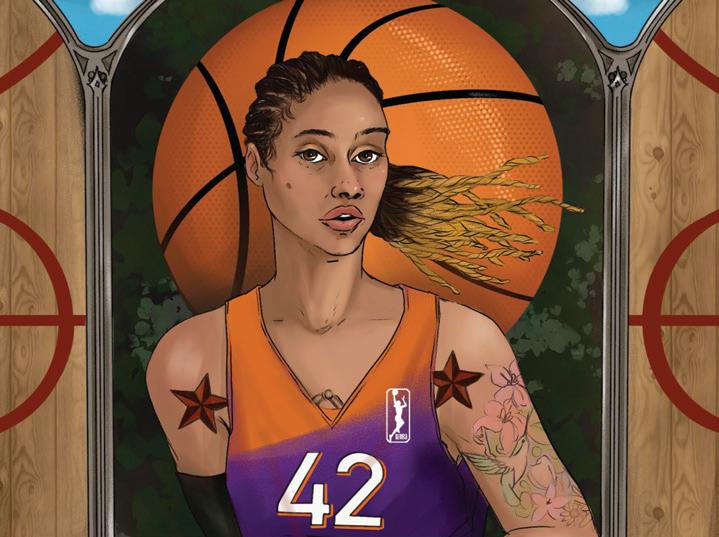
ed, players and fans walked dejectedly from the court, but I couldn’t quite digest or make sense of this being the end: not for the Sky, nor for Chicago fans’ support of Brittney Griner.
So I decided to fly to Las Vegas for a Skyless WNBA Finals and a last chance to grapple with the unknown.
I arrived in Vegas for game two between the Las Vegas Aces and the Connecticut Sun. Throughout the season, the Aces had snatched a few close games from Chicago, but now, I hoped to see them dominate the Sun. I wanted catharsis, at least on the basketball court.
Mandalay Bay Resort and Casino, where the Aces play, is a world away from Wintrust Arena. To get to Michelob Ultra Arena within the casino, you must first cross a dizzying floor of slot machines, fine dining restaurants, and frozen slushie bars. Inside the arena, I scoured the crowds for a flash of Sky blue or a Candace Parker jersey, but there were none to be found. Instead, I bought an Aces T-shirt (all A’ja Wilson shirts were sold-out, of course, after she was announced as the league’s MVP a week before) and sat undercover next to a group of season ticket holders.
The Aces had no mercy for the Sun, keeping them muffled throughout the game.
Unlike the Chicago Sky, a team whose roster was built around the steadiness of its veterans, the Aces are a young team, an emergent force. They played with ferocious athleticism and a single-minded determination to bring the first-ever professional sports championship home to Vegas. And the crowd was ecstatic, absorbed in a show of smoke machines, a pyrotechnic display, and a halftime performance by Lil Jon.
At the final buzzer marking the Aces’ win, the crowd screamed, and I screamed with them. It was an important reminder that, as a sports fan, every disappointing loss is followed by the potential for revival. A few days later, I spoke to Coach Wade, who echoed a similar sentiment: “The last game was very tough for me personally,” he said. “It’s hard for me to describe because I just want to make the fans happy. I know they’re ride or die for us.”
The Sky’s story is one of a powerful turnaround from years of low attendance to sold-out crowds. The coaching staff knows it, too. As the seconds dwindled down in that final game, Coach Wade and his staff turned to the crowd, thanking them. “As we were walking off the floor, they’re cheering us even though we lost one of the most disappointing games,” Wade said. “And they just cheered us like we were winners in their
eyes. And that says a lot to me about the fans in Chicago.”
A fter the game in Vegas, amidst the stream of Aces fans, I ran into someone wearing a “Free Brittney Griner Now” pin, one of the very pins I had helped to pass out during All-Star Weekend.
“You were at the All-Star game in Chicago!” I said.
“ Yes,” the woman said, “how did you know?”
“I helped to pass out those pins,” I told her. “My friend Jade made them.”
“I wear it all the time,” she said. “I wear it to every single game.”
O ur brief conversation reminded me of how effortlessly WNBA fans had come together around Brittney Griner. More than anything else, the season will be remembered for this: “It was the BG year,” as Sky fan Crispin Torres told me. “More than anything else, I think when people look back at this season, that’s what they will remember.”
Back home after my quick trip to Vegas, I watched one last WNBA game in Chicago. For game four of the finals, I searched for a local sports bar willing to play the game with sound. I was nervous, a feeling I’m all too familiar with from years of being a WNBA fan in public. But far more quickly than I’d expected, a bartender at a Logan Square watering hole checked with their manager, then agreed. He was happy to play the game on the patio, sound on.
And so we descended upon the bar, ten or so Sky fans in total: my partner and I, along with Torres, Fehsenfeld, Skyhook Podcast co-host Chris Pennant, and a group of people who’d also called the very same bar asking if they too could watch the WNBA finals. Our city is now home to the kind of WNBA community that many of us have been waiting nearly a lifetime to be part of.
Chicago Sky basketball is a success story, and it’s here to stay. But Brittney Griner is not yet home. Until she’s free, the women’s basketball community will keep wearing their “Free BG” merch everywhere. And we’ll continue to count the days, demand action, and hold governments accountable.
“This is bigger than basketball,” affirmed Coach Wade. “We can’t let the message fall on deaf ears because our basketball season is over.” v
@mayags
SEPTEMBER 29, 2022 - CHICAGO READER 21 NEWS & POLITICS
Brittney Griner has been detained in Russia for more than 220 days.
HALEY TWEEDELL
“DARK TESTAMENT: A CENTURY OF BLACK WRITERS ON JUSTICE”
Through 9/23 : Thu-Mon 10 AM- 5 PM, American Writers Museum, 180 N. Michigan, 312 374 -8790, americanwritersmuseum.org, $14 adults, $9 seniors and students
HISTORY
Writers on the wall
A new exhibit at the American Writers Museum features prominent and lesser-known Black authors, poets, and journalists.
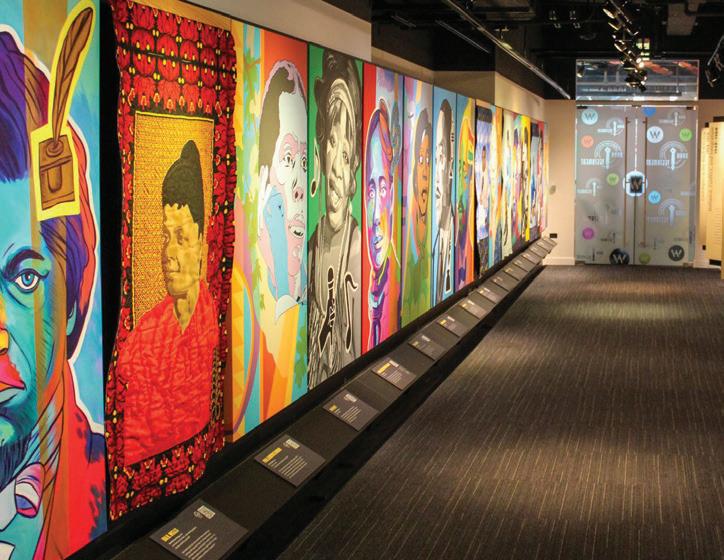 By DEBBIE-MARIE BROWN
By DEBBIE-MARIE BROWN
The American Writers Museum’s newest exhibit, “Dark Testament: A Century of Black Writers on Justice,” is named after a book of poems by Pauli Murray, a writer, lawyer, activist, priest, and professor. While Murray inspired people like Chief Justice Thurgood Marshall (he called her work “the Bible” of the civil rights movement) and Justice Ruth Bader Ginsburgand Justice Ruth Bader Ginsburg, who drew on Murray’s work for her legal brief, she is largely unknown by the public. (Murray was LGBTQ+ and wrote extensively about gender and sexuality, and used she/her pronouns to describe herself.)
“Her work has been crucial, but it’s often been invisible,” said Dr. Keidrick Roy, the exhibit’s lead curator. Roy spent the last five years getting a PhD at Harvard, studying how
African Americans have taken up the ideals of American liberty, progress, and justice in their writings since the nation’s revolutionary era of the 1700s. “And so in this exhibition,” Roy continued, “it’s only fitting to prominently feature Murray and her life and her work as an organizing theme, to help us pay attention to the things that we observe but we don’t really see.”
Dark Testament is an immersive experience that has been two years in the making. It opened to the public on September 22 at the American Writers Museum (AWM) downtown and explores racial injustice from the Civil War through the Civil Rights movement from the perspective of Black writers such as Octavia E. Butler, Ida B. Wells, Ethel Payne, Lorraine Hansberry, and Ann Petry, among many others. At the project’s start,
the curation team—made of writers, journalists, academics, and poets—had a series of conversations with a variety of African American scholars in Black studies, which expanded the aim and reach of that project, birthing its four central organizing themes: Citizen, Justice, Violence, and Joy. “This project has been a dream come true,” Roy said.
The presentation stretches across three of the museum’s gallery spaces. When visitors enter, they fi rst step into the Meijer Gallery, where they’ll fi nd on the right a chronicle of major Black American writers, with physical copies of influential works highlighted from each phase. The works What to the Slave is the Fourth of July?, written in 1852 by Frederick Douglass, and Incidents in the Life of a Slave Girl, written in 1861 by Harriet Jacobs, represents the period from 1850-1865 entitled “Slavery and Freedom,” for example. Ida B. Wells’s The Red Record: Tabulated Statistics and Alleged Causes of Lynching in the United States represented the era between Reconstruction and Jim Crow (1865-1919). Invisible Man (1952) by Ralph Ellison is highlighted in the section on the years 1940-1960, a period defi ned by international confl ict and integration.
Across from those mounted texts, 16 brilliantly colored five-foot-tall portraits are installed side by side, fi lling up the entire width of the gallery’s wall. Visitors can interact with the art using an augmented-reality app on their phones. Large multicolored portraits depicting the likes of Ma Rainey, Douglass, Wells, and James Baldwin are painted or quilted in various complementing styles by local artists, many of whom are associated with the Chicago Public Art Group.
One of the painters, Bernard Williams, oversaw the completion of the 16 portraits and said that he commissioned artists— Damon Reed, Dorothy Irene Burge, and Dorian Sylvain, and himself—that he thought would “do well with creating dynamic portraits,” as the painters have experience creating outdoor murals in Chicago and painting portraits. Dorothy Burge is the only fabric artist among the group.
In a section of the Conant Readers hall, a larger exhibition room, there’s a component that examines the significance of the
Black press, Black newspapers, and Black publishers. “Black press has been central to the distribution of Black thought since its founding,” Kiedrick said, since writers like Langston Hughes and W.E.B. Du Bois used the Black press as a mechanism to distribute their ideas. He noted that the Black press increased the capacity for transmission of ideas within Chicago but also across the country, connecting Black people in di erent regions of the country who wouldn’t have interacted otherwise.
“You have people in the south reading the Chicago Defender for instance, and that encouraged aspects of the Great Migration,” Roy said.“The Black press provided a space for Black leaders to emerge in a variety of capacities, and to have a public facing national voice that Black folks paid attention to.”
Myiti Sengstacke-Rice is the fifth generation of publishers in her family. Her great-granduncle was Robert Sengstacke Abbott, the founding publisher of the Chicago Defender and inventor of the Bud Billiken Parade, and her grandfather was a publisher of the Defender as well. Her father is renowned photographer Bobby Sengstacke. She donated a walking cane, a camera, and countless photos from her late family members to the exhibit.
“Writers are really clamoring for great spaces to be able to express what they’re seeing out there in the world. And you know, they need good platforms for that,” Sengstacke-Rice said.
The last part of the exhibit is in the Rubin Writers Room, where an intimate video presentation shows contemporary writers discussing the resonance of works from the past. Meanwhile, actors from Congo Square Theatre Company act out quotes from each text on screen.
The museum considers this their most ambitious presentation to date.
“The larger movements have a lot of different Black intellectuals, writers, men and women alike, who were really thinking deeply about the American Enlightenment ideals upon which the nation was founded,” Roy said. “And they should be celebrated as philosophers.”
@debbiemarieb_
22 CHICAGO READER - SEPTEMBER 29, 2022 ll
v
NEWS & POLITICS
Sixteen portraits of Black writers fi ll one wall of the exhibit, which stretches across three gallery spaces. COURTESY AMERICAN WRITERS MUSEUM
BY REBECCA GILMAN DIRECTED BY ROBERT FALLS











SEPTEMBER 29, 2022 - CHICAGO READER 23 GoodmanTheatre.org 312.443.3800 Groups 10+: Groups@GoodmanTheatre.org
Illustration by Carolina Lopez Corominas
It’s hard to know who your friends are in a world that’s more divided than ever. Recently widowed, Peg tends to the native plants in her 40-acre rural Wisconsin prairie backyard, her solitary days interrupted only by visits from a family friend with a checkered past. When a mysterious theft alerts the authorities, a string of events unfold that forever changes their lives. Pulitzer Prize finalist playwright Rebecca Gilman and her longtime collaborator, Tony Award-winning director Robert Falls, team up again for their sixth Goodman production—a contemporary portrait of America’s heartland in a time when it feels like everyone’s way of life is in danger of disappearing. OCTOBER 7 – NOVEMBER 13 New Play AwardProduction Support THE ELIZABETH F. CHENEY FOUNDATION Principal Support 2022/23 GRAND BENEFACTORSPRODUCTION SPONSORS 2022/23 BENEFACTORS By Eve L. Ewing Adapted by J. Nicole Brooks Directed by Gabrielle Randle-Bent and Tasia A. Jones OCTOBER 04 - OCTOBER 29 A SEARING AND LUMINOUS CHICAGO STORY, ADAPTED FROM EVE L. EWING’S ACCLAIMED POETRY Tickets start at just $20, only $5 for students! steppenwolf.org | 312-335-1650
ARTS & CULTURE
GALLERIES
Drawing on the past
William Horberg’s art evokes memories of a Chicago gone by.
 By DMITRY SAMAROV
By DMITRY SAMAROV
Most people are lucky to have one act that hits. William Horberg is well into his third. Horberg was born in Chicago and grew up around Belmont and Broadway in the Lakeview neighborhood in the 60s and 70s. He ran a repertory movie theater called the Sandburg at the corner of Division and Dearborn from 1979 to 1981, then moved out to Hollywood. He went on to a storied career producing films like A Rage in Harlem, The Talented Mr. Ripley , and Milk, as well as TV shows like The Queen’s Gambit . Now he has turned to drawing as a way to explore the places of his childhood that left an indelible mark on him, to fix them in a lasting way as memories fade and bulldozers bury a past that informed everything he was to become.
There’s something about drawing—no matter the artist’s skill level—that can communicate people and places more intimately than any photograph. Evidence of human
touch brings an intimacy no machine could ever replicate. When I look at Horberg’s penand-marker depictions of the landmarks of his childhood, I feel my way through those streets palpably in ways a frozen black-and-white print can never approach. It doesn’t hurt that I know many of these places from firsthand experience, but Horberg’s versions are from decades before I got to Chicago; some from before I was born. Yet I feel links to those bygone days in these vibrant and likable pictures.
Memory plays a starring role. Decades removed from his subject matter, Horberg has used family photos and period snapshots to get the details of the architecture right. There are certain things that are impossible to render without visual source material, whether perceptual or photographic—you just can’t make them up. The particularity of a cornice or how a street sign might have a typo or some other unique irregularity—these are aspects
that make Horberg’s drawings distinctive. And yet, as a longtime Chicago resident, I can see the armature or skeleton of the city I know behind these long gone facades. No matter how many of these buildings have been demolished or how many businesses have succeeded ones that failed, something of the spirit of these blocks remains right where it’s always been.
Horberg’s depictions of neighborhoods like Old Town may not look instantly familiar to younger residents but they’ll surely recognize something like Crate & Barrel, which began as a small storefront on Wells Street before ballooning into a home furnishings brand. His drawing of Kroch’s & Brentano’s bookstore on Wabash in the Loop instantly took me back to the early 90s when I was a student at the School of the Art Institute of Chicago. Coincidentally, the caption accompanying this drawing recounts a childhood incident of getting busted shoplifting with his friends. I had a
White Privilege by William Horberg COURTESY THE ARTIST
run-in with a Kroch’s store detective myself a couple decades after Horberg. When I recount this to him via email, he’s happy to hear I was continuing his traditions.
Nostalgia for the people and places of childhood is a side e ect of aging. The further we are from formative early locales and friendships in our lives, the more it feels like they’re gone forever—and that whatever has taken their place is lesser or lacking. Had Horberg not left town in 1987 his depictions of Chicago would undoubtedly be very different. Revisiting geography through the mind’s eye is almost the opposite of walking the same streets for decades on end and noticing incremental changes. I don’t mean this as a criticism of Horberg’s project but to note the specific slant of his approach. He names his exhibit “My Old Town.” It is a place preserved in amber.
This series was largely completed during the plague lockdown, a time when many artists looked inward by necessity and circumstance. If you can’t go outside you must find subject matter elsewhere. One’s past can be a deep well to draw from but holds its share of pitfalls and false paths. Fortunately for Horberg and for us, his looking back has produced images that teem with life even as they mourn what’s gone.
When I first looked through this body of work I was reminded of the drawings of the late Wesley Willis. Horberg also relies on rulered perspectival lines to depict urban vistas and a colorful marker palette. Unlike a Willis, a typical Horberg drawing features at least one person, often a close friend or loved one. These images are as much a tribute to those who have come and gone as the burger stands and movie theaters that formed Horberg’s identity.
By rooting his compositions in recognizable blocks of our city, the artist allows any viewer who’s logged time in Chicago to feel a connection. Whether he’s depicting the Hotel Belmont, the Bahá’í Temple, the Jazz Record Mart, or just a humble row of brick apartment buildings, Horberg’s Chicago is our Chicago as well. It’s a place where past and present are in a constant state of flux, a lively, often fraught state of constant renegotiation and debate. I know it better from looking at these drawings.
@Chicago_Reader
24 CHICAGO READER - SEPTEMBER 29, 2022 ll
“MY OLD TOWN: GROWING UP IN CHICAGO 1959-1986” Through 10/22 : Tue-Fri 10 AM- 6 PM, Sat 10 AM- 5 PM, Sun by appointment, Firecat Projects, 2019 N. Damen, 207 249 9486, firecatprojects.org
v







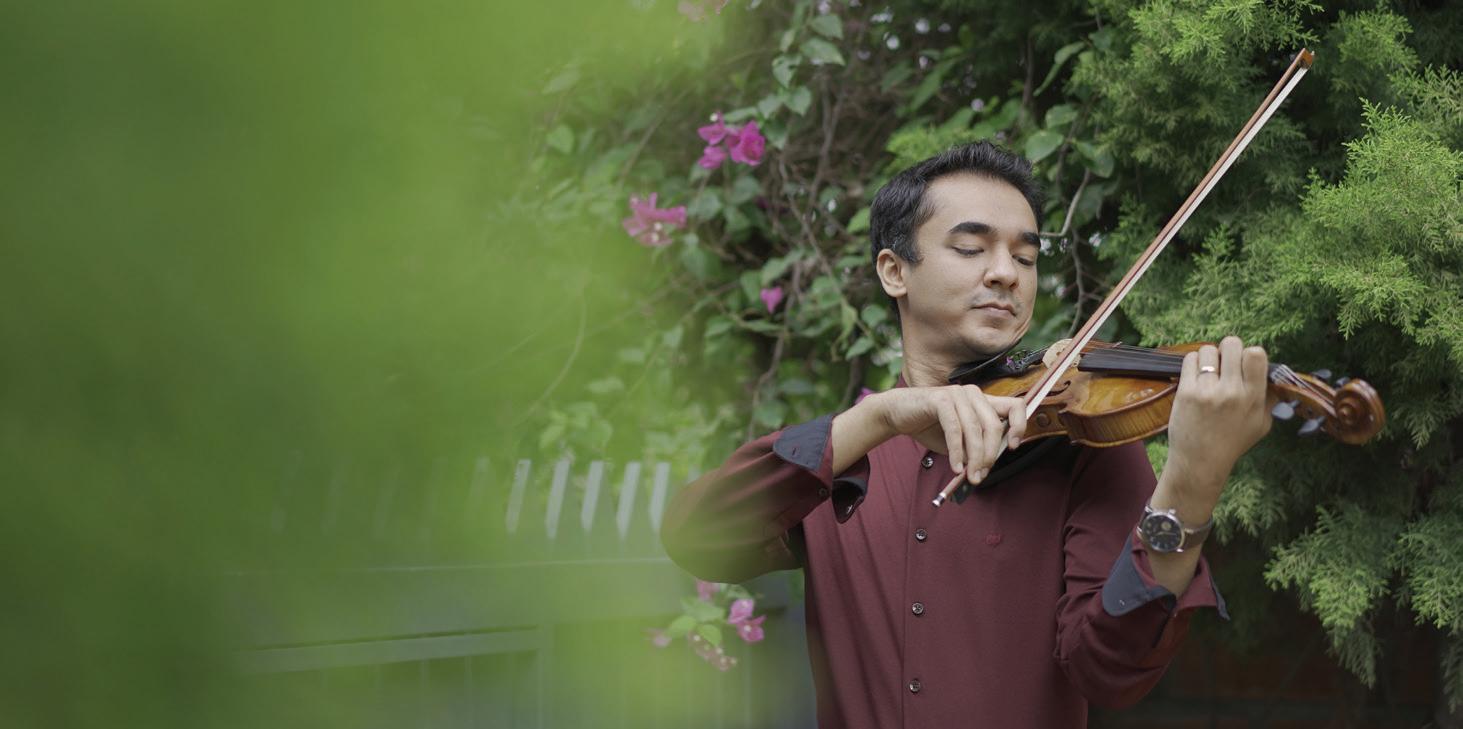


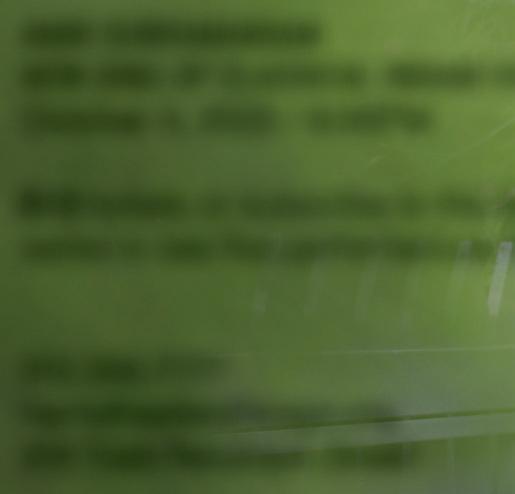






SEPTEMBER 29, 2022 - CHICAGO READER 25 SEASON SPONSOR 847-242-6000 I WRITERSTHEATRE.ORG FIVE WEEK RUN ONLY! SEPTEMBER 29 - OCTOBER 30 TICKETS ON SALE NOW: A critically acclaimed comedy about belonging, succeeding—and who we blame when we fail. PICTURED: DEANNA MYERS AND AURORA ADACHI-WINTER. PHOTO BY SAVERIO TRUGLIA. HARRIS THEATER PRESENTS 22/23 MIX AT SIX AMBI SUBRAMANIAM NEW KING OF CLASSICAL INDIAN VIOLIN October 4, 2022 / 6:00PM $15 tickets or subscribe to the Mix at Six series to see five performances for $50. 312.334.7777 harristheaterchicago.org 205 East Randolph Street Chauncey and Marion D. McCormick Family Foundation, Abby McCormick O’Neil and D. Carroll Joynes Mix at Six Series Presenting Sponsor Mix at Six Series Media Sponsor Anonymous Performance and Community Engagement Sponsor
“TAKING SHAPE: ABSTRACTION FROM THE ARAB WORLD, 1950S-1980S”
Through 12/4: the Block Museum, 40 Arts Circle Dr., Evanston, 847 491 4000, blockmuseum.northwestern.edu

MUSEUMS
Abstraction and meaning
A survey of work from MENA region artists visits Evanston’s Block Museum.
By DMITRY SAMAROV
t’s rare for me to be surprised by a painting show, but I didn’t see “Taking Shape” coming. The exhibition is a generous survey of abstract art made from the 1950s to the 1980s, drawn from the collection of the Barjeel Art Foundation based in Sharjah in the United Arab Emirates. “Taking Shape” includes the work of over 50 artists, representing more than a dozen countries throughout the Middle East and North African (MENA) region. Some of the artists have had successful art careers, but none enjoys name recognition in America like Pollock or Kandinsky. I know of few prior attempts to take a snapshot of nonfigurative
art from midcentury MENA artists.

In many parts of the world, art has traditionally been employed to illuminate faith or governmental sovereignty. That’s not to say that Malevichs weren’t used to promote the Soviet state or that de Koonings weren’t employed as propaganda for the U.S., because they were, but that wasn’t always the intent of either of those artists. The idea that an artist’s work is solely an expression of their own feelings or ideas, apart from the society they belong to, wasn’t common or accepted in the countries represented in this show.
Much of the difficulty in contextualizing
Explore mysterious portals to the unknown.
Michiko Itatani has grappled with the mysteries of the universe in her work throughout her prolific career. This exhibition of 50 works celebrates the Chicago-based, American artist’s determination to “know the unknown.” Spanning two floors and myriad decades, the exhibition includes breathtaking, never-before-seen works
OPENS SATURDAY!
2022 wrightwood659.org
ll ARTS & CULTURE
SUPPORT FOR THESE EXHIBITIONS IS PROVIDED BY ALPHAWOOD FOUNDATION CHICAGO IMAGE CREDITS:“Cosmic Returning” painting from Quantum Chandelier 21-D-02 Michiko Itatani, 2021, 78” x 96,” oil on canvas, courtesy of Michiko Itatani (Detail)
OCT 1 – DEC 17,
CHICAGO
WRIGHTWOOD
ARTS & CULTURE
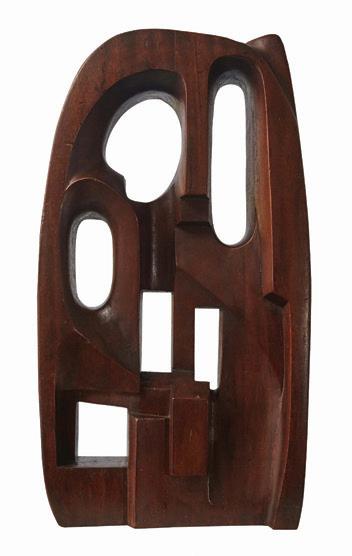
these paintings is the very di erent political situations in each artist’s home country. A succession of upheavals, from colonial subjugation to experiments in socialism and democracy, to lapses into theocratic rule, are the experiences under which this work evolved. In the bios of most painters included in the show, there’s time spent at art school or travel to Europe or the U.S. early in their development. Whatever the impact or influence of this foreign approach, it seems each artist spent the rest of their career reconciling it to their own native traditions.
Walking through the galleries I spotted echoes of abstract expressionism, color field painting, suprematism, and other recognizable Western styles, but the closer I looked the less familiar they became. An amazing thing happens when a person picks up a brush: even if they’re trying their best to imitate something they admire, their own unique signature is spelled out all over the canvas. No two people can ever paint a picture the same way.
brushed evocation of Arabic letterform set on a cracked blue background. Shakir Hassan Al Said’s 1983 work Al-Muntassirun (The Victorious) reminds me of a scu ed-up and gra tied city wall. Huguette Caland’s Bribes de Corps (1971) is a playful ri on a favorite part of the human anatomy, and Etel Adnan’s Autumn in Yosemite Valley (1964) is a quilt-like composition that suggests both leaves and landscape. When I go back to see the show next time, I know I’ll find half a dozen other favorites. Each wall of the show had paintings that made me stop and linger.
Abstract art’s greatest strength is also its fatal flaw. Because there’s nothing in a nonobjective picture that can be conclusively defined as meaning one thing rather than another, it can be used to stand for whatever one would like it to. That’s how a Pollock drip painting can represent breaking free from the bonds of European easel painting and be used to fight the perceived atheistic threat posed by the Soviet Union during the Cold War at the same time. An added wrinkle in this case is the influence of traditional Islamic law, which
hand, believing images to be the province of the divine. I doubt every artist included painted their canvases for the glory of God, but their abstract form allows for such an interpretation.
Gathered together by Sultan Sooud al Qassemi in the UAE and sent on a tour through the U.S., I assume there’s some diplomatic intent to this exhibition, but thanks to the nonfi gurative styles represented that intent can’t be spelled out and cannot diminish the quality of the art on its own terms. Paintings, books, music, and other cultural products are often used as a kind of soft power, to exert influence on behalf of those that commissioned or otherwise made them possible. Whatever the Barjeel Art Foundation’s purpose, the result is a revelatory introduction to a body of work few in the West will be familiar with. The uncanny impression I left with was of spending time with pictures I didn’t know I knew. Like seeing a foreign landscape or a stranger’s face and recognizing it all the same. v
@Chicago_Reader
GLOBAL DEPICTIONS OF A NEW IDENTITY
A revealing look at same-sex desire.
The word “homosexual” was coined in Europe in 1869—unleashing stunning depictions of same-sex desire in the visual arts world. Discover how artists across five continents expressed queer identity in this pioneering survey of paintings, drawings, prints, photographs, film clips, and many national treasures—from public and private collections around the globe.
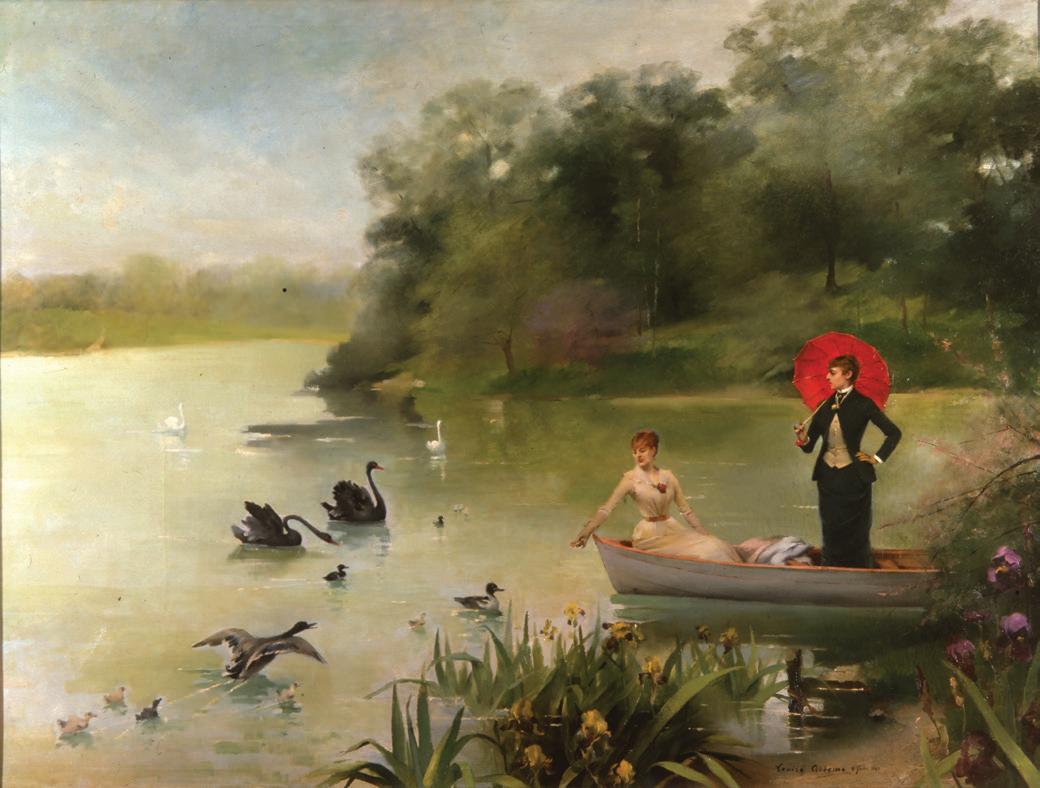
SEPTEMBER 29, 2022 - CHICAGO READER 27
Highlights include Hamed Abdalla’s 1975
SUPPORT FOR THESE EXHIBITIONS IS PROVIDED BY ALPHAWOOD FOUNDATION CHICAGO IMAGE CREDITS: Louise Abbéma (1853 — 1927, France), Sarah Bernhardt et Louise Abbéma sur le lac au bois de Boulogne 1883, Oil on canvas, 160 x 210 x 3 cm (framed), Collections Comédie-Française. (Detail)
OPENS SATURDAY! OCT 1 – DEC 17, 2022 wrightwood659.org THE FIRST 1869-1930
CHICAGO
WRIGHTWOOD
PLEASE
NOTE: The First Homosexuals
contains
sexually explicit content. For mature
audiences
only.
Interform , a wood sculpture by Lebanese artist Saloua Raouda Choucair COURTESY THE BLOCK MUSEUM
































ll SOMETHING READER FOR EVERYONE! store.chicagoreader.com EARLY WARNINGS Chicago s essential months ahead music calendar EVENT CALENDER Chicago Community vents Calendar Comprehensive event listings from a wide variety of event organizers—including Reader readers. Clic romote your event elow to su mit event listings.
THEATER
Marcela Torres ERICK WILCZYNSKI
PERFORMANCE
Venerable tobacco smoke
Marcela Torres blends historical dances in an exploration of crop cultivation and colonialism.
By KERRY CARDOZA
Any smoker can relate to the feeling of release they get from a cigarette, the satisfying blend of calm relief and buzzy energy. When artist Marcela Torres started smoking cigars about seven years ago, they were struck by the respite it o ered. So began a relationship with tobacco, which has stretched to include its historical connection to colonization and Latin America, its cultivation, and use in ritual, all of which manifest in Torres’ new choreographic work, Iyapokatzin; the venerable tobacco smoke.
“Sometimes an ancestor will call to you, and by ancestor I mean a plant, or an object, or a spirit,” Torres says. “Then when I researched more, I realized how tied it was to political movements or to colonization or to culture or like all these different parts of Latinidad that I just thought were really interesting. So I began to dive in further and further. In different voodoo or other spiritual beliefs, when you find an ancestor spirit, it’s a call to get to know that entity in all these different ways.
It’s research but also getting to know the thing itself through other folks or other histories or other communities.”
The Chicago premiere of Iyapokatzin, which is Nahuatl for “venerable tobacco smoke,” will take place at El Paseo Community Garden in Pilsen on October 1, with a second presentation the following day at Malinalli Garden in Little Village. (An earlier performance was staged in September at Minnesota’s Franconia Sculpture Park.) The 45-minute piece is less a dance than a ceremony or o ering “both to ancestors but also to the public,” Torres says.
Iyapokatzin is the culmination of three years of research into not only tobacco itself, but also into how to properly tell its story, and how to integrate its history into movement and community and Latine diaspora. Its completion, in the ways the artist envisioned, was made possible through the support of Chicago DanceMakers Forum, where Torres is a 2022 Lab Artist.
Torres typically works slowly, learning all
they can about a subject, and physically practicing it. Over that research period, Torres grew tobacco at El Paseo and built an adobe monument meant for burning the harvested plant and communally releasing grief. They also learned two di erent types of historical dances: Azteca-Chichimeca, from Chicago native Izayo Mazehualli, and Folklórico, from Texas-based Gabriela Mendoza-Garcia. Mazehualli will also be performing in Iyapokatzin.
“It’s really important to have a community base,” Torres says. Their collaborators also include La Spacer, a local DJ, producer, and composer who created a score for the performance that incorporates both techno beats and Son jarocho, a style of folk music from Veracruz, Mexico.
“They were important to me, to have somebody who wasn’t going to judge me for being queer in a way, because often these dances can be very binary and controlled,” Torres says. “I’m more comfortable in feeling nonbinary, like not wanting to fulfill certain masculine or feminine roles.”
Torres’s desire to translate these dances in a nonbinary way also comes through in their attire, a flowing black assemblage that pays homage to their goth, clubby teenage years and to the ranchero style of Folklórico dress. “A lot of the Folklórico outfits haven’t changed in a long time, but I wanted to make something that felt more related to my life,” Torres says.
IYAPOKATZIN; THE VENERABLE TOBACCO SMOKE
Sat 10/16: 30 PM, El Paseo Community Garden, 944 W. 21st; Sun 10/26: 30 PM, Malinalli Garden, 2800 S. Ridgeway, free
“A lot of aesthetics are related to both honoring the pantheon of Aztec gods and also thinking about how the Folklórico outfit can actually make sense to me now.”
Being able to work with people who understood Torres’s diasporic story was crucial—it helped them feel more comfortable in taking traditional movements and making them more contemporary, more relevant to Torres’s life.
“Some forms of Mexican dance can feel really static, both accessible and yet not accessible,” Torres says. “A lot of dance forms are controlled, partially for real reasons—they

want to keep them preserved. But when we think about Folklórico, a lot of those dances aren’t that old.” After the Mexican Revolution, which ended in 1920, Torres explains, there was a period of cultural reform, where the bourgeoisie made decisions regarding what cultural practices would be chosen to represent what Mexico was. “They decided the dances and they decided all the costuming,” Torres says. “It wasn’t necessarily the people themselves. The goal was to unify what Mexico was after the war. So it’s interesting that there can be such rigidity on what it’s considered when it was really just a decision of a few people and often not Indigenous people. My goal is for people to see these dance forms as contemporary options for play in the descriptions of our current lives.”
In some ancient stories, tobacco was seen as a healer, a spiritual protector. This idea of protection is one that resonates with Torres, who has trained in martial arts. That training is evident in the performance, in moments where the artist bobs and weaves, or thrusts out an arm or a leg as if in combat. “A lot of the things I’ve been interested in in my practice have to do with personal journeys or knowing self or finding strength,” they say. “This work is not so much a departure, it’s actually really similar.”
Torres says a lot of the movements of Muay Thai, Azteca-Chichimeca, and Folklórico are similar, with a lot of time spent on one’s toes. “You can do everything you want to feel strength, but if you don’t know where home is or your ancestry or your relations, it might not ever feel like safety,” Torres says. “I have the physical strength, but as far as feeling some wholeness with an idea of the spiritual self— that was what I think was missing.” Deepening their relationship with tobacco, and learning its history and connection to Latinidad, has helped bridge that gap.
Though Torres also works in sculpture, ceramics, and other mediums, performance remains their preferred art form. “Through performance, we have a relationship with the body and we have a relationship with a location and other people. Through that, there’s always the quest to figure out what space or objects or movement interact to create this physical, emotional experience,” they say.
“Sometimes I don’t totally understand why I’m making . . . but I feel like they’re all connected to this desire to know the earth or know oneself through the earth.” v
@booksnotboys
SEPTEMBER 29, 2022 - CHICAGO READER 29
R READER RECOMMENDED b ALL AGES F
REVIEW
Stranger thingsEnough to Let the Light In gives a thriller twist to a couple’s secrets.
By EMILY MCCLANATHAN
What if the person you love—the one you want to spend the rest of your life with—were to confess a secret so bizarre, so disturbing, that it makes you question whether you know them at all? How do you truly accept every part of a person when you can’t begin to understand one of their most deeply held beliefs?
Such questions are at the heart of Enough to Let the Light In, a world premiere psychological thriller by Mexican American playwright Paloma Nozicka, produced by Teatro Vista and copresented at Steppenwolf’s 1700 Theater. Director Georgette Verdin and the two costars skillfully balance suspenseful staging, complete with some hair-raising jump scares, and the raw emotions of a relationship under immense strain.
Melissa DuPrey (Dr. Sara Ortiz on ABC’s Grey’s Anatomy ) and Lisandra Tena (Lola Guerrero on AMC’s Fear the Walking Dead ) play Marc and Cynthia, two women who have been together for only eight months but are ready to commit to each other for good. Marc has a successful therapy practice, and Cynthia
is an artist who used to paint professionally but now works in retail at an art supply store. On the night when we meet the two lovers, Cynthia invites Marc to stay over at her house for the first time. Indeed, she has never even let her partner set foot past her front door— an early revelation that immediately raises questions, given the evident intimacy between the two.
The show maintains a lighthearted tone at first as Marc and Cynthia settle in for a happy evening together. DuPrey and Tena share a playful, sweet chemistry, but their lively banter is soon underscored by foreboding hints at what’s ahead. Cynthia acts strangely territorial about a certain closet door, insisting that Marc hang her coat elsewhere and that the door remain slightly ajar, laughing off these demands by saying she’s a bit OCD.
We also glimpse another odd habit of Cynthia’s: pouring out a bowl of dry cereal and leaving it in the living room. Later, when Cynthia is alone in the room, she whispers a spine-chilling question, “Are you there?” into the dark closet. The house itself seems as
R ENOUGH TO LET THE LIGHT IN
Through 10/23 : Thu-Fri 8 PM, Sat 3 and 8 PM, Sun 3 PM, Steppenwolf 1700 Theater, 1700 N. Halsted, 312 335 1650, steppenwolf.org, $25 -$ 45. Presented as part of the fifth annual Destinos: Chicago International Latino Theater Festival; see clata.org or destinosfest.org for festival schedule.
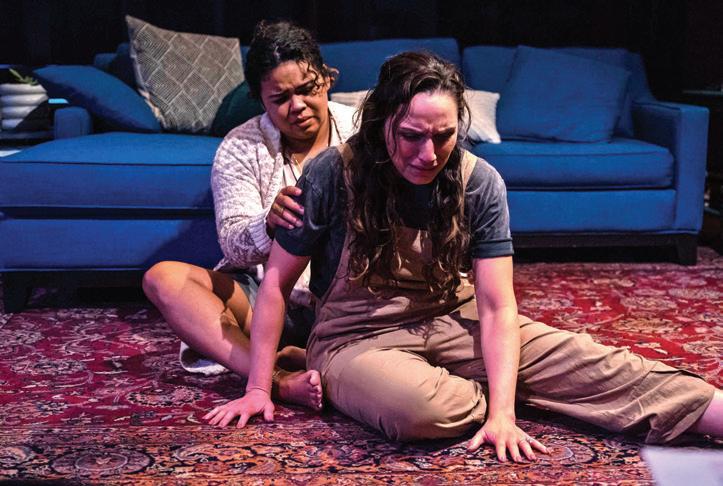
God and still talks to her late father. How is this different from Cynthia’s extraordinary claims? Marc struggles to come up with a good response.
jumpy as its owner—doors open on their own, a painting repeatedly falls off the wall, and mysterious sounds cause you to tune in closely to any ambient noise in the theater, wondering if it’s part of the show.
When Cynthia suggests a game of Two Truths and a Lie, secrets slowly begin to come to light. It would be a shame to reveal too many plot points, so I’ll keep the spoilers to a minimum. We learn that Cynthia had a previous marriage and a child before meeting Marc and that her family was torn apart by a terrible tragedy. While this news is shocking to Marc, it pales in comparison to Cynthia’s next confession: she claims to know why the house seems haunted, and her explanation shakes Marc to the core. As a good therapist, Marc insists that she would never use the term “crazy,” but her professional instincts kick in as she realizes that her partner is traumatized and needs help.
Under Verdin’s direction, the pacing of this production is exceptionally well done. The comfortable normality of the early scenes is punctuated with enough unsettling notes to keep the viewer on edge. Tena is quite e ective in her delivery of Cynthia’s bombshell revelations, and the action gradually builds to a climax that justifies the moniker of “thriller.” The quality work of the creative team, especially the scenic design by Sotirios Livaditis and sound design by Stefanie M. Senior, is key to the success of the jump scares.
While it’s certainly thrilling, the psychological aspects of this psychological thriller are equally as compelling. Cynthia bares her soul about what motherhood has cost her, especially as someone who didn’t want children in the first place. Despite her love for her child, the loss of her previous life as a promising young artist—and the attendant loss of her sense of self—led her to dark places. For readers of Toni Morrison, there are distinct echoes of Beloved, particularly in the haunted house trope and its connection to maternal guilt.
For Marc, the evening’s events provide a harrowing test of her love for Cynthia and her commitment to this relatively new relationship. When her partner asks her to believe something that defies reason, Marc is torn between logic and love. Complicating matters, Cynthia raises the point that Marc herself, a regular churchgoer, believes in an unseen
The play ends ambiguously, leaving room for speculation about what’s really going on in this creepy old house and how these two women will navigate their future together (or not). None of the questions it raises are tied up with a neat bow, but this feels like an honest approach. Everyone brings baggage to a relationship, if not secrets as strange as Cynthia’s, and it would feel contrived to end with pat answers here. No one would wish to have their relationship stress-tested in such an extreme manner, but the show prompts reflection on what it means to accept someone’s whole self when you love them.
A final note: Enough to Let the Light In is part of the fifth Destinos: Chicago International Latino Theater Festival. With 13 productions across Chicago and Aurora, the festival runs through mid-October (some shows continue into November), and showcases new works by Latino theater artists and companies from Chicago, the U.S., and Latin America. This year’s festival and Teatro Vista’s production are both dedicated to the late Myrna Salazar, cofounder and executive director of the Chicago Latino Theater Alliance, the organization that coproduces Destinos along with the National Museum of Mexican Art, the International Latino Cultural Center, and the Puerto Rican Arts Alliance. v
@Emily_221B
30 CHICAGO READER - SEPTEMBER 29, 2022 ll THEATER
Melissa DuPrey (rear) and Lisandra Tena in Paloma Nozicka’s Enough to Let the Light In , presented by Teatro Vista in this year's Destinos festival JOEL MAISONET
BY LYNN NOTTAGE

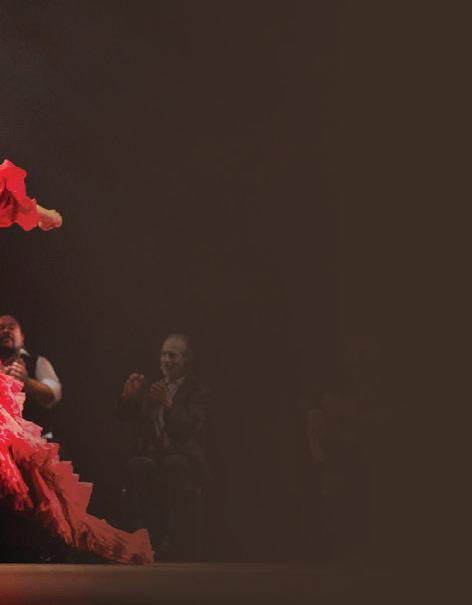

 DIRECTED BY KATE WHORISKEY
DIRECTED BY KATE WHORISKEY

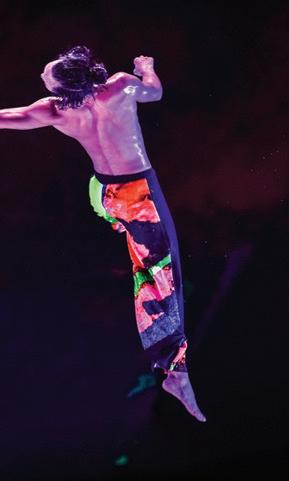








SEPTEMBER 29, 2022 - CHICAGO READER 31 GoodmanTheatre.org 312.443.3800 Groups 10+: Groups@GoodmanTheatre.org Lead Corporate Sponsor Major Corporate Sponsor Lead Funder of IDEAA Programming –Chicago Sun-Times (OUT OF FOUR) “NOTTAGE SERVES UP A HEAPING HELPING OF COMEDY” “WILL LEAVE YOU RAVENOUSLY HUNGRY FOR MORE!”
|
“Feisty comedy is on the menu” (Washington Post ) in two-time Pulitzer Prize winner Lynn Nottage’s latest Broadway triumph. Creating the perfect sandwich is the shared quest of the formerly incarcerated kitchen staff of Clyde’s, a truck stop cafe. Even as the shop’s mischievous owner tries to keep them under her thumb, the staffers are given purpose and permission to dream—finding that “sometimes a hero is more than a sandwich” (New York Times). NOW THROUGH OCTOBER 9 2022–23 SEASON SPONSORS O cial Hotel Partner 2022–23 SERIES SPONSORS Florian Fund Global and Chicago Dance Chicago Dance Joyce Chelberg Pamela Crutchfield Patti Eylar and Charlie Gardner Flamenco Passion ONE NIGHT ONLY | OCT 1 Feel the fiery spirit of España! AuditoriumTheatre.org 312.341.2300 Monica Saucedo in Horizonte, photo by Dean Paul. Cloud Gate Dance Theatre of Taiwan, photo by LEE Chia-yeh. AuditoriumTheatre.org 312.341.2300 Cloud Gate Dance Theatre of Taiwan ONE WEEKEND ONLY! | OCT 14 + 15 2022–23 SEASON SPONSORS O cial Hotel Partner 2022–23 SERIES SPONSOR Florian Fund Global and Chicago Dance CLOUD GATE Presenting Sponsor “Indulgent and visually arresting” — The Times
THEATER
OPENING
R Feast of feats
Cabaret ZaZou is a slightly slimmed-down Teatro ZinZanni.
Picking up where Teatro ZinZanni le off, the newest attraction under the medium top (that is, the classic circus-meets-Victorian-bordello spiegeltent in the Hotel Cambria), Cabaret ZaZou’s Luminaire is pretty much the same thing—but still a good option if you’re looking to splash out on a downtown extravaganza. Under the tent’s glittery mirrors and chandeliers, a contortionist (the astounding Ulzii Mergen) contorts, a clown (the inimitable Frank Ferrante, formerly known as “the Caesar” with ZinZanni) cavorts, and juggler Viktor Kee and aerialists Trio Vortex keep balls and their bodies moving overhead with astonishing precision.
With blistering chief vocalists James Harkness and Liv Warfield blasting the tent’s roof off with renditions of “What’s Goin’ On,” “Willow Weep for Me,” and “Father Figure,” the music blends soul, jazz, rock, and pop as a soundtrack for the featherweight storyline involving Ferrante’s bellboy, Fortissimo, trying to find and win the forgiveness of his lost love. With the help of volunteers from the audience, he enacts rituals from his hometown in Italy’s “Feast of Forgiveness,” which at one point involves a cunning rendition of “The Impossible Dream,” played on desk bells.
It’s all very silly stuff, but Ferrante remains an ingratiating host and a dab hand at finding the right volunteers and putting them at ease. And the circus acts are as breathtaking as ever. If you’ve already seen ZinZanni and loved it, the show’s for you. If you haven’t but are in the mood for a lighthearted performance with heartstopping interludes of circus arts, then Luminaire can light the way to a fun night out. —KERRY REID LUMINAIRE Open run: Wed-Sat 7 PM, Sun noon, Hotel Cambria, 32 W. Randolph, 312-488-0900, broadwayinchicago.com, $75-$185 (most tickets include meal)
R Split personality with a twist Idle Muse’s take on Jekyll/Hyde dissects gender and class politics.
Idle Muse Theatre Company’s The Strange Case of Dr. Jekyll and Mr. Hyde is good, dark Halloween-season entertainment, especially if you’re a fan of the Hammer/ Amicus/American International Pictures-style of lurid rethinkings of Victorian horror classics. Adapted by Michael Dalberg and directed by Morgan Manasa, this production ups the sex-and-violence aspects of Robert Louis Stevenson’s 1886 story of morally upright Dr. Henry Jekyll, who concocts a potion that transforms him into wantonly murderous Edward Hyde—the embodiment of Jekyll’s own hidden evil urges.
Dalberg’s crisp, epigrammatic script turns Henry Jekyll into Henri Jekyll (Brandi Jiminez Lee), whose ambitions are thwarted by the sexism of London’s medical establishment. Henri is romantically drawn to her straitlaced solicitor, Gabriel Utterson (Shane Richlen), as is he to her. But demonic, lustful Hyde (the commanding Jack Sharkey) keeps intruding, eager to wreak vengeance on the men who Henri feels have wronged her, including fellow physician Hastie Lanyon (Joel Thompson) and corrupt aristocrat Sir Danvers Carew (played by understudy Ross Compton at the performance I saw).
Having Jekyll and Hyde played by separate actors deprives the audience of a transformation scene, traditionally the high point of Jekyll/Hyde movies and plays.
But there’s plenty of payoff in the alter egos’ heated arguments—the external manifestation of Jekyll’s interior monologues—and the malevolent glee with which Sharkey imbues Hyde is delicious in the ripe Vincent Price/Christopher Lee tradition. Sound designer L.J. Luthringer’s pounding techno background music adds a contemporary intensity to the Gothic tale. —ALBERT
WILLIAMS THE STRANGE CASE OF DR. JEKYLL AND MR. HYDE Through 10/23: Thu-Sat 8 PM, Sun 3 PM, the Edge Off-Broadway, 1133 W. Catalpa, 773-3409438, idlemuse.org, $20 ($15 students and seniors, $10 Thu industry nights)
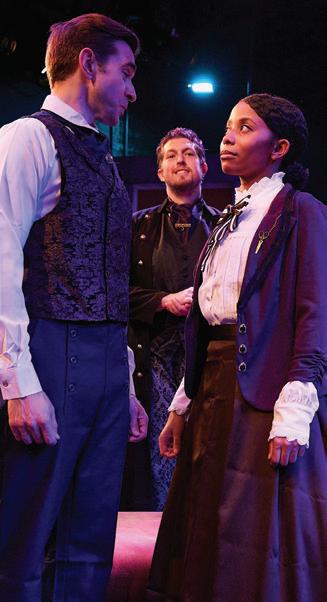
R Whose life is it, anyway?
Tebas Land maps the territory between artist and subject.
What is an artist’s relationship to their art? The complexities of that question form the central story in Franco-Uruguayan playwright Sergio Blanco’s Tebas Land, now appearing under the direction of Argentinean director Juan Parodi in its U.S. premiere as part of the fi h Destinos: Chicago International Latino Theater Festival. Presented by the Chicago Latino Theater Alliance in collaboration with the National Museum of Mexican Art, the show is performed in Spanish with English subtitles.
Tebas Land tells the story of S (Esteban Schemberg), a playwright seeking to create a project around the story of Martín (Tommy Rivera-Vega), a young man who murdered his father. Through several meetings on a prison basketball court, the pair gets to know each other as S gives Martín a space to share his story in his own words.
Guided by his artistic vision, S initially intends to understand Martín’s decisions to kill his father and to unravel the psyche of a parricide before, during, and a er his crime. As their meetings progress, questions emerge about the complexities of portrayal and what it means to represent someone else’s story. The line between the artist and his subject becomes increasingly obscured, impacting S’s final vision for his performance.
Parodi and both performers skillfully illustrate the intricacies and subtleties of S and Martín’s relationship, whilst centering the play’s most critical questions. The central relationship is elevated by the play’s unique structure, which is distinctly and sometimes humorously meta and weaves thoughtful parallels between Martín and the myth of Oedipus. —KATIE POWERS TEBAS LAND Through 10/9: Thu-Sat 7:30 PM, Sun 3:30 PM, Chicago Dramatists, 1105 W. Chicago, destinosfest. org, $20-$25. In Spanish with English subtitles.


R
Temporary beauty
Trap Door’s The Ugly One is a cautionary tale.
Lette (Dennis Bisto) assumes that since he’s the inventor of his company’s latest product, he’ll be the one to present it at the big upcoming corporate event. But then his coworkers and wife reveal a secret kept from him his entire life: his hideous face. No one would ever buy his genius invention when he looks like that! Thrown into existential turmoil, Lette is convinced to undergo unproven and radical plastic surgery under the knife of the ghoulish Scheffler (Alexis DawTyne) to change his looks. The operation succeeds too well and overnight he becomes the envy of everyone he meets.
The transformation from an ugly talent to a universally adored Adonis isn’t a fit made to last. With fame and riches come envy and paranoia. Soon Lette spends most of his time clinging to fool’s gold rather than satisfaction at work or happiness at home. He’s trying to hold on to something he never even wanted before he got his new face. Marius von Mayenburg’s 2007 horror comedy gets a bracing, utterly contemporary interpretation with Trap Door under Michael Mejia’s direction. Lette’s desperate striving for hollow beauty will be familiar to anyone who scrolls Instagram, and Scheffler’s triumphant declaration that she’s an artist rather than a doctor will evoke countless unwatchable reality TV shows. Like an old-fashioned fairy tale, this brash, over-the-top show reminds us to be careful what we wish for.
—DMITRY SAMAROV THE UGLY ONE Through 10/29: Thu-Sat 8 PM, Trap Door Theatre, 1655 W. Cortland, trapdoortheatre.com, $25 (two for one Thu) v
32 CHICAGO READER - SEPTEMBER 29, 2022 ll
The Ugly One at Trap Door Theatre J. MICHAEL GRIGGS
Tebas Land at Destinos: The Chicago International Latino Theater Festival ROGELIO OLGU ín
The Strange Case of Dr. Jekyll and Mr. Hyde at Idle Muse STEVEN TOWNSHEND/DISTANT ERAS
coverage

















































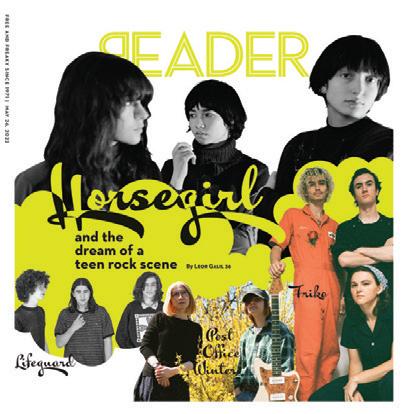


SEPTEMBER 29, 2022 - CHICAGO READER 33 Providing arts
in Chicago since 1971. chicagoreader.com A performing arts visual arts and other arts categories
FILM
‘Let’s make the funniest movie we can make’
By ADAM MULLINS-KHATIB
Bros , directed by Nicholas Stoller, written by Northwestern alumnus
Billy Eichner and Stoller, is a film that prides itself on a couple of firsts: the first romantic comedy from a major studio focusing on gay men and Eichner as the first openly gay man to write and star in a studio picture. Featuring an LGBTQ+ principal cast, the film hilariously threads the needle in its portrayal of common complications across all romantic relationships, while never sacrificing the uniqueness of LGBTQ+ experiences.

I sat down with Eichner and costar Luke Macfarlane—who play protagonists Bobby and Aaron, respectively—to discuss the joy of the theatrical experience, bringing the film from idea to reality, and the exuberant messiness of loving both complicated people and communities. What follows has been edited for length and clarity.
Adam Mullins-Khatib: When you spoke to the audience after the screening last night, you spoke to the importance of sitting together in a theater and laughing. What does that really mean to you?
Billy Eichner: I think we’ve forgotten how much fun it is to sit in a movie theater with people and laugh for a couple of hours, you know? It’s an experience I grew up having all the time that we took for granted. A lot of the movies that get released in theaters are pretty dark and gritty and cynical, or they’re harm movies, you know, they’re meant to scare people. And I love a lot of those movies, nothing against those movies, but, you know, there’s something about experiencing [comedy] with hundreds of other people that I think is very comforting and delightful and makes you feel good about life. So, I hope that Bros gives people that experience.
Luke Macfarlane: Again, we were for the last maybe five to six minutes kind of waiting in the hallway and listening, and I forgot how much I like listening to people respond to something. I’ve seen the movie enough times now that I can not just watch a movie, but also listen to the audience watch the movie. And that’s delightful, absolutely delightful.
I love all kinds of movies, but it’s sad, losing that experience of just being in that room and laughing together, not just being nervous or scared or anxious together.
Eichner: Right, or suffering through a fourhour movie together. And, for LGBTQ movies, the few that we’ve got, they’ve so often been about the suffering of being gay. About the torture of the closet. They’re period pieces about tortured gay, gay cowboy, queer people, and we’re getting beaten up and we’re dying of several di erent diseases, and we’re being played by straight male movie stars. So, we don’t even get to play the roles where we’re dying! And look, those stories are important to tell . . . but we also fall in love and make each other laugh a lot. My experience of being gay is and has been pretty joyful. Most of the time when it has been complicated or challenging, it’s been in the way that being a human is complicated and challenging for everyone straight or LGBTQ. So again, this is a rare movie, and I’m glad to be giving people that experience and I hope they take us up on it.
Were there any particular points that struck you as critical in the development process of bringing this idea from inception to the theaters?
Eichner: Sort of, yeah. You know it’s the first movie I’ve ever written and the first movie I’ve ever starred in. But, I didn’t make it by myself.
I made it with two very experienced guys who made a lot of great major studio comedies, Judd Apatow and Nick Stoller. Bridesmaids , The 40-Year-Old Virgin , Forgetting Sarah Marshall, and the list goes on and on.
I love those movies. We’re comedy guys, first and foremost, you don’t sit down and say, “I’m writing a historic comedy, or I’m going to write a gay movie, etc.” We sat down and said, “Let’s make the funniest movie we can make.”
But also, and I told those guys from the beginning—and to their credit, they were always backing me up on it—I said, “It has to be authentic.” That’s what I want to give people. I want LGBTQ folks and the gay men that the movie is essentially about to see themselves reflected in a way we have not gotten nearly enough of over the years, especially on a big screen in the movie theater. And I think it’s important and fun and exciting for straight people, who might think they know what it’s like to be gay based on a few wacky sitcom characters they’ve seen over the years, but they don’t really know.
I told Nick and Judd from the beginning, we can’t just do When Harry Met Sally and slip in two gay guys, you know? We don’t play by those rules. And the movie has to reflect that. So that was really important to me.
Macfarlane: The rules are di erent.
Luke, in terms of your involvement in this film, can you kind of speak to how you became aware of it? How do you know Billy, or was this your first interaction?
Macfarlane: It was very much the old-fashioned way. My agent sent me a script and said, “This is a great part.” I was aware of Billy but
had never met him before. I read the script . . . and immediately had that feeling, “Oh, oh boy, this is, this is good.” Not only because it was hilarious, but because it really spoke to something that I identified with. And then I went in, I auditioned, and it felt really good. . . . We sat down in conversation before and after, and we’ve talked about this a couple times, but the Garth Brooks thing [Brooks is Aaron’s favorite musician, much to Bobby’s dismay] actually came out of a real conversation that happened during filming.
Eichner: On set! A few weeks into filming.
Macfarlane: On set. And Billy was like, “I’m going to put it in.” And there were other things that he just sort of threw in that didn’t ultimately make it in the movie that were just based on conversations and how he and I are di erent and how we take up two di erent sort of spectrums of the cis, white male spectrum.
Were there any favorite moments that didn’t make it into the film?
Eichner: We shot 170 pages. With the extra time that, unfortunately, COVID gave us—because we got shut down about a month before we were supposed to start shooting in early 2020 and then a year and a half passed by—we just kept writing more stu and more funny stu and more jokes. So, by the time we got to shoot, we had 170 pages. To Nick’s credit, he somehow found a way to shoot it all, because the number of shoot days we got didn’t increase.
Yeah, oh my god, there were so many jokes. I think some of the set pieces that we had to cut will end up on the DVD or something like that. We had a whole Pride parade sequence, a huge Pride parade that falls apart where everyone starts fighting. I love that scene, but ultimately, some things were a little, in the context of the movie, too silly. It’s not a sketch comedy show, it’s a real, grounded story we’re trying to tell, one with a lot of comedy and a lot of laughs, but sometimes even when things were funny on paper, it just felt like a di erent tone. They couldn’t fit in the movie as much as we loved them. There’s a lot of those. And I think maybe you’ll see them in the extras. v
@acmkhatib
34 CHICAGO READER - SEPTEMBER 29, 2022 ll
Luke Macfarlane as Aaron and Billy Eichner as Bobby in Bros UNIVERSAL PICTURES
INTERVIEW
Billy Eichner and Luke Macfarlane discuss their new LGBTQ+ film Bros, which brings equal parts comedy and authenticity to theaters.










SEPTEMBER 29, 2022 - CHICAGO READER 35 In Concert SATURDAY, OCTOBER 8 | 7:30PM AuditoriumTheatre.org 312.341.2300
BLONDE ss NC-17, 166 min., Netflix
netflix.com/blonde
Marilyn-Monroe; or, Blonde
By KATHLEEN SACHS
“For all men tragically great are made so through a certain morbidness. Be sure of this, O young ambition, all mortal greatness is but disease.”
—Herman Melville, Moby-Dick
Imagine my surprise when, as a preteen girl with a budding interest in film—for whom the galaxy of the Hollywood star system was an
accessible inroad to the vast universe of cinema—I checked out Joyce Carol Oates’s 2000 novel Blonde from the library, thinking it was a straightforward biography of the mythical star.
“There came Death hurtling along the Boulevard in waning sepia light,” begins Oates’s haunting prelude. I was perplexed. I’d known that Marilyn Monroe had died young and
that she’d faced a lifetime of struggle. With images of Lorelei Lee and Sugar “Kane” Kowalczyk dancing, singing, and playing ukulele in my head (these roles from Gentlemen Prefer Blondes [1953] and Some Like It Hot [1959], respectively, feature prominently both in Oates’s novel and Andrew Dominik’s adaptation of it), I hadn’t fully comprehended the gravitas of Marilyn’s allure past the multitude of cheap
clothes and home-good tchotchkes on which her face was plastered.
But just as the hazy, clip-art likenesses of Marilyn on rhinestone-studded T-shirts and aluminum signs aren’t accurate representations of the star as a person, nor is Oates’s novel or any of its adaptations. “Mr. Melville obviously lacks the realist’s conviction that the bare facts of human life are in themselves eloquent,” wrote esteemed critic and biographer Carl Van Doren in an essay on Moby-Dick for a 1924 issue of The Bookman literary journal, “and so permits himself to lean a great deal upon certain misty symbols to give his meaning its rich colors and ominous shadows.”
Rich colors certainly distinguish the meaning of Marilyn, from her bright red lipstick to the Technicolor glamor of films such as Gentlemen and the earlier Niagara (1953), as do ominous shadows. Just as death hurtles along at the beginning of Oates’s book, a montage of severe chiaroscuro shots depicting how the white light of Marilyn Monroe is illuminated against those shadows—set to the film’s correspondingly portentous score by Nick Cave and Warren Ellis—begins this controversial adaptation. New Zealand-born, Australia-based writer-director Dominik ( The Assassination of Jesse James by the Coward Robert Ford [2007], Killing Them Softly [2012]) started adapting Oates’s novel in 2011, with Jessica Chastain at one point attached to star as Marilyn, the part which later went to Cuban actress

36 CHICAGO READER - SEPTEMBER 29, 2022 ll
Ana de Armas as Marilyn Monroe
MATT KENNEDY/ NETFLIX
REVIEW
Andrew Dominik’s epic allegory has Melvillian ambition.
ssss EXCELLENT sss GOOD ss AVERAGE s POOR • WORTHLESS FILM
Ana de Armas.
What’s there left to say about why Blonde is controversial? It’s rated NC-17, the first film of its kind to be released on a streaming service; there’s nudity, sex scenes, and, most disturbing, several scenes depicting sexual and physical violence against the main character. And there’s not one but two scenes shot from inside a vagina as it’s being prepared for an abortion.

Thus some viewers have criticized the film for what it’s not and what it could never be—a revisionist history that would somehow make Marilyn’s life and legacy less sorrowful. These viewers would likely prefer that Blonde focused more on facets of her personality (or, should I say, persona; much of Blonde the novel and the film are about Marilyn Monroe the construct versus Norma Jeane the person) and career that audiences could perceive as contrary to the myth of Marilyn as a poor little rich girl whose extraordinary beauty made her susceptible to exploitation from both men and the entertainment industry at large. Many also make note of Monroe’s intellectual curiosity, pointing that out as something a less o ensive text would have chosen to highlight.
Such criticism, however, is not about the film, but rather the ongoing mythology surrounding Marilyn the construct, which is inherently what Oates’s novel and Dominik’s film seek to epitomize. The former has said that Monroe is her “Moby Dick, the powerful galvanizing image about which an epic might be constructed, with myriad levels of meaning and significance.” Monroe is in turn the American public’s white whale, that which we seek to dominate and claim as our own. The discussion over depictions of Monroe are often less about the depictions themselves and more about who has the right to tell her story and what version of the story it should be.

Dominik follows his source material faithfully, altering it only by omission. (The novel is several hundred pages long, so naturally a screenwriter would need to be prudent about what to keep in and what to leave out. Joyce Chopra, for example, directed an adaptation of the novel for television in 2001, largely focusing on the same sections of the book that Dominik does with a few key di erentiators).


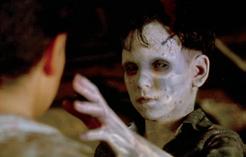
It starts at the beginning of the story, with the troubled mother of little Norma Jeane Baker planting in her daughter’s head the false hope that her absent father is actually a Hollywood titan. Those familiar with the lore will recog-



FILM
nize the image of her supposed father hanging on the wall of the dilapidated bungalow where she and her mother reside; she grew up thinking that her father was Clark Gable, a prophetic misconception that would come full circle when she costarred with him in John Huston’s The Misfits (1961).
These parts are especially fraught. Norma Jeane’s mother, Gladys Pearl Baker (Julianne Nicholson, who’s harrowing in the turn), is shown trying to drown her daughter in a bathtub, which results in the mother being institutionalized and Norma Jeane being sent to an orphanage. The film glosses over other facets of Monroe’s early life, such as her first marriage at age 16 and when she was discovered as a pinup model for cheesecake magazines, jumping instead to her first movie audition. Before the latter event, she’s raped by the studio head (implied to be Darryl F. Zanuck from 20th Century Fox); after, she’s ghoulishly mocked during the screen test. This passage is in color, one gimmick of the film being that it’s in color when it depicts Norma Jeane and in black-and-white when it’s Marilyn. That preternatural intelligence that so many claim goes unrecognized is on display during her screen test, as she compares the script of the film she’s auditioning for to Chekhov, which prompts condescending sco s from the male studio employees.
Nevertheless getting the part as a result of the rape, Marilyn’s star is soon on the rise. Here begins the most hallucinatory part of the film, wherein she enters into a ménage à trois with Charlie “Cass” Chaplin Jr. (Xavier Samuel) and Edward G. Robinson Jr. (Evan Williams), boys about town with daddy issues (being the sons of their respective seniors) and substance abuse problems. This sexual and emotional algebra problem eventually yields a pregnancy, something Marilyn had long yearned for; however, realizing that her mother’s mental health issues could be passed down to her child and having been offered a part in Howard Hawks’s Gentlemen Prefer Blondes, she undergoes her first abortion. The relationship between the three is perhaps the most embellished aspect of whatever parts of Marilyn’s real life exist in this allegorical rendering; she allegedly was involved with the men, but not in a sexually charged throuple as depicted in the film.
Then she meets her second husband, the Ex-Athlete, baseball legend Joe DiMaggio (Bobby Cannavale), who is possessive of Mari-
lyn and becomes abusive toward her, especially after the stunt for Billy Wilder’s The Seven Year Itch (1955) that found her standing atop a subway grate, letting her white dress blow up in front of thousands of onlookers. Next comes her relationship with The Playwright, Arthur Miller (Adrien Brody, excellent in the role), who appeals to Marilyn’s intellectual side; he seems genuinely interested in her notes on his play After the Fall. They soon wed, and a relationship that seems idyllic becomes fraught after Marilyn suffers a miscarriage of their much-wanted child.
Now in an emotional free fall and separated from Miller, Marilyn enters into an a air with President John F. Kennedy, which becomes the symbol of her impending demise. She’s brutally assaulted by the president, then forced to have an abortion against her will, all leading up to the day Death comes knocking with its special delivery.

I’d argue that Blonde exists independently of some criticisms that have been leveled against it but not that it’s always a good film. One can’t deny the boldness of Dominik’s artistic choices. The visual delineations between Norma Jeane and Marilyn Monroe, for example, are successful, even striking. Other choices, like the frequent shifts in aspect ratio, are ambitious but not as a ecting.
Some are outright disastrous, as in multiple sequences where what looks like a 3D ultrasound of a baby does a Malickian song and dance in an attempt to impart the meaning of life upon its poor, defenseless mother. Shots during the honeymoon phase of Miller and Monroe’s marriage (meant to mimic real-life photographs of the two) are almost unbearably schmaltzy, especially as Cave and Ellis’s nightmarishly ethereal score plays alongside
it.


Naturally the question of whether Dominik, a male director, is qualified to depict such specifically female issues has arisen. I can’t make a case for the film being feminist one way or the other, if only because that isn’t the point. Dominik’s depiction of Marilyn’s suffering, excessive though it may be, is aggressively confrontational in such a way that some have termed broaching on torture porn. An alternate viewpoint could be that it’s intentionally repellant at times to underscore the depths of her hardship. I can’t help but think that in many ways it’s us, the viewers, who are still asking too much of Marilyn: we want to acknowledge her pain, but not too much, attempting to forge a balance that may not have existed. Perhaps we want Marilyn to have been a certain way in spite of her pain, which represents yet another projection onto the eternally blank slate.
We search not for the real Marilyn Monroe but the idea of Marilyn that conforms with our respective image of her. Thus the demand that such an undertaking be wholly representative is di cult at best, hypocritical at worst.
“Blonde . . . is a work of fiction and imagination,” writes literary critic Elaine Showalter in a review of the novel, “and Oates plays with, rearranges, and invents the details of Monroe’s life in order to achieve a deeper poetic and spiritual truth.” Whether or not Oates and Dominik succeeded in doing so is, like the mythos of Marilyn, ultimately a matter of personal interpretation, of belief in one’s conviction. To again quote Moby-Dick: “Let faith oust fact; let fancy oust memory; I look deep down and do believe.” v
@Chicago_Reader
SEPTEMBER 29, 2022 - CHICAGO READER 37
SISKELFILMCENTER.ORG Guillermodeltoro 5FilmGuillermodeltoro 5Film Series Series Oct7Oct7Oct13 Oct13 THESHAPEOFWATER (2017) OCT7&9 THEDEVIL'SBACKBONE (2001) OCT7&8 CRIMSONPEAK (2015) OCT8&13 PAN'SLABYRINTH (2006) OCT8&11 NIGHTMAREALLEY (2021) OCT9&10 35mm 35mm 35mm35mm /CINELATINE
FILM
NOW PLAYING
R The African Desperate
At the beginning of Martine Syms’s debut narrative feature, sculptor Palace (Diamond Stingily, also an artist in real life) is shown receiving her MFA from an art school in upstate New York. Four white faculty members bestow the honor, but only a er offering a range of supercilious (some even outright racist) critiques and patronizing banalities. This kicks off Palace’s final 24 hours as an exhausted graduate student, who vows to skip the end-of-summer party but instead finds herself drawn to the debauchery. Syms’s work—which ranges from performance art to gallery installations to this more straightforward narrative endeavor—is compelled by a preternaturally propulsive energy that sustains its momentum even as she explores various forms of expression. As Palace navigates her final day at the college, Syms inserts multimedia quirks into the coming-of-age proceedings, such as when Palace, doing her makeup for the night, assumes the peculiar dialect of a social media influencer filming a tutorial; trenchant memes occasionally pop up in the top right corner of the screen, flashing by so quick as to be illegible but hilarious nonetheless. It’s through these means that the film offers wry commentary on everything from undecipherable artspeak to racism. (An exchange between Palace and a faculty member extolling the virtues of a rapper he heard an interview with on NPR’s Fresh Air, to which Palace replies “What’s Fresh Air?,” is one of the funniest things I’ve seen in a film all year.) Cowritten by Syms and Rocket Caleshu, its script is so good as to seem unwritten, the stuff of real-life folly; Stingily’s performance is similarly ingenious. —KATHLEEN SACHS 97 min. Gene Siskel Film Center
R Bros
In the romantic comedy Bros, Bobby (Billy Eichner) recently expanded his career as a LGBTQ+ history podcast host into lead curator of the first major LGBTQ+ museum in New York. A er a meet-cute of
sorts with not-his-usual-type Aaron (Luke Macfarlane), Bobby struggles to pair his feelings with his self-described permanently single lifestyle.
Written by Eichner and longtime comedy veteran Nicholas Stoller, and directed by Stoller, Bros toes the line between genuine moments of sweetness and acerbically cutting sarcastic wit. Modes of relationships differ, and Bros is comfortable in highlighting those differences for all their joys and faults.
Where the film truly succeeds is in its ability to de ly balance universal experience with individuality. While there are obviously commonalities between the romantic experiences of gay and straight people across gender identities, or even more narrowly between cis white men as a subcategory, the diversity of specific experience is critical to Eichner’s script, as even within narrow categories there are vastly varied modes of interaction, openness, and perspective. Of course, finding shared experience and opening oneself up to be surprised by those who fall outside of our initial expectations is a common trope in romantic comedies, but Eichner and Stoller’s script is inventive enough to expand the trope in entertaining ways, and Macfarlane brings depth of performance to a character that could otherwise fall into cliché.
Ultimately, Bros is a genuinely funny movie with nuanced emotional he . It’s a refreshing and vulnerable take on the genre from a perspective so rarely seen in Hollywood filmmaking and a reminder of the joy and laughter that’s there to be found in the chaotic minutia of human relationships if we’re open to finding it. —ADAM MULLINS-KHATIB R, 115 min. Wide release in theaters
Catherine Called Birdy
Based on Karen Cushman’s well-loved 1994 children’s novel, Lena Dunham presents a girl’s coming-of-age story set in 13th-century England. The sets and costumes look period-correct, but this is no attempt at historic verisimilitude à la Robert Eggers’s The Witch. Birdy is the kind of impossible, irreverent girl Dunham special-

izes in. Spoiled, defiant, but also capable of empathy beyond her years, she’s an almost prototypical heroine for a children’s book.
The plot turns on the family’s money problems, the solution being to marry Birdy off for as much of a dowry as she can command. Of course the girl fights this plan tooth and nail, sending a succession of suitors running away screaming. Using contemporary pop music and employing 2022 dialogue—albeit peppered with occasional medieval lingo—Dunham has fashioned a teen rom-com in period garb. It reminded me a bit of Sofia Coppola’s Marie Antoinette, though pitched to tweens. Those familiar with Dunham’s previous work will be surprised by the gentleness of approach and the conventionality of the story’s resolution. In the end, Birdy comes to terms with the need to do what’s best for her family and to grow up and become like everyone else. I was very aware while watching that as a 51-year-old man I was not who this was made for. But is it a good message to send young girls that they can be bad and do what they want for a little while but when the rubber hits the road they must toe the line? —DMITRY SAMAROV PG-13, 108 min. Wide release in theaters and streaming on Prime Video
Don’t Worry Darling
The saying goes that all press is good press, but how true can that be if alleged drama surrounding a film overshadows the merits of the film itself? Don’t Worry Darling is the second movie to fall into this trap this summer, though it does manage to still bring on the thrills, mostly thanks to another potent performance from Florence Pugh. Her range is on full display as Alice, a 1950s housewife who begins to suspect that her husband’s company is up to something sinister within their utopian community. Alice, her husband, Jack (a dull but good enough Harry Styles), and all the company employees along with their wives live isolated from the rest of the world, hardly able to remember their lives from before they arrived. The only rule is that they stay within the company town, where they’re safe. Chris Pine delivers a disturbing performance that’s part televangelist and part cult leader, totally nailing that brand of big, inspiring speeches that seem poignant in delivery but are empty when you actually listen to the words being said.
Piecing together what’s actually going on in this seemingly idyllic community proves tougher than expected, which primes for a tense twist in the final act, and the film’s introductory scenes are truly creepy as Alice begins to question her sanity, the world, and the people around her. The issue is in the middle: once Alice is convinced that something is wrong, the movie ought
to pick up the pace to maintain momentum. Instead, it drudges on with a shot-by-shot repetitiveness that’s likely intentional but ends up being ineffective. There’s even a pump-fake twist and by this point, you’re begging for the real reveal to be, well, revealed. When the truth finally does come out, the explanation is interesting but flimsy, and a er waiting so long to find out, it’s unsatisfying. Ultimately, Don’t Worry Darling boasts a (mostly) talented cast with a strong start but can’t follow through on its promises. —NOËLLE D. LILLEY R, 122 min. Wide release in theaters
R Riotsville, U.S.A.
A er protests in many major American cities shook the country’s establishment in the mid-60s, Lyndon Johnson assembled what would come to be known as the Kerner Commission (a er Illinois governor Otto Kerner, who headed it) to study and recommend solutions to the racial and economic issues that inspired the widespread unrest. Their report, published by Bantam Books in paperback, quickly became a bestseller. But the sweeping reforms the commission called for were mostly ignored, except for a line item toward the end to boost funding for law enforcement. Some of this new money went to the construction of model towns on army bases in Virginia and Georgia. Dubbed “Riotsville,” they were stage sets where police departments and the military playacted command and control tactics to quell inner-city turmoil, complete with bleachers full of officers and politicians cheering and laughing as soldiers dressed as “hooligans” and “rabble-rousers” got their heads bashed in and helicopters clouded all of the ersatz Main Street with tear gas.
Sierra Pettengill’s disquieting documentary uses only archival footage shot by the military and clips from period news coverage to explore this uncanny episode in the country’s history. As fake as the towns and protestors obviously were, the training law enforcement groups received in these Riotsvilles was all too real. Their violent strategies to snuff out unrest outside the Republican convention in Miami and the Democratic one in Chicago in 1968 were taught on those sets. While Pettengill’s sympathy for the largely le -wing activists and community organizers is clear, her use of strictly period footage that has rarely screened before—and certainly never for a wide audience such as a major broadcast network—lends her film a depth that would’ve been absent if she presented a bunch of contemporary talking heads explaining the flaws and lapses of the establishment. These odd, sometimes amateurish frames put the viewer back into that tumultuous time in a way that no amount of outraged words ever could.
—DMITRY SAMAROV 91 min. Gene Siskel Film Center v
38 CHICAGO READER - SEPTEMBER 29, 2022 ll
Catherine Called Birdy ALEX BAILEY/AMAZON CONTENT SERVICES LLC
Find new film reviews every week at chicagoreader.com/movies





SEPTEMBER 29, 2022 - CHICAGO READER 39 Let’s Play! Make time to learn something new with music and dance classes at Old Town School! We offer flexible schedules for all skill levels both in-person and online. oldtownschool.org Sign up for classes today at MUSIC CLASSES FOR ADULTS & KIDS LINCOLN SQUARE LINCOLN PARK SOUTH LOOP & ONLINE OTS_1_2V_ClassAd_072921.indd 1 7/23/21 2:21 PM 3730 N CLARK ST METROCHICAGO.COM @METROCHICAGO SMARTBARCHICAGO.COM 3730 N CLARK ST | 21+ SATURDAY OCT 01 JAMIE 3:26 CRATEBUG HUMBOLDT ARBOREAL SOUNDSYSTEM FRIDAY SEP 30 THE BLESSED MADONNA HAAI / HARRY CROSS FRIDAY OCT 07 Obscure + Format present ETAPP KYLE JEFF DERRINGER BRENDA LOCAL H NNAMDÏ FORTUNATE YOUTH HALLO-QUEEN! SOCCER MOMMY ANTIFEST HOLLY HUMBERSTONE SHE WANTS REVENGE OCT 21 OCT 22 OCT 28 OCT 30 NOV 01 NOV 04 NOV 05 NOV 06 TUE OCT 04 HARU NEMURI + Frost Children SAT OCT 08 KMFDM + Chant FRI OCT 07 CALEXICO + Ada Lea Laid Back | Cold Beer | Live Music @GMANTAVERN GMANTAVERN.COM 3740 N CLARK ST 21+ WED OCT 12 GIRLS AGAINST BOYS + FACS / Poison Arrows SATURDAY OCT 15 / 7:30PM / 18+ L7 + Fea SUNDAY OCT 16 / 8PM / 18+ ALGERNON CADWALLADER + Kinsella & Pulse SUNDAY OCT 09 / 7PM / 18+ TOADIES performing Rubberneck + Reverend Horton Heat— performing Liquor in the Front + Nashville Pussy THURSDAY OCT 13 / 9PM / 21+ @ SLEEPING VILLAGE IBIBIO SOUND MACHINE + Terror Jr SATURDAY OCT 01 / 10:30PM / 18+ LATE SHOW ADDED DUE TO DEMAND! THE AVALANCHES + Kareem Ali
SHOWING UPfor one another
By ALEJANDRO HERNANDEZ
For decades, Chicago’s spoken-word poetry community has made influential waves across the city and country. Open-mike nights are a proving ground for young creatives to discover their voices and hone their crafts. One of the unsung architects of this community is JazStarr, who is now venturing on her path and stepping into her own spotlight as a musician—one who also works tirelessly behind the scenes.
“I came up in the poetry scene under my mentors,” JazStarr recently told me. “They really showed me that community can actually be a part of your everyday life if you make it that way, whether that be showing up for a fundraising event or organization, or it be organizing yourself to provide resources for people around you. I don’t see myself ever
being an artist that could choose one or the other. It has to be both together. I have to both be an artist and be an activist.”
JazStarr credits her grandmother and the west-side block she grew up on with instilling within her an appreciation for the importance of building solidarity within communities. In addition to actively helping to create spaces for young Black and queer creatives, she also organized interventions between Black and Latinx gang members when racial tensions rose following the 2020 protests that were sparked by George Floyd’s murder by Minneapolis police o cers.

“I felt like everybody around me was doing something and I was just in my own area feeling crazy, because it felt like my brother couldn’t walk down the street,” she recalled.


“This is just not the time for us to be busting

40 CHICAGO READER - SEPTEMBER 29, 2022 ll MUSIC
JazStarr THOUGHTPOET
Poet and organizer JazStarr builds bridges on the page and in the community.
each other. We need to be focused on the bigger issue at hand. Let’s come together because what happened to George Floyd is happening to both [Black and Brown people], and as minorities and POC we should be able to come together to make a bigger push.”
JazStarr helped organize a coalition of people from both Black and Brown communities along the south and west sides. The coalition led multiple peace walks in which residents and gang members from predominantly Black neighborhoods would walk into Latino neighborhoods and join their respective residents hand in hand, and vice versa.
After pouring so much of herself into filling the cups of those around her, JazStarr came to a point in her life when she realized she needed to do something for herself. She’s spent the better part of the decade supporting others, whether it be through her contributions as
an organizer or as a backup singer. With the release of her debut project Ambrosia , she’s finally ready to step into her own spotlight.
“It took a lot for me to get to the point of trusting myself to put out music, trusting the process and a lot of growing pains,” she lamented. “We were just making music, and making music, and I didn’t really have a theme for it. At first, I was just like, ‘I do want to see myself complete something for myself.’ That’s really the energy of this project: showing up for myself, and the execution of starting things and finishing them with intention.”
The same way JazStarr showed up for her community for so many years, her community showed up for her to assist in the creation of Ambrosia, namely key collaborators Freddie Old Soul and _stepchild. The project is a nostalgic eight-piece of smooth and seductive neo-soul with subtle hip-hop influences. Jaz-



Starr embarks listeners on a nearly 22-minute journey of love, vulnerability, and spirituality that is easy to relate to. After finally accomplishing something for herself, she intends to continue celebrating as a multidimensional Black woman, and helping give those around her the proper tools to improve themselves and their community,


“It gives a very gratifying feeling to know that you could very much change somebody else’s life with music. I want to be able to see people younger than us take this and then keep going until it becomes the culture of Chicago for people to grab their bags and put them to work,” she said. “Let’s keep the youth productive, hold ourselves accountable, and be emotionally sound Black people in the city of Chicago. That’s the goal.” v
@DroInTheWind_
J. Miles
Dar Williams
Trace Bundy
Family Concert
Okee Dokee Brothers
David Wilcox
Indigenous Peoples' Day
Indigenous Peoples' Day
Lynn
Kellogg
Lucy Kaplansky
SEPTEMBER 29, 2022 - CHICAGO READER 41
MUSIC 10/5 Jaerv 10/9 & 10/10 Indigenous Peoples' Day 10/12 Imarhan WORLD MUSIC WEDNESDAY SERIES FREE WEEKLY CONCERTS, LINCOLN SQUARE OLDTOWNSCHOOL.ORG 4544 N LINCOLN AVENUE, CHICAGO IL OLDTOWNSCHOOL.ORG • 773.728.6000 SUNDAY, OCTOBER 2 7PM Mississippi River Suite written & directed by Michael
featuring Zahra Glenda Baker with Lloyd Brodnax King & Jill Kaeding • In Maurer Hall FRIDAY, OCTOBER 7 8PM
All Request Show • In Maurer Hall FRIDAY, OCTOBER 7 8PM
In Szold Hall SATURDAY, OCTOBER 8 11AM
The
In Maurer Hall SATURDAY, OCTOBER 8 7:30PM
with special guest Jean Rohe • In Szold Hall SUNDAY, OCTOBER 9 6:30PM
featuring DJ Shub, Mato, Wayuhi, OPLIAM, and PHNX.WAV • at Logan Square Auditorium, 2539 N. Kedzie Blvd, Logan Square MONDAY, OCTOBER 10 8PM
featuring Indigenous, Chicha Roots, Kichwa Runa, Galguez Laxá, and Dizá • In Maurer Hall FRIDAY, OCTOBER 14 8PM Lera
In Szold Hall FRIDAY, OCTOBER 21 8PM Stephen
In Maurer Hall FRIDAY, OCTOBER 21 8PM
In Szold Hall UPCOMING CONCERTS AT NEW SHOWS ANNOUNCED • ON SALE NOW View our regularly updated concert listing at OLDTOWNSCHOOL.ORG/CONCERTS
JazStarr THOUGHTPOET
JazStarr
THOUGHTPOET
Boogie-woogie 2, pandemic
By STEVE KRAKOW
Since 2004 Plastic Crimewave (aka Steve Krakow) has used the Secret History of Chicago Music to shine a light on worthy artists with Chicago ties who’ve been forgotten, underrated, or never noticed in the first place.
We won’t know the e ects of the COVID19 pandemic for many years, not least because they haven’t stopped piling up. Bodily sickness, mental illness, financial loss—everyone seems to have been afflicted differently, and the effects on our medical, political, social, and economic systems compound those individual misfortunes. New
variants, vaccine updates, and long COVID are still creating unexpected problems, and in this grotesquely abnormal situation, our leaders have given us little choice but to try to live life as “normally” as we can. For many of us, that isn’t normal at all.
COVID nearly took everything from beloved Chicago blues and boogie-woogie pianist
Erwin Helfer. But not only did he survive, he’s also returned to his music and teaching career in his 86th year. Let’s start from the beginning, though, to emphasize Helfer’s extraordinary longevity and influence.
Erwin Helfer was born January 20, 1936, in Chicago, and when he was very young, his father used to throw weekend music parties.

“He was a people person,” Helfer told Blues Blast Magazine in 2020. “He played washboard bass and jug, and he did a good job at it. I had a couple of ‘play’ uncles: Charlie, who played ragtime piano, and Si, who played clarinet, and they’d all get together and jam at the house.”
At age five or so, Helfer began picking out melodies on a piano his father had bought. “I wanted a piano, and my dad was a practical joker,” he recalled in his Blues Blast interview.
“When my mom and I went out shopping, we came back and there was a little Wurlitzer piano sitting in the living room. My mom was surprised. She didn’t even know about it.”
Helfer began developing his own idiosyncratic style, he says, because he didn’t have the patience to memorize existing songs note for note. When he was 12, his family moved to Glencoe, and he eventually attended New Trier High School in neighboring Winnetka. In school he fell for what he’s called “the sadness, the darkness and the joy” in blues and boogie-woogie music, after discovering New Orleans musicians George Lewis (clarinet) and Bunk Johnson (trumpet).
Helfer also made his professional debut in high school, playing with blues singer Estelle “Mama” Yancey, the widow of influential early boogie-woogie pianist Jimmy Yancey. “She was a holy terror—and a good friend!” he told Blues Blast. “She could swear and drink more than any man on this earth!” Yancey tapped him to fill in for the legendary Little Brother Montgomery for a gig at Indiana University.
“Little Brother didn’t want to do it,” Helfer said. “I really hadn’t played in public at that point, but I made the trip, and, apparently, it was some type of success.” The two of them continued working together frequently until Yancey died in 1986 at age 90, and Helfer sometimes did double duty as her booking agent.
42 CHICAGO READER - SEPTEMBER 29, 2022 ll MUSIC
STEVE KRAKOW
THE SECRET HISTORY OF CHICAGO MUSIC
0
Pianist
Erwin Helfer has survived more than a virus to carry forward the legacy of the progenitors of blues and jazz.
COOKERMAN’S IDLE HANDS: ERWIN HELFER Rick Sherry’s weekly residency includes Helfer as a guest. Thu 10/13, 6 PM, the Hideout, 1354 W. Wabansia, $10, 21+
Their years together would also inspire one of Helfer’s signature compositions, “Stella.”
While Helfer was still a teenager, modernist composer Bill Russell took him under his wing. Russell was also a violinist, music historian, producer, and record-store owner—but most important for Helfer, he was a jazz historian, having contributed three essays to the milestone 1939 book Jazzmen , which chronicled the New Orleans musicians who’d helped birth the genre. Through Russell, Helfer would meet players of incredible historical significance, including pianist Glover Compton (who played with Jelly Roll Morton), drummer Warren “Baby” Dodds, and gospel goddess Mahalia Jackson. “He took me down to her apartment when she was a ‘hair burner’—a beautician,” Helfer told Blues Blast. “She lived on 37th and Prairie.”
When Russell moved to New Orleans, Helfer followed. In the mid-50s he enrolled as a psychology major at Tulane University, but he was really there for the music. He soaked up the sounds of bands at parades and funerals and studied Crescent City pianists such as Leon T. “Archibald” Gross and Professor Longhair. When Helfer met Professor Longhair, the future legend was working as a custodian at a small record store, even though he’d already released what would prove to be his biggest success, “Bald Head,” and his classic single “Tipitina” had come out in 1953.
Helfer would continue meeting early practitioners of blues and jazz—including trumpeter- cornetist De De Pierce and his wife, pianist-singer Billie—and this would open more doors for him. In 1956, Helfer was inspired to start his own label, Tone Records, to help the artists he’d met. Tone’s sole release was the 1957 compilation Primitive Piano, with Billie Pierce, Doug Suggs, James Robinson,
and the Saint Louis-based Speckled Red. It was recognized immediately as an important historical document, and Chicago-based label the Sirens (founded by Steve Dolins, who’d been taking lessons with Helfer) reissued it in 1975 and again in 2003.
Helfer moved back to Chicago in the 60s and earned his bachelor’s in music theory at the American Conservatory of Music. (He’s always been as big a fan of Bach as he was the blues, but by his own reckoning he’s not wired to play classical.) He later moved on to a master’s degree in piano pedagogy from Northeastern Illinois University, and his students helped refresh his ears. “I enrolled because I’d gotten bored listening to myself,” he told DownBeat magazine earlier this year.
Helfer’s career started picking up steam in the 1960s. He gave a young Paul Butterfield piano lessons. He played harpsichord on Nick Gravenites’s proto-psychedelic 1965 single “Drunken Boat” b/w “Whole Lotta Soul,” where Gravenites is billed as “Nick the Greek” (the record also features harmonica from Butterfield and horn freak-outs by Lester Bowie and Roscoe Mitchell, soon to form the Art Ensemble of Chicago). In 1970 he appeared on the Chess Records album Moogie Woogie, trying out new synthesizer technology—which he hated. He also played with guitarist Big Joe Williams, keyboardist Jimmy Walker, and folk singer Barbara Dane.
In 1976 Helfer released the now-classic compilation Heavy Timbre: Chicago Boogie Piano through the Sirens Records. It attempts to re-create the feel of a “rent party” with tunes by heavy blues pianists such as Blind John Davis, Sunnyland Slim, and Willie Mabon. Helfer also put out his first solo album, On the Sunny Side of the Street , for the Flying Fish label in 1979. In the 70s he also toured Europe

Erwin Helfer has frequently released compilations with other blues pianists he wants to honor and promote. These examples, Heavy Timbre and 8 Hands on 88 Keys , are from 1976 and 2002, respectively.

with a killer lineup featuring Chicago guitarists Eddie Taylor and Homesick James and Chicago harmonica player Big John Wrencher.
In the 80s, Helfer started a band with harmonica player and singer Billy Branch and guitarist Pete Crawford. Crawford was also Helfer’s business partner in the new Red Beans label, which released albums by the likes of Branch, Mama Yancey, Sunnyland Slim, Johnny “Big Moose” Walker, Blind John Davis, and Otis “Big Smokey” Smothers. During that decade he also cemented a fruitful musical partnership with saxophonist Clark Dean that lasted till Dean’s death in 2017.
In 2001, the Sirens released Helfer’s album I’m Not Hungry but I Like to Eat—Blues!, which earned him a nomination for “Comeback Blues Album of the Year” at the W.C. Handy Awards in 2003. He continued to release albums, and he gigged steadily, holding down residencies at Katerina’s, Barrelhouse Flat, Township, and most recently the Hungry Brain on Belmont near Western, where he was still playing every Tuesday right up till the pandemic. He’s also appeared at the Chicago Blues Festival as often as not since the mid-80s.
Helfer still lives on the street where he settled in 1968, a gentrifying stretch of North Magnolia Avenue near DePaul University. His block was given the honorary name Erwin Helfer Way in 2006. “I think they put that up because I used to ride my bike—that’s how I used to get to my job on the North Side—and after a few drinks, I didn’t know where I lived,” Helfer explained to the Chicago Tribune earlier this year. “So they put that street sign up for me so I could find out where I was going.”
The pandemic proved doubly devastating for Helfer. “At least two of the things I love most—playing music and teaching—were strictly unable for me to do,” he told the Tribune. He didn’t catch COVID in the frightening initial months of its spread, but he began slipping into a paranoid and depressive place. “I had no digital skills and couldn’t manage my bank account at all, because I always just rode my bike down to the bank, put in my money, or took out my money, and mailed all my bills. This I couldn’t do. I started being dysfunctional. Some of my friends caught onto it quickly. They did research into what was the best hos-
pital and got me into Rush University Medical Center. When I went there, I was really in bad shape.”
Over a period of six weeks, Helfer underwent 11 sessions of electroconvulsive therapy—yes, that’s “shock treatment,” but it’s not violent anymore, no matter what you saw in One Flew Over the Cuckoo’s Nest . “I was scheduled for 12, but I didn’t need the last one,” Helfer told DownBeat . In his Tribune interview, he sang the treatment’s praises. “It was the best therapy that I could’ve had,” he said. “I don’t know how it works, but it wasn’t painful.”
When Helfer got home from the hospital, though, he caught COVID. “[Singer and friend] Katherine Davis, when I moved back in the house, was staying here, taking care of me,” he explained to the Tribune . “But she was always outside the house, going to the South Side, where she lives. She got COVID, and I got it from her. During that period, I was sick, but she was a lot sicker. I ended up taking care of her—which was fine, because she o ered right away to take care of me. She’s been a good friend for a long time. And we both have a lot of dirt on each other.”
Davis explained her motives to the Trib . “There wasn’t anybody to help take care of him, so they were talking about putting him in a nursing home,” she recalled. “And I said, ‘No. I can’t let that happen to him.’”
Helfer recovered, thankfully, and in summer 2021 he gradually began performing again, mostly at the Hideout and the Hungry Brain (though he’s had to stop riding his bike to gigs). He’s back to teaching too, albeit with a much smaller complement of students. In January 2022, he performed at the Old Town School of Folk Music to celebrate his 86th birthday and the release of the 2021 album
Celebrate the Journey (once again on the Sirens label). Last year he also released an instructional book, Blues Piano and How to Play It —and if anyone would know, it’s him.
Helfer is a fighter, and Chicago blues is richer for it. v
The radio version of the Secret History of Chicago Music airs on Outside the Loop on WGN Radio 720 AM, Saturdays at 5 AM with host Mike Stephen.
SEPTEMBER 29, 2022 - CHICAGO READER 43
MUSIC
Recommended and notable shows and releases with critics’ insights for the week of
MUSIC
PICK OF THE WEEK
Kali Malone’s disciplined compositions tune into the church organ’s expressive potential

STOCKHOLM-BASED , American-born composer Kali Malone is known for her pipe-organ works, and her path to the instrument was hardly conventional. Five minutes into her first and only organ lesson, she prevailed upon the teacher to let her get inside the instrument. She left with a referral to an organ tuner, with whom she eventually apprenticed. Malone’s music doesn’t deal with virtuosic display. Instead, she devises rigorous, rulebased compositions whose austerity is paradoxically affecting. On The Sacrificial Code (Ideal Recordings), the two-hour 2019 album whose material forms the foundation for this concert, close microphone placement strips the organ of its usual room reverb, revealing the structural integrity of a series of long, slow-motion canons that draw the listener into a meditative state. And on “Pipe Inversions (for Kirnberger III),” Malone’s contribution to a 2021 collection of music in just intonation titled The Harmonic Series II (Important), she uses that tuning system to set the listener adrift in a wash of sympathetic vibrations that can be felt as much as heard. Because some of her pieces require four hands, Malone sometimes performs with a second musician; her accompanist tonight will be Stephen O’Malley of Sunn O))), Khanate, and KTL. —BILL MEYER
ALL AGES
CONCERT PREVIEWS SATURDAY1
Kali Malone See Pick of the Week at le . 8 PM, Rockefeller Chapel, University of Chicago, 5850 S. Woodlawn. F b
TAR Part of the daylong festival Smashed Plastic: Live Vol. 1, which also includes several DJs and live sets from Pixel Grip, Fire-Toolz, Rookie, Ono, Serengeti, and Bev Rage & the Drinks. Noon10 PM, Smashed Plastic, Workshop 4200, 4200 W. Diversey, $35. 21+
Chicago posthardcore four-piece Tar broke up in 1995, and the number of times they’ve reunited for a show since then you can count on one hand— this gig will be the first time they’ve buffeted a live audience with their mischievous stomp since 2017. They haven’t exactly been silent the past five years, though: for one thing, they’ve excavated six live recordings from their seven-year run (including a rehearsal tape with no vocals) and uploaded them to Bandcamp. Two of the recordings are from Lounge Ax: the final Tar show in November 1995 and a ripping set from November 1992. The latter captures Tar’s ability to extract melody from repetitive bludgeoning and teeth-gnashing aggression. Front man John Mohr delivers his bellicose yells with the mania of a musician feeding off the energy of a crowd, and the band’s intensity comes through so clearly that you can almost smell the hot, cigarettestained air of a packed 90s club—and almost see their famous aluminum guitars, custom-built by Ian Schneller at Specimen Products. (That clarity is thanks in part to Brad Wood, one of Chicago indie rock’s go-to producers at the time, who was working live sound that night.) Tar contributed another Lounge Ax set from earlier in 1992 to last year’s four-disc Tar Box, which rounds up their two Amphetamine Reptile albums (1990’s Roundhouse and 1991’s Jackson) and their first AmRep EP, 1989’s Handsome . Georgia indie label Chunklet Industries and Tar’s own No Blow Records had the set’s vinyl pressed at Chicago plant Smashed Plastic, so it’s a full-circle moment to see Tar play at Smashed Plastic’s first daylong music festival. —LEOR GALIL
SUNDAY2
Medicine Singers 8:30 PM, Empty Bottle, 1035 N. Western, remaining tickets available only at the door. 21+
The Eastern Medicine Singers are a traditional Algonquin drum and vocal group based in Rhode Island. They sing mostly in several Algonquian languages, some of which are nearly extinct, and their dedication to keeping their culture alive and thriving manifests itself not only in their strictly traditional performances but also in their adventurous innovation. A familiar presence at powwows, in concert halls, and on the festival circuit, they played South by Southwest in 2017, where New York-based Israeli avant-garde guitarist and composer Yonatan Gat
44 CHICAGO READER - SEPTEMBER 29, 2022 ll
KALI MALONE Sat 10/1, 8 PM, Rockefeller Chapel, University of Chicago, 5850 S. Woodlawn Fb
September 29
JULIEN MIGNOT
b
F
(also of rock trio Monotonix) spontaneously joined them onstage. This led to a creative partnership, and this summer that partnership produced the collaborative album Medicine Singers . It’s the first release on Stone Tapes, an imprint of Indiana label Joyful Noise run by Gat, and its artistic vision was shaped with insight and guidance from Eastern Medicine Singers founder and bandleader Daryl Black Eagle Jamieson.
The album ensemble, called simply “the Medicine Singers,” combines the Eastern Medicine Singers with a group of musicians that includes Gat, Thor Harris and Christopher Pravdica of Swans, Chicagoborn trumpeter Jaimie Branch (who passed away in August), drummer Ikue Mori, ambient-music pioneer Laraaji, and Ryan Olson of midwest rock ensemble Gayngs. The music mixes traditional Native drum songs with heavy psych, electronica, spiritual jazz, and rock, and the languages in its lyrics include Ojibwe and the Algonquian Massachusett dialect (which Jamieson told the Fader that only ten people in the world speak). That description doesn’t do it justice, though—with its startling freshness and constant twists and turns, it’s unlike anything I’ve ever heard. “Sunrise (Rumble)” is a swaggering take on the 1958 classic “Rumble” by Link Wray (who was part Shawnee), and its huge, thundering heartbeat commands a reverent awe. “Sanctuary” has a playful jazz breakdown featuring Branch, Laraaji, and experimental composer Gelbart.

Gat and Olson produced the record, and they know when to focus on the avant-garde big guns and when to let the richness and variety of songs and singers take center stage. On “Sunset,” for instance, Gat’s spiraling, shimmering guitar break works like a futuristic echo of the singers’ cry to the sun, and then he steps back as their voices return. The Medicine Singers project is a mutually transformative meeting of cultures with a sound that’s big enough to fill a forest—in the friendly confines

WEDNESDAY5
SUDAN ARCHIVES Lulu Be opens. 8 PM, Lincoln Hall, 2424 N. Lincoln, $25, $22 in advance. 18+
When she filmed the music video for “OMG Britt,” a trap anthem off her new record, Natural Brown Prom Queen , Brittney Parks was determined to smash a violin on camera. Not just any violin, either: She wanted to destroy her very first instrument, the one on which she’d taught herself to play by ear in fourth grade. Parks, who performs as Sudan Archives, has made the violin a defining part of her aesthetic since her vibey, luscious self-titled debut EP in 2017. Her sound is just as indebted to the liberatory musicianship of West African and Sudanese fiddlers as it is to the DIY scene in her native Cincinnati. It was there that a teenage Parks resisted her stepfather’s attempts to manufacture a family pop duo from her and her sister. Instead, she broke curfew at underground raves. Eventually her rebelliousness got her kicked out of her family’s house, and at age 19 she winged it to Los Angeles, where she’s remained ever since, releasing her first two EPs and the 2019 album Athena Natural Brown Prom Queen lurches in the direction of those latenight raves, bottling the effervescence and irreverence of being young and invincible. Despite Parks’s symbolic violin demolition, the instrument is still a key ingredient on the new album—a fiddle figure animates “TDLY (Homegrown Land),” for instance— but it’s mostly camouflaged, just one of many swatches in her band’s instrumental palette.
Natural Brown Prom Queen doesn’t just depart musically from Parks’s earlier records; it’s also her
most confessional release yet, and her most vulnerable. A few tracks a er the brooding ballad “Homesick,” the album ends with “#513” (the area code of Cincinnati and environs), in which Parks vows to go back to her hometown. But the repatriation seems more symbolic than literal: Natural Brown Prom Queen sounds like catharsis, its 18 tracks confronting the life she fled as a teen. On “NBPQ (Topless)” and “Selfish Soul,” Parks counsels her younger self through the anguish of trying to conform to white beauty standards; in “Selfish Soul” her violin playacts as a grungy guitar, in “NBPQ” as a tanbūra (a Sudanese cousin of the oud). Parks also implies that her path on the violin hasn’t always been easy. The interlude “Do Your Thing (Refreshing Springs)” uses dreamy keyboards as a backdrop for an old voice mail from her mother, who encourages her not to worry about being unable to read music. “The other musicians are not playing by music, either,” her mother says. “Get up there and do your thing.” Parks has ever since. —HANNAH EDGAR
SUNDAY9
Ganser Otoboke Beaver headline. 8:30 PM, Empty Bottle, 1035 N. Western, remaining tickets available only at the door. 21+
Dread can be suffocating, but Ganser make it work like a spark. On their new EP, Nothing You Do Matters (Felte), the Chicago postpunk four-piece take cues from dance punk for their end-of-the-world party music—they’re trying to build something worth living for in a hellscape that constantly finds boring new ways to make everyone feel disposable and empty. Ganser understand that there’s little we can do as individuals to change the trajectory of our historical moment, but they’re also aware that
beyond the grimness of futility and despair there’s the option of simply getting off the bus—“People Watching” and “What Me Worry?” encompass both these emotional poles, but they also make it clear we can find some semblance of liberty by setting our own terms. On the chorus of “What Me Worry?,” bassist-vocalist Alicia Gaines honors her own agency by insisting that the path in front of her is still uncharted; as her elongated bellow stretches out against a wall of guitars fit for TV on the Radio, every syllable says her choices are hers to make. At least some of Ganser’s choices seem to be working; their breakthrough 2020 album, Just Look at That Sky, established them as one of the best rock bands in town, no easy feat considering the pandemic made it difficult to hear those songs in person. There’s a lot of rottenness in the world, but Nothing You Do Matters makes me thankful we’ve still got Ganser. —LEOR GALIL
Ben Zucker 8:30 PM, Constellation, 3111 N. Western, $15. 18+
Born in Pennsylvania, Ben Zucker lived in Berkeley, New England, and London before moving to Chicago for a graduate composition program at Northwestern University. He was excited to come here to study because he’d been a longtime fan of the city’s rich, varied musical scenes, including the jazz stalwarts in the AACM and the adventurous rock bands that have defined Chicago indie labels Thrill Jockey and Drag City. Zucker’s music has a similarly ambitious spirit. In 2017 he composed a work for cello and objects titled QOWOOOPO , inspired by the browser game QWOP; in 2019 he released a vocal piece titled Semiramide Riconosciuta (An Archaeology) , inspired by Queen Shammuramat of the Neo-Assyrian Empire; and earlier this year he wrote music for a puppet show by Chicago-based direc-
SEPTEMBER 29, 2022 - CHICAGO READER 45
of the Empty Bottle, it should be overwhelming. —MONICA KENDRICK
Medicine Singers ILKA SCHLOCKERMANN, MING WU, PETER GANNUSHKIN, ŽIGA KORITNIK
MUSIC
Ganser KIRSTEN MICCOLI
tor and puppet artist Jaerin Son titled Dogs or Cats; Augmented Body
On his 2021 album Demiurgent (on local label Fallen Moon), Zucker adds studio manipulations to material culled from live improvisations and field recordings. The title’s reference to a “demiurge”—a term ancient Greek philosophers used to describe the creator of the world—foreshadows the spectacle of the music. In “Cereltan,” so percussive tones appear amid shapeshi ing ambience like stars glistening in a night sky; in the pensive, brooding “Edicroes,” the way electric noise and wavering electronics feed off each other feels like a cycling of life and death. Zucker’s most recent studio release, this spring’s Having Becames, is centered on meditative drones built from single-take vibraphone recordings, and on a couple tracks he placed tack and modeling clay on the tone bars to alter their sound, creating something subdued and graceful.

On September 30, Zucker releases Semiterritory (Ears & Eyes), a stirring live recording by his experimental jazz quartet, Fifth Season, but that won’t affect his performance at Constellation. He’s presenting a doctoral recital showcasing four different works based on his dissertation, joined by ten musicians—including vocalist Julian Otis, clarinetist Jeff Kimmel, and violist Johanna Brock—and adding his own trumpet, vibraphone, and electronics. Zucker’s dissertation interrogates the idea of “openness” involved in compositions featuring indeterminacy and improvisation. Two of the pieces he’ll present are larger ensemble works where the music will change based on performers’ observations of their own and others’ playing. The other two are part of a new series in which notation will be read and then reread with what he calls “changing conditions of interpretation.” That open structure speaks to Zucker’s curiosity, which will be on full display at this vital concert.
—JOSHUA MINSOO KIM
ALBUM REVIEWS
Discussing the Sun, Feel it All Lonely Ghost discussingthesun.bandcamp.com/album/feel-it-all
I’ve heard plenty of great songs that capture the dissociative lonesomeness and strange thrills of navigating interpersonal relationships now that so much human communication is sucked up by the vortex of social media. The best recent example is “Shade,” a psych-tinged single that indie duo Discussing the Sun released to preview their new debut album, Feel It All (Lonely Ghost). Front person Mars sings with a corrosive longing that underlines the bittersweet sense of dislocation in the song’s dreamlike melody and prickly yet relaxed percussion—all of which is fairly representative of the whole album. Discussing the Sun’s pop collage reflects its members’ individual output. Under the name Holy Kerouac, Mars (who’s currently in Chicago) makes bedroom indie rock spackled with emo and laptop pop; the duo’s other member, Clevelandbased Leave Nelson B, produces instrumental hiphop and dabbles in remixing (last year, he dropped a prismatic EP of reworked material from arty Chicago act Oux). Mars and Nelson make sense of each other’s tastes on Feel It All, which flits between
serene electronic dreamscapes and bustling, kaleidoscopic pop experiments that fill the air like New Year’s confetti. The duo’s genre experimentation gives their music commonalities with hyperpop, but even as Spotify and the major labels work to shape that genre into something identifiably marketable, Discussing the Sun’s forlorn, effervescent aesthetic stays undomesticated. —LEOR GALIL
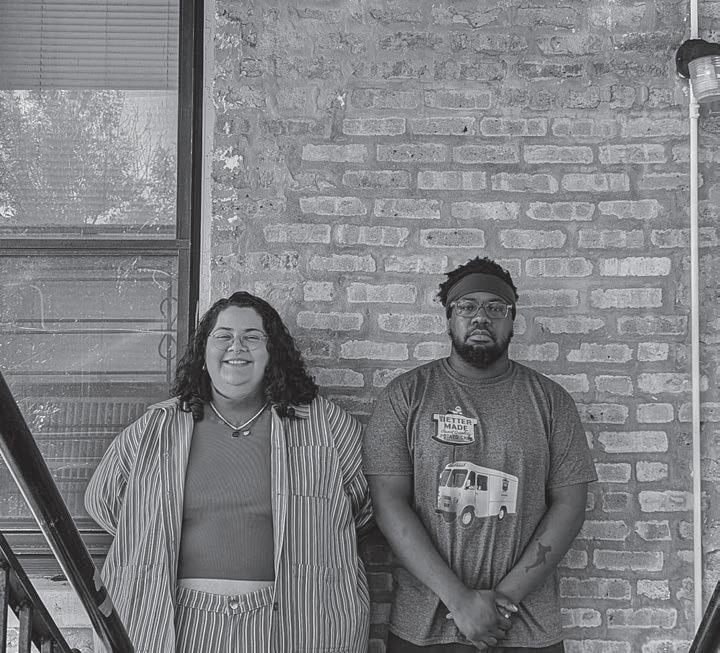
Magma, KÃrtëhl Seventh seventhrecords.com/en/magma-19/kartehl-1316.html
Formed by drummer Christian Vander in Paris in 1969, Magma have made a career of defying convention, and the fact that they’re still actively recording and playing live today is an astonishing gi . Their music could arguably be labeled modern classical, progressive rock, free jazz, or even psychedelia, but it’s too big for any of those boxes. Even the band couldn’t come up with an earthly word to describe what they do. Instead they chose “zeuhl,” a term from Kobaïan, a language of Vander’s creation and the mother tongue of the fictional planet Kobaïa, where all the ensemble’s concept albums have taken place (since the 70s, many other forwardthinking, cataclysmic ensembles have adopted the term “zeuhl” too).
I’ve followed this otherworldly, ecologically minded band since I got hip to them in the 90s, and I’ve been lucky enough to see them twice. Magma’s 14th album, 2019’s Zess , had a somber, dystopian vibe, but the new Kãrtëhl (on their own Seventh Records) has a more positive musical outlook and a lighter musical tone. Opener “Hakëhn Deïs” begins with a jazzy drumbeat before launching into odd time signatures that’d turn Gentle Giant green with envy.
Vander delivers its surprisingly melodic vocals alongside longtime collaborator Stella Vander (also his ex-wife), and the track builds to a grand, even sunny-sounding coda, with tasteful fuzz guitar edging its way in. Like most bands decades old, Magma have shi ed lineups several times, and the relatively new group that appears on most of Kãrtëhl jelled in 2020. They already sound exuberant, though, and keyboardists Thierry Eliez and Simon Goubert highlight the samba-inspired, almost tropical feel of “Do Rïn Ilï Üss” with their complex, dueling lines.
That said, Magma’s familiar gloomy and mysterious side also appears on the new album, notably on the operatic “Walomëhndëm Warreï,” which uses a choir of voices to gigantic and almost frightening effect. “Wiï Mëlëhn Tü” opens with massive, trebly bass courtesy of Jimmy Top (son of original bassist Jannick Top), mixed with some bizarre, high-pitched vocal warbling. Christian Vander’s bluesy lead singing sounds pained, in contrast to the redemptive voice of Stella Vander and the chirpy melodies of a female choir. The album’s series of ups and downs ends with the joyful “Dëhndë,” which almost sounds like a conventional soul-pop song or a tune from a hippie musical. Once I adjusted to its blindingly bright mood, I marveled again at how wide-reaching Magma are.
I should probably say “how wide-reaching Magma have always been,” because on the 1978 LP Attahk they delved into funk and soul, dividing their fans. Funnily enough, Kã rt ë hl features two bonus tracks recorded that same year, both of them demos chosen from Vander’s archives. They offer a fasci-
46 CHICAGO READER - SEPTEMBER 29, 2022 ll
MUSIC
Ben Zucker DEIDRE HUCKABAY
Discussing the Sun COURTESY LONELY GHOST RECORDS
continued from 45
nating glimpse into the band’s creative process, and even though they’re stripped down to just piano and voice, they’re still so intricately thought-out and weird that they sometimes sound like overreaching Beach Boys arrangements written on angel dust. Many legacy artists lose the plot by this stage of their careers, but Magma have been charting their own path for so long that they always seem to know where they’re going—and Kãrtëhl is an exciting new entry in their oeuvre. —STEVE KRAKOW
Doug McCombs, VMAK<KOMBZ<<<DUGLAS<<6NDR7<<<
Thrill Jockey thrilljockey.com/products/vmak-kombz-duglas6ndr7
If you’ve paid even the slightest bit of attention to Chicago music over the past, say, 35 years, you’ve surely heard Doug McCombs. He’s held down the low end for indie-rock legends Eleventh Dream Day since the mid-80s, acted as the heart and soul of postrock pioneers Tortoise since their founding in 1990, and helmed the shape-shi ing Brokeback since 1997. McCombs’s playing is rock-solid, sensible, and melodic, and while he’s best known as a bassist, on his first-ever solo LP, the brand-new VMAK<KOMBZ<<<DUGLAS<<6NDR7<<<, he applies his singular style mostly to acoustic and electric guitar explorations. With elements of minimal ambience, Ennio
Morricone-influenced twang, and his own signature Laughing Stock-flavored postrock bliss, McCombs dives into all sides of his musical self on the record’s three ruminative tracks—some expected, some new and surprising. The album’s side-length closer, “To Whose Falls Shadows,” layers ambient guitar and dreamy, rhythmic plucking to create something warm, heady, and transcendent. McCombs’s track record all but ensured that VMAK<KOMBZ<<<DUGLAS<<6NDR7<<< would be an instant classic of spaced-out perfection; if anything, it’ll make you wonder why it took so long to get a Doug McCombs solo album out into the world. —LUCA CIMARUSTI
Open Mike Eagle, A Tape Called Component System With the Auto Reverse
Auto Reverse openmikeeagle.bandcamp.com/album/a-tapecalled-component-system-with-the-auto-reverse Chicago-born, Los Angeles-based rapper Open Mike Eagle is a seemingly inexhaustible font of laugh-out-loud one-liners, and he delivers as always on his latest album, Component System With the Auto Reverse (on his own Auto Reverse label). You need to be careful drinking anything while listening to it, lest uncomfortable snorking ensue when the rapper gets to the best lines in “Peak Lockdown Raps”: “I got a discount code for therapy / I
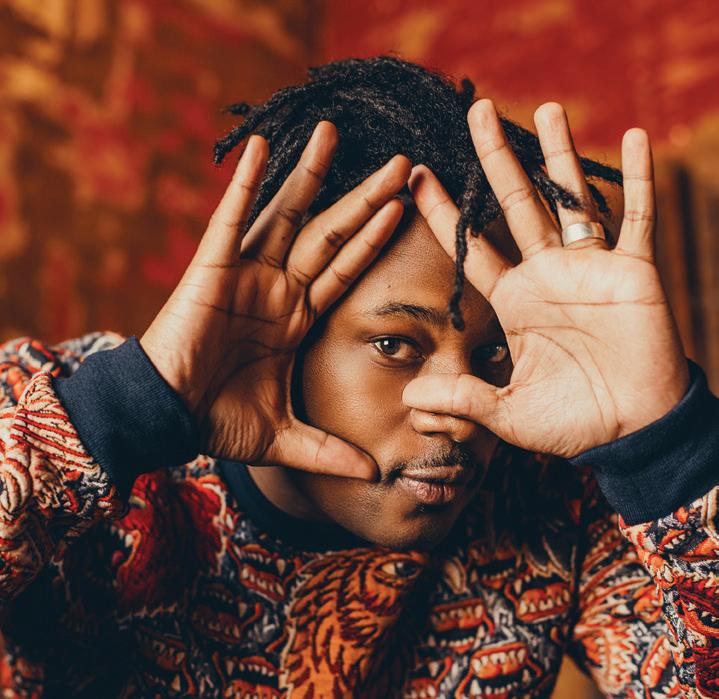
hit go and got Rickrolled, apparently / It was a big blow.” But funny as he is, fans don’t just tune in for the laffs. Inspired by the likes De La Soul and They Might Be Giants, Mike writes loopy gags that float and bob and tie themselves together into surprisingly thoughtful reveries on aging, mental illness, disappointment, and hope. His flow feels laid-back even as he chews up syllables at a rapid clip—as if he’s a stoned nerd who almost apologetically has to get out everything on his mind. On “79th and Stony Island,” he starts musing on watching the Kanye West documentary Jeen-Yuhs , goes on to cheerfully explain he’s got “memories like flesh wounds,” and finishes up by listening to his son laughing. Throughout the album, Mike weaves his thoughts on COVID, racism, and our bleak political landscape in and out of pop-culture references and goo all nonsense—which he uses less as distractions than as ways to hold firm to his humanity under threat. “It’ll be endless, I will fight you every day,” Mike croons on the hook of “I’ll Fight You.” It’s a joke, but he also means it. —NOAH BERLATSKY
Petbrick, Liminal Neurot/Rocket petbrick.bandcamp.com/album/liminal
Plenty of bands do a lot with compact lineups, but few can match the huge black-hole vortex of sound that Petbrick creates. The London-based
duo of British multi-instrumentalist and producer Wayne Adams and legendary Brazilian metal drummer Iggor Cavalera came together a few years ago with a plan to make “horrible noise” without compromise. But as Petbrick peeled away self-imposed limits, they wound up making something magical— and yes, as far as I’m concerned it’s magic when a band can bundle together cinema-worthy synth composition, D-beat, and experimental electronics and leave me wanting more. On their new second album, Liminal, Petbrick break their own mold again, exploring a planet in the throes of selfdestruction while twisting a mix of styles—industrial, noise, samba, hardcore, hip-hop—into their futuristic diatribes. Some of those sounds might seem like unlikely bedfellows, but despite Petbrick’s disorienting atmospheres, listening to Liminal feels a lot like reading a page-turner of a sci-fi novel. Assisting them in their mission are a handful of guest vocalists who enhance their explorations: Converge’s Jacob Bannon peels the paint off the walls with his performance on “Grind You Dull,” while New York rappers Lord Goat and Truck Jewelz drop verses on “Lysergic Aura,” which could soundtrack a hallucinatory voyage to the underworld and back. One of the most powerful tracks is “Distorted Peace,” a doomy, droning missive featuring vocalist Paula Rebellato of Brazilian psych trio Rakta. Petbrick’s alternate world might be a dystopia, but it still offers an excellent escape from the daily realities of the one we’re in now. —JAMIE LUDWIG v

SEPTEMBER 29, 2022 - CHICAGO READER 47
Find
more
music listings at chicagoreader.com/musicreviews
MUSIC
Open Mike Eagle R. GARDINER
Petbrick AL OVERDRIVE
EARLY WARNINGS
Magic City Hippies, Capyac 1/28/2023, 9 PM, Metro, 18+ Marcus Atom, Oddcouple 10/27, 8 PM, Golden Dagger
Arlo McKinley, Buffalo Wabs, Price Hill Hustle 10/15, 7:30 PM, Hideout
Micro TDH 11/17, 8 PM, House of Blues, 17+ Minuit Machine 10/27, 8 PM, Burlington
Allen Moore, Hedra Rowan, Mrs. Hands, Hameedullah 10/19, 8:30 PM, Empty Bottle
Moshun, Ivy Hollivana, Yomí, Composuresquad 11/17, 8 PM, Golden Dagger
b ALL AGES F
Never miss a show again. Sign up for the newsletter at chicagoreader. com/early
GOSSIP WOLF
Simi COURTESY THE ARTIST
NEW
Marcus Adams 10/21, 7 PM, the Promontory b Aesthetic Perfection, Josie Pace, Gencab, and more 10/23, 7 PM, Bottom Lounge, 17+
Marisa Anderson 11/19, 8:30 PM, Constellation, 18+ Andrés, Gold Necklace 10/14, 6:30 PM, Cobra Lounge b Angelenah, Showyousuck, Greensllime, DJ Teawhy 10/13, 8 PM, Golden Dagger
Automatic 10/23, 8:30 PM, Empty Bottle
Beloved 10/17, 7:30 PM, Sleeping Village
Big Bird, Still Alive, Intolerable Swill 10/14, 9 PM, Gman Tavern
Bitchin Bajas 10/16, 8:30 PM, Constellation, 18+ Bnat el Houariyat & Esraa Warda 10/19, 8:30 PM, Maurer Hall, Old Town School of Folk Music b
Tyler Bryant & the Shakedown 11/19, 9 PM, Reggies Music Joint
Bulldozer, Deceased, Ares Kingdom, Demiser 11/19, 8 PM, Reggies Rock Club, 17+ Calicoloco, Pinksqueeze, OK Cool 10/28, 8 PM, Golden Dagger
Chise Up and more 10/26, 8 PM, the Promontory Church of Cash 10/14, 9 PM, FitzGerald’s Country Westerns, Glyders, Cat Mullins & the Holy Lonesome 11/16, 9 PM, Sleeping Village
Cozyboy, Foster, Thomas Reid, Arkaeo, Eliza Grace, Woven in Hiatus, Mookigang, Le Play, 6host, and more 12/9, 8:30 PM, House of Blues, 18+ Carl Craig, Aathee 10/21, 10 PM, Smart Bar
CupcakKe 10/28, 9 PM, Chop Shop, 18+
DakhaBrakha 2/26/2023, 7:30 PM, Patio Theater b
Dalawari/Landgraf 6tet 11/3, 9 PM, Hungry Brain
Dave East 11/2, 8 PM, Avondale Music Hall, 17+
Dombresky, Noizu 11/11, 11 PM, Concord Music Hall, 18+ Doom Flamingo 11/11, 11:59 PM, Metro, 18+
Dreamjacket, Joe Baughman & the Righteous Few, Jacob on the Moon, OK Cool 11/5, 8 PM, Burlington Drive-by Truckers 11/18, 8 PM, Thalia Hall, 17+
DRK Nite day one featuring We Weren’t Invited, Scarlet Demore, Calico Plaid, Isn’t It Strange, Attaguns 10/28, 6 PM, Subterranean, 17+
DRK Nite day two featuring Kangaroo Court, Totally Cashed, X Will Mark the Place, True Loathing, Weighted 10/29, 6 PM, Subterranean, 17+
Dry Cleaning 1/13/2023, 8:30 PM, Thalia Hall, 17+
Emarosa 12/3, 8 PM, Bottom Lounge b Emlyn 12/10, 7 PM, Beat Kitchen b
Exquisite Corpse Ball featuring Good, Que Rico, Kid Million, Seth Limmer, and more 10/28, 9 PM, Beat Kitchen
Samantha Fish, Jesse Dayton Band 12/16, 7:30 PM, Park West b Flor de Toloache 11/8, 8 PM, Sleeping Village
Chico Freeman Quartet 10/2710/29, 8 and 10 PM; 10/30, 4 and 8 PM, Jazz Showcase b Genocide Pact, No/Mas, Vomit Forth, Mellow Harsher 11/15, 8 PM, Cobra Lounge, 17+ G-Nome Project 11/10, 8 PM, Bourbon on Division
Halloqueen! featuring Derrick Carter, Michael Serafini, Garrett David, Lauren Flax, Mark Grusane, the Jak 10/30, 9 PM, Metro and Smart Bar Erwin Helfer 10/13, 6 PM, Hideout
Joe Hertler & the Rainbow Seekers, Próxima Parada 10/15, 9 PM, Chop Shop, 18+
Gary Hoey 12/8, 8 PM, Bananna’s Comedy Shack at Reggies Homesafe 12/1, 6:30 PM, Cobra Lounge b Honeyluv, DJ Inphinity 10/15, 10 PM, Spy Bar
Humbird, Sprig of That 11/19, 8 PM, Golden Dagger Hyd, Umru 11/7, 8 PM, CoProsperity, 18+ Incite 12/14, 8 PM, Reggies Music Joint
JeJaWeDa 10/20, 9 PM, Hungry Brain
Joe Pug 12/2-12/3, 9:30 PM, Hideout
Joey Aich, Morgan Gold, Dom Deshawn 11/3, 8 PM, Golden Dagger
Johnnyswim 11/30, 8 PM, Fourth Presbyterian Church b
King Buffalo, Howling Giant 11/17, 8 PM, Sleeping Village
King Buffalo, Lume 11/18, 9 PM, Sleeping Village
Sonny Landreth & Cindy Cashdollar 11/2, 8:30 PM; 11/4, 8:30 PM, FitzGerald’s Lollygagger, Deadlights, Absolute Phase, Gorilla Social 10/20, 8 PM, Burlington
Louis the Child, Lupe Fiasco, Levity 11/25, 10 PM, Radius Chicago, 18+
Louis the Child, What So Not, Nez 11/26, 10 PM, Radius Chicago, 18+
Lera Lynn 10/14, 8 PM, Szold Hall, Old Town School of Folk Music b
Nappiano: A Night of Amapiano featuring Major League DJz, Mike Orie, Bonita Appleblunt, Mike Abrantie 10/15, 10 PM, the Promontory Neck Deep 11/2, 6:30 PM, Bottom Lounge b O’My’s 12/1, 9 PM, Sleeping Village Painted Canyon, Jory Avner, Alanna Matty, Dan Young 10/25, 8 PM, Golden Dagger Panic Priest, Iron Years, Clubdrugs, DJ Scary Lady Sarah 10/20, 9:30 PM, Hideout Patriarchy, Choke Chain 11/3, 8:30 PM, Empty Bottle
Peace Simulation Vol. II day one featuring Liturgy, Indian, John Wiese, A.S.M., Miasmatic Necrosis, Thantifaxath, Elizabeth Colour Wheel, Anatomy of Habit, Infant Island 12/10, 1:15 PM, Reggies Rock Club, 17+
Peace Simulation Vol. II day two featuring Wayfarer, Gloryhole Guillotine, Wake, Reek of Divinity, Bloodyminded, Midwestlust 12/11, 1 PM, Beat Kitchen, 17+ DJ Pierre, Noncompliant, Brenda, Mark Angel 10/14, 10 PM, Spy Bar
Pinkshi , Jigsaw Youth, Yasmin Nur 10/26, 6:30 PM, Cobra Lounge b Margo Price 10/23, 7 PM, Maurer Hall, Old Town School of Folk Music b Pure Intention, Atheena, Nikko Blue, No Hitter 10/18, 8 PM, the Promontory b Rare Americans 10/16, 7:30 PM, Thalia Hall b
The Ready Set 11/5, 8 PM, Cobra Lounge b Marcus Rezak 10/28-10/29, 11:30 PM, Bourbon on Division
Jonathan Richman & Tommy Larkins 10/27-10/28, 8:30 PM, Constellation, 18+ Kevin Saunderson, Shaun J. Wright 10/14, 10 PM, Smart Bar
DJ Joe Shanahan 10/15, 3 PM, Gman Tavern F
She Wants Revenge, Chameleons, D’Arcy 11/6, 9 PM, Metro, 18+
Will Sheff 11/5, 8 PM, Maurer Hall, Old Town School of Folk Music b
Shinyribs 10/26, 8:30 PM, FitzGerald’s Shukin & the Ramblers, Loose Cannons, Collin Marks 10/29, 7 PM, Gman Tavern Simi 10/20, 8 PM, the Promontory, 17+ Skullcrusher, Babehoven, Mal 11/20, 8 PM, Sleeping Village Slaughter to Prevail 11/2, 8 PM, Concord Music Hall, 17+ Slow Planes, Reid Karris 10/21, 9 PM, Hungry Brain Smoking Popes, Off With Their Heads, Limbeck, the Color Fred 11/12, 8 PM, Bottom Lounge, 17+ Special Consensus 10/28, 8:30 PM, FitzGerald’s Mavis Staples 2/4/2023, 8 PM, Symphony Center b Static-X, Dope, Twiztid, Fear Factory, Cultus Black 4/7/2023, 6:30 PM, House of Blues, 17+
Superjane 25 Year Anniversary featuring Colette, DJ Heather, DJ Lady D, Dayhota 10/22, 10 PM, Smart Bar Deb Talan 12/9, 8 PM, Szold Hall, Old Town School of Folk Music b
Tenci, Macie Stewart 11/19, 9 PM, Sleeping Village Unwound 3/7/2023-3/8/2023, 8:30 PM, Thalia Hall, 17+ Chucho Valdés 10/18, 8 PM, Symphony Center b Jarreau Vandal, Mike Orie, Slot-A & Aced Spade 11/18, 9 PM, Chop Shop, 18+ Vrywvy 11/5, 8 PM, Bourbon on Division
Wheatus, Fat Tony, Reyna 10/22, 7 PM, Cobra Lounge b Wild Nothing 11/16, 8 PM, Metro, 18+
Wolf Eyes, Rush Falknor 10/16, 8:30 PM, Empty Bottle
UPDATED
Amy Shark 10/28, 7:30 PM, Park West, canceled
Anne-Marie 12/1, 8 PM, Park West, canceled
UPCOMING
Topaz Jones 10/17, 8 PM, Schubas, 18+

L7 10/15, 7:30 PM, Metro, 18+
No Age, Dream Mega, Lifeguard 10/16, 8 PM, Subterranean
They Might Be Giants 10/13, 8 PM, the Vic, 17+ v
A furry ear to the ground of the local music scene

GOSSIP WOLF HAS long believed that physical releases from Fire-Toolz , the wonderfully disorienting flagship project of local electronic musician Angel Marcloid , will one day be swapped among fans and sought out in record shops like original pressings from Sun Ra’s Saturn label or early Trax Records singles. Marcloid is famously prolific, and the merch on her Bandcamp page now includes an awesome Fire-Toolz bucket hat, a spectacularly colorful fanny pack—and of course a new Fire-Toolz EP, which she’ll self-release on Tuesday, October 11. The lyrics on the 30-minute release I Will Not Use the Body’s Eyes Today. are as varied in their themes as Marcloid’s genre- obliterating, rigorously dense music is in its sound: she lists as influences “Vedic philosophy; Christian mysticism; fear of abandonment; emotional disconnection; attachment insecurity; self-sabotage; spiritual inclinations of consciousness; trauma healing; shame; emotional safety; connection to/interaction with God/source/spirit.” Fire-Toolz will perform as part of the one-day music fest hosted by local pressing plant Smashed Plastic on Saturday, October 1, at Workshop 4200 (4200 W. Diversey).
Autumn usually means the end of street fests, but the Empty Bottle is squeaking in one more. On Saturday, October 1, the Bottle hosts the second annual Thee Best Western block party on Cortez east of Western. The party has a doozy of a lineup, and aside from Brooklyn singersongwriter Steve Gunn (who headlines) and Louisiana punk oddballs Spllit, everyone is from Chicago: Floatie , Gabacho , Fran , and Tommy Goodroad . The show starts at noon, and it’s free and all ages!
On Friday, September 30, rough-andtumble Chicago punk band Nora Marks release The Buzzing of Flies on Take a Hike Records, run by Bridget Stiebris and Haley Blomquist of OK Cool . That night, Nora Marks headline Gman Tavern ; Cut Your Losses, OK Cool, and Pinksqueeze open. —J.R. NELSON AND LEOR GALIL
Got a tip? Tweet @Gossip_Wolf or email gossipwolf@chicagoreader.com.
48 CHICAGO READER - SEPTEMBER 29, 2022 ll
CHICAGO SHOWS YOU SHOULD KNOW ABOUT IN THE WEEKS TO COME
WOLF BY KEITH HERZIK

SEPTEMBER 29, 2022 - CHICAGO READER 49
SAVAGE LOVE
DEAL OR NO DEAL
My wife slut-shames me when I hook up with someone else
She might just be annoyed with the arrangement.
By DAN SAVAGE
Q : Forty-two-year-old dad here. I’ve been married for 12 years, and my marriage has been somewhat turbulent. But a er some affairs—one where my wife screwed my best friend—and therapy, we reconnected, righted ourselves, and started a wonderful family. We both identify as bisexual now, and we are ethically nonmonogamous. My question is this: my wife never seeks out other lovers, but I o en do. She thinks looking for sex on apps is gross and won’t try it. She did recently suggest we become poly— that we date other couples together—only to shut that down a er one date with another couple. She also kind of slut-shames me when I ask permission to hook up or date someone else. She wants to be open in theory, but she seems to be against it in practice. We communicate well and she continues to give me permission (but always a er shaming me), and I check in regularly only to have her act annoyed when I inform her of each new adventure. I am not sure what to do.
—OFTEN PRACTICING ETHICAL NONMONOGAMY
A : Has it occurred to you
that maybe . . . just maybe . . . your wife doesn’t wanna hear about each and every one of your adventures? Or any of them? I mean, it seems clear to me she doesn’t want to hear about them. It’s all right there in your letter: your wife doesn’t enjoy discussing your dates, hookups, adventures, etc., and yet you persist in asking her and telling her.
You mention “some affairs” earlier in your marriage, OPEN, back before you came out to each other as bisexual and opened your relationship. But you only share the details of one: your wife fucked your best friend That had to hurt. I’m glad you two got into therapy, managed to work through the fallout, got to a better place, and decided to start a family together. But I feel like I don’t have all the relevant information here—like whose idea opening up was (yours?) and your wife’s state of mind when she agreed (guilt-racked?)—which means I have no choice but to speculate . . .
You’ve been married for 12 years, you started a family sometime after that turbulent period, which means your kid or kids are still young and may be very young. Your wife could be interested in other sex partners but lacks the
energy for them right now, seeing as she’s doing . . . judging from your letter . . . way more than her fair share of the parenting. I mean, if you’re constantly running off on dates and hookups and having adventures and leaving her home alone with the kid(s), it’s possible that your wife is annoyed with you and you’re reading her annoyance as slut-shaming.
ing up the relationship and she agreed to it—after she fucked your best friend— maybe she doesn’t feel free to say no when you ask for permission to fuck someone else, which could also leave your wife annoyed. Annoyance that, again, you could be reading as slut-shaming.
were married to someone who agreed to open the relationship but who seemed annoyed or upset or slutshamed me whenever I asked for their OK to go fuck someone else, I would have a few questions for my spouse: Do they want an open relationship at all? Did they ever? Do they still? And if they did and still do, would they prefer a DADT (“don’t ask, don’t tell”) arrangement over a TMFE (“tell me fucking everything”) arrangement?
I think a few check-in/ checkup sessions with your couples’ counselor are in order here. Maybe your wife’s feelings have changed, after having a kid (or kids). Or maybe your wife—cheater though she was—would prefer a monogamous relationship after all. Or, hey, maybe your wife is happy for you to fuck other people but would like to see—at least while your kids are young—you dial back your adventuring and
says, because we love each other too much. We have a wonderful, loving, and creative sex life otherwise. (And, yes, I eat her pussy.) She has my OK to suck off other men, which happens once or twice a year, and I have her OK to get sucked off by other women, which never happens. Finding men who want no-stringsattached blow jobs from a hot married woman is obviously easier than finding
men at my gym (the locker room is a scene), and I’ve honestly been tempted to close my eyes and think about it being a woman. My wife isn’t comfortable with the idea because she thinks gay men are likelier to have STIs and she doesn’t want me bringing anything home. I think she’s being a bigot.
—SEEKING UNDERSTANDABLE COMPROMISE KNOWING ERECTIONS RARELY SUCKED
MUSIC

Chicago Community Calendar
Comprehensive listings of concerts and music events from a wide variety of event organizers —including Reader readers.


50 CHICAGO READER - SEPTEMBER 29, 2022
LISTINGS




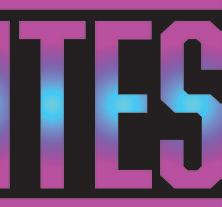






SEPTEMBER 29, 2022 - CHICAGO READER 51 Enter to win! chicagoreader.com/contests Baje sus pagos mensuales. Salga de la deuda más rápido. Reduzca sus tasas de interés. ¿Está luchando con sus deudas de tarjetas crédito? Reduzca su deuda y viva sin estrés, ¡sin declararse en quiebra! Me sorprendió lo fácil que fue. Una vez que hice la llamada, el agente se encargó de todo. Fue agradable obtener los altos pagos de mi espalda. Me gustó cómo nadie me hizo sentir mal por endeudarme. Eran muy comprensivos. Todo me fue explicado y estoy trabajando hacia un lugar mejor nancieramente. RATED #1 – Carlos de California Based on 29,994 Reviews – Maria en Florida Hemos ayudado a más de 500,000 clientes como tu. Llame Desde: Lunes a Viernes: 6am to 8pm Sabado: 8am to 4:30pm PST A+ 1-888-523-4506 Consulta GRATIS ✆
CLASSIFIEDS
JOBS
Northwestern Memorial HealthCare seeks Sr. Supply Chain Analyst for Chicago, IL location to compile & analyze reports to ID opps for cost savings, improved supply utilization, standardization, & process improvement. Master’s in Supply Chain Mgmt/Industrial Eng/related field + 3yrs exp req’d. Req’d Skills: Required Skills: 2 years w/: reporting data in a SCM, Finance, or Clinical area using Tableau; Supply Chain ERP; business process improvement; workflow design; project management; descriptive analytics. Exp must incl: Excel (incl. formulas, pivot tables & Macros/ VBA); Dashboard design. APICS or other Supply chain certi cation re ’d. Background check & drug test req’d. Apply online: http://jobseeker .nm.org/ Req ID: REF41245T
Senior Business Consultant - Document and improve both business processes and pricing models and lead implementation of customized Configure Price Quote (CPQ) software applications for our clients, primarily manufacturing firms. Req’d: 3yrs experience, bachelor’s degree in Mechatronics Engineering, Mechanical Engineering, Industrial Engineering, or any Engineering eld. Resume to: HR, Directpl USA, Inc., 211 West Wacker Drive, Floor 3 - Suite 300, Chicago, IL 60606
JOBS
Northwestern Memorial Healthcare seeks Sr. Analytics Developers for Chicago, IL location to deliver data warehouse & analytic solutions. Bachelor’s in Comp Sci/ Info Sys/related field +4yrs exp req’d. Req’d Skills: 4yrs: querying & analyzing data; create complex queries & stored procedures; SSIS; SQL Server; SQL; solution analysis, design, development, support & structured programming; Agile enviro. Exp must include: SQL for data extraction, manipulation & reporting; SSRS; healthcare claims & eligibility data; building pipelines, data warehouses & marts. Background & drug test req’d. Apply online: http://jobseeker. nm.org/ Requisition ID: REF41178B
Apex Fintech Services LLC seeks Senior Product Manager in Chicago, IL to dvlp & document detailed product requirements. Reqs. Master’s degree or foreign equiv in Computer Science, Computer Engineering or rel. eld & 2 yrs post-baccalaureate exp. as Lead Systems Engineer/Analyst, Product Engineering Manager or rel. role. Exp. must incl. leading implementation, enhancement and complex data integration and producing detailed business and functional requirement specifications using Java, SQL, Perl, Oracle, MongoDB, Junit, Cucumber, Splunk, InfluxDb, Hawt I/O. Mail resume: Apex Fintech c/o M. Anderson, 141 W. Jackson Blvd. Ste 500, Chicago, IL 60604.
Caregiver Responsibilities:
Assisting with personal care, Following a prescribed healthcare plan, Ensuring my Mother home is organized according to her needs.
SERVICES
Operations Manager: Direct, coord activities of employees of constr comp for optimum efficiency to max profits. Plan & develop org policies & goals. Coord marketing, sales, advertising. Comm w/ clients, employees, subcontractors. Resp for marketing campaigns. Plan/ manage business budget. Analyze financials. Prep contracts, proposals & estimates for constr bids. Prep docs for accountant, 2 yrs exp as operations manager or in any business management related position. HS. Must speak Polish. Res: All Concrete Chicago, Inc. 9707 S 76th Ave, Bridgeview IL 60455
Providing mobility assistance may be required, for example helping my Mother with her motorized wheelchair, appointments, grocery. Meal and watch over. Work Schedule is 5 days a week and 5 hours per day. Salary is $26/hr. Contact by email Daniel (dajcahh@gmail. com) for more details.
UBS Business Solutions US LLC seeks AD, Multi Stack .NET Developer for Risk Solutions in Chicago, IL. Support & transform risk platform to a service-oriented platform. Reqs: Bach deg or foreign equiv in Elec Eng, Comp Sci, IT Tech, or rel fld & 5 yrs of reltd exp. Will alt acpt Mas & 3 yrs. Qualified Applicants apply through SH-ProfRecruitingcc @ubs.com. Please reference 001006. NO CALLS PLEASE. EOE/M/F/D/V.
Blucapsoft LLC has openings for the positions: Software Developer with Master’s degree in Computer Science, Engineering any, Technology. Information Systems or related to design, develop, implement, maintain and test business functions and web applications using a variety of languages, tools, methodologies and technologies. Analyze user needs and develop software solutions. Design software or customize software for client use with the aim of optimizing operational efficiency. Design and execute QA tests using Python scripts that automatically test functionality. Responsible for writing the Test Cases/Verification procedures and reports generation. ServiceNow Developer with Master’s degree in Computer Science, Engineering (any), Technology or related to Involve in creating users, groups, roles and load the data to service now using import sets. Involve in performance analytics for creating reports, dashboards in ServiceNow. Provide advanced support for Service-Now by troubleshooting a variety of difficult software problems, implementing bug fixes and performing root cause analysis. Responsible for implementation and administration of ITSM and Custom Application Development in ServiceNow. Work location is Chicago,IL with required travel to client locations throughout the USA. Please mail resumes to 4001 W Devon Ave, Suite 202, Chicago,IL 60646 (OR) e-mail: zubair.muhammad @blucapsoft.com
Electronic Interconnect Corporation seeks Vice President – Global Development for Elk Grove Village, IL, to develop marketing strategies to enhance revenue growth. Bachelor’s in Business Admin/related eld +3yrs. exp req’d. Skills Req’d: Creating marketing strategies targeting Indian & Southeast Asian Markets; exp. in client facing roles; creating & administering internat’l sales mgmt processes; sales analytics; mgmt of channel partner networks; identifying & screening targets; structuring negotiation; internat’l business agrmnt mgmt. Travel to various client sites as needed. Up to 20% travel req’d. Send resume to: hr@eiconnect. com. Ref: RR, 2700 West Touhy Ave, Elk Grove Village, IL 60007.
(Lincolnshire, IL) Nexus Pharmaceuticals Inc. seeks Analytical Scientist II w/ Bach or for deg e uiv in Chem or rltd fld & 7 yrs exp in job o ered or as Analy Sci, Analy Chem or Chem (also acceptable Mast & 5 yrs exp or PhD & 2 yrs exp). Must have 2 yrs exp in HPLC, GC & ICP/MS method dvlpmt & valdn; analy dvlpmt & method valdn for pharm & inject & chem & analy proc. Apply to HR, 400 Knightsbridge Pkwy, Lincolnshire, IL 60069 or online https://www. nexuspharma.net/ careers/
(Lincolnshire, IL) Nexus Pharmaceuticals Inc. seeks Formulation Scientist II w/PhD or for deg equiv in Pharmaceutics, Ind Pharma, Pharma, or rltd fld & 1 yr exp in the job o ered or formul dvlpmt skills for pharma or injectables (also acceptable Mast & 2 yrs exp). Must have ANDA/NDA exp relevant to formulation dev & regul doc submissions & exp/w pharma dosage forms, injectables. Apply to HR, 400 Knightsbridge Pkwy, Lincolnshire, IL 60069 or online https://www. nexuspharma.net/ careers/
Software Engineer, Bijora, Inc. dba AKIRA, Chicago, IL. Provide & implement front & backend solutions for both e-commerce site & retail/ fulfillment systems in a Magento platform. Develop procedures & apps. Analyze scripts & create code. Build & maintain internal integrated systems. Design & create the optimal software architecture. Oversee third party developers. Req: Bach/comp eng, comp sci or related field (or foreign equiv) + 2 yrs exp designing, developing & integrating e-commerce websites & other retail/ ful llment systems under Magento Framework using PHP, Javascript, XML, & CSS. Email resume to lwalters@ shopakira.com.
(St. Charles, IL) Nidec Mobility America Corp seeks Test Engineer (Labview) w/ bach or for deg equiv in EE or Electron Eng & 3 yrs exp in job offer or in testing envir. Also accepts MS & 1 yr exp. Must have 1 yr exp w/ test sys dev w LabVIEW prog lang & test sys integ w/ elec assembly & LEAN mfg & princip. Apply to HR: 3709 Ohio Ave, St. Charles, IL 60174.
Tegus (Chicago, IL) seeks Software Engineer to work on design & implementation of new products or enhancements to existing products. Remote work option. Apply at tegus.co/careers, Job ID: Software Engineer, Chicago, IL
Horizon Therapeutics USA, Inc. is seeking an Associate Medical Director, Clinical Development in Deerfield, IL. Perform clinical trial protocol writing and study conduct oversight. Reqs: M.D. or equiv degree & 3 yrs rel. exp. To apply: Go to: https://horizon.wd1. myworkdayjobs.com/ Horizon/job/Deer eld-IL/ Associate-Medical-Director--Clinical-Development_R0004223 to submit cover letter & resume.
StoneX Group Inc. seeks a Senior Software Engineer (Job Code 3278) in Chicago, IL to execute rapid raw data collection from source systems; target and implement e cient storage of data, and employ fast and reliable access patterns; independently develop a full software stack. Please visit https:// www.stonex.com/ careers/ to apply. Job Req. ID # 3278. EOE.
(Chicago, IL) 1WorldSync, Inc seeks Windows Network Administrator w/Bach or for deg equiv in eng, IT or rltd fld & 4 yrs exp in job o ered or maintain Windows-based client environ. Must have 4 yrs exp w/Windows virtual serv environ maintained on VMWare or other virtual tech & network des & admin & 3 yrs exp monitor & remote mgmt of end point dev & using Windows PowerShell. Occ travel reqd. Apply online https://1worldsync.com/ es/careers/ or to HR, 300 S Riverside Plaza #1400, Chicago, IL 60606.
(Vernon Hills, IL) Fuji America Corporation seeks Applications Engineer w/Bach or for deg equiv in IS, CIS, Electron Eng, Manuf Eng or a rltd fld & 3 yrs exp In job o er or in eng. Must have 3 yrs exp reading part drawings from cust & simulating part drawings w/complex SW in a manuf proc environ. Apply to HR, 171 Corporate Woods Pkwy, Vernon Hills, IL 60061 or online https://www.fujiamerica. com/hr.aspx.
Thoughtworks seeks Lead Consultant Developer (Professional Services) to work in Chicago, IL & various unanticipated U.S. locations to lead largescale, custom-designed, enterprise-level software development projects that use object-oriented technologies, such as Java, Ruby, or .NET.
Requires Bachelor’s in Computer Science, Computer or Electrical Engineering, Information Systems, or related eld. Will accept a single degree or any combination of degrees, diplomas, professional credentials or professional experience determined to be e uivalent by a uali ed evaluation service. Must have 2 yrs exp. in the job offered, Consultant, Developer, or related IT occupation. Must have at least 24 mos. exp. (1) Participating at all stages of the software delivery life-cycle, including analysis, development, testing and deployment; (2) Leading a team of software engineers to oversee project activity, manage project deliverables and progress, prioritize plans for future iterations, and manage team performance. Must have at least 12 mos. exp. (1) Using Agile development methodologies including Continuous Integration, Extreme Programming, Continuous Delivery, Test-Driven Development and pair programming; (2) Using test automation frameworks to test at different levels, including unit, functional and integration testing; (3) Developing software applications using Java, Ruby or .NET; (4) Serving as a liaison between client and development team to de ne scope and technical direction of the project including re uirements gathering and design discussions and managing project deliverables and timeframes; (5) Working on projects with distributed teams, including managing coordination across countries and time zones; and (6) Coaching and mentoring junior developers in all aspects of software development, including Agile development methodologies. At least 80% travel across U.S. Send resume to ijobs@ thoughtworks.com w/ Job ID MV-LCD2022.
Des Plaines Clinical Lab, Inc. d/b/a NTL Laboratories seeks an Medical Laboratory Technologist. Mail resume to 8833 Gross Point Road, Suite 308, Skokie, IL.
DePaul University seeks Professional Lecturers for Chicago, IL location to teach courses to grad & undergrad students in the Dep of Writing, Rhetoric, & Discourse. Ph.D. or ABD in English/ related eld re ’d. Re ’s: submit a cover letter, CV, teaching statement, & research statement. Send resume to: J. Bokser, 1 East Jackson, Chicago, IL 60604
Federal Home Loan Bank Chicago is seeking a Sr. Credit Risk Analyst in Chicago, IL. Lead the assessment, development and redesign of processes; serve as a general technology resource and advisor to the Credit team on the ways data extraction or analysis tools can be useful to improve analysis, presentation, or communication of information. Blended operating model, employees can work from home 3 days per week and must live within commuting distance of o ce. Apply on-line at fhlbc.com/ careers.
Software Developers, Schaumburg, IL: Participate in all phases of system development, deployment, configuration, & monitoring including performance and availability, alerting, data integrity, security, & Disaster Recover planning. Working as application performance requirements liaison between the customer & development, operations, & infrastructure teams. Travel/reloc to various unantic locs. Send res to: Rigelsky, Inc. at 120 W Golf Rd, Suite 106, Schaumburg, IL 60195 or email: farheen@rigelsky. com
Inbound Specialist. Req’d: BA’s in Business Admin., Transportation and Logistics MGMT., or related. Work Site: Wood Dale, IL 60191. Mail Resume: ALLSTATE INT’L FREIGHT USA INC., 1250 W Artesia Blvd., Compton, CA 90220
IMC AMERICAS, INC. (Chicago, IL) seeks experienced professional Traders to develop, maintain, and enhance mathematical models, algorithms, and strategies for quantitative proprietary trading. Interested candidates should send resume to: talent@ imc-chicago.com with Traders in subject line.
classified-ads@chicagoreader.com
52 CHICAGO READER - SEPTEMBER 29, 2022 ll
GENERAL REAL ESTATE RENTALS FOR SALE NON-RESIDENTIAL PROFESSIONALS & SERVICES CLEANING RESEARCH ADULT
WANT TO ADD A LISTING TO OUR CLASSIFIEDS? Email details to
(Lincolnshire, IL) Nexus Pharmaceuticals Inc.
seeks Formulation
Scientist III w/PhD or for deg equiv in Pharmaceutics, Ind Pharma Pract, Pharma, or rltd fld & 3 yrs exp in job offered or ANDA/NDA exp relevant to formul dev & regul doc submissions (also acceptable Mast & 5 yrs exp). Must have exp in pharma dosage forms & injectables. Apply to HR, 400 Knightsbridge Pkwy, Lincolnshire, IL 60069 or https:// www.nexuspharma .net/careers/
RESEARCH
Have you had an unwanted sexual experience since age 18? Did you tell someone in your life about it who is also willing to participate?
Women ages 18+ who have someone else in their life they told about their experience also willing to participate will be paid to complete a confidential online research survey for the Women’s Dyadic Support Study.
Contact Dr. Sarah Ullman of the University of Illinois at Chicago, Criminology, Law, & Justice Department at ForWomen@ uic.edu, 312-996-5508. Protocol #2021-0019.
RENTALS & REAL ESTATE
2br - 1400ft - Rent Free Apt for Senior (Evanston)
Do you have a senior mother (or yourself) who would like to share a large, two-bedroom apartment (private bathroom) with women who is blind and elderly (my mother). Most of the home care hours are covered by caregivers and family, but we need someone to be at the apartment overnight (9PM to 9AM) and be in the apartment at least 1-5PM daily. She doesn’t need overnight care, just someone home in case of emergency. Female, Background check, proof of vaccination. Non-smoker. pkvision@ hotmail.com
Remodeled 1Bed/1Bath garden apt, West Rogers Park New Bathroom, Kitchen, Floors, Appliances, Laundry Room on Premises, Heat Included. Near LSD and Edens/Kennedy. 5845 N. Maplewood. 7732933399
PROFESSIONALS & SERVICES
CLEANING SERVICES
CHESTNUT ORGANIZING AND CLEANING SERVICES: especially for people who need an organizing service because of depression, elderly, physical or mental challenges or other causes for your home’s clutter, disorganization, dysfunction, etc. We can organize for the downsizing of your current possessions to more easily move into a smaller home. With your help, we can help to organize your move. We can organize and clean for the deceased in lieu of having the bereaved needing to do the preparation to sell or rent the deceased’s home. We are absolutely not judgmental; we’ve seen and done “worse” than your job assignment. With your help, can we please help you? Chestnut Cleaning Service: 312-332-5575. www. ChestnutCleaning.com
ADULT SERVICES
Danielle’s Lip Service, Erotic Phone Chat. 24/7. Must be 21+. Credit/ Debit Cards Accepted. All Fetishes and Fantasies Are Welcomed. Personal, Private and Discrete. 773-935-4995
WORK IN ADULT FILMS
No Experience, All Types, Sizes & Races! Call/Text AdultTalentX. com: 1-800-846-6180
MJM DOM 52 SEEKS
SUB HISPANIC FEMALE
MJM DOM 52 seeks submissive mature hispanic female who needs on going bare bottom spanking pleasure and punishment oral pleasure bondage and will train and seeking discreet LTR I can host call/ text-224-292-9899 em dragonmastercs69@ gmail.com
Submit
com/matches
Matches
are not

SEPTEMBER 29, 2022 - CHICAGO READER 53
your Reader Matches ad today at chicagoreader.
for FREE.
ads
guaranteed and will run in print and online on a space-available basis. e Chicago Reader is now biweekly More than 60,000 copies will be available at nearly 1,200 locations across the city and suburbs. Find one near you and/or download the current issue: chicagoreader.com/map Upcoming Issues: Cannabis Conversations The People Issue The Nonprofits Issue 2022 Year-in-Review Winter Theater & Arts Preview Oct. 13, 2022 Oct. 27, 2022 Nov. 10, 2022 Nov. 24, 2022 Dec. 8, 2022 Dec. 22, 2022 Jan. 12, 2023 Jan. 26, 2023 Feb. 9, 2023

















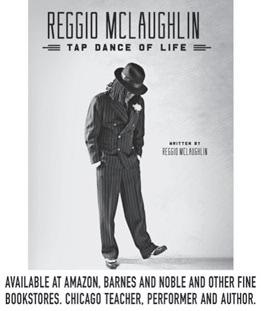

















54 CHICAGO READER - SEPTEMBER 29, 2022 ll Outside Noise Reduction Keeps Bugs & Spiders Out Reduce or Eliminate Fog & Water Noise from Outside? Visit stormsnaps.com or noisewindows.com sales@stormsnaps.com Alpina Manufacturing, Chicago, IL 1-800-915-2828 Soundproofing Window Inserts the platform The Chicago Reader Guide to Business and Professional Services To advertise, e-mail ads@chicagoreader.com home improvement legalbooks Fun, Clean, Picture Frame assembly JOB $18/hour Tired or bored of clicking away on a keyboard working at home? Keep your hands and mind busy with a fun, safe, clean assembly job. You’d have your own large assembly zone, at least 15-20 feet away from others, so we’re really safe here. Top rated rm Alpina Manufacturing LLC founded in 1992 Beautiful campus in Galewood, near Mars candy, 3 blocks north of Oak Park. We build and sell display framing systems to customers nationwide including Wal-Mart, Verizon, Circle K gas stations, Hospitals. Full time, Part time, Flex hours for working parents or students. We train, no travel, work in Galewood. Open to any backgrounds. Excellent pay, friendly caring management. Stop in anytime between 7am and 4pm M-F ask for Izzy to apply and check us out. Alpina Manufacturing 6460 W Cortland St., Chicago, IL 60707 Brigi e Schmidt Bell, P.C. 847-733-0933 lawyers@bsbpc.com Brigi eBell.com Brigi eSchmidtBellPC Considering Divorce? We Can Help. Collaborative | Prenuptual Divorce | Mediation mental health YOUR AD HERE dance What Greta said . . . 5301N.ClarkSt.Fl.2 CHICAGODANCESUPPLY.COM 773-728-5344 773-616-6969 1234/1250 S. Michigan Ave. In/out. Must call 8 am-9 pm. No annoying texts. European Relax Massage Licensed & Certified Cupping health & wellness shop local Customized Massage Therapy, Intuitive Energy Work, and Holistic Talk Therapy 2514 W Armitage Ave, Suite 211 Chicago, IL 60647 773-697-9278 www.intuithealing.com Open Thursday-Monday BY APPOINTMENT ONLY A Matter of Consequences by Michael W. Falls Available on Amazon and Booklocker A Classic Chicago Mystery
BEST OF HAWAII





Hawaii Island
CRUISE




Kauai
Enjoy a fully guided 4-island Hawaiian vacation with centrally located lodging in Waikiki on Oahu, and beachfront lodging on the “Big Island” of Hawaii, Kauai, and Maui. Guided throughout by our friendly Tour Directors—your local experts. Includes 3 inter-island flights.

Maui

Visit Denali National Park and












SEPTEMBER 29, 2022 - CHICAGO READER 55 the cannabis platform a Reader resource for the canna curious www.neuromedici.com 312-772-2313 Findouttoday ifmedical cannabisorinfusiontherapyis rightforyou.Telemedavailable! Yourpartnersinhealthandwellness. Serving medical cannabis patients since 2015. To advertise, email ads@chicagoreader.com CBD / cannabis recipes, psychedelic drawings to color, word puzzles to stimulate your brain, growing tips, and more! chicagoreader.com/420book The Budrista platform is a cannabis industry and lifestyle project. Its purpose is to support the healthy and balanced lifestyle of cannabis industry workers. Budrista functions through various outlets such as educational programming and recreational events. By signing up, you’ll have first access to our events and programming! CALL 1-855-927-2570 promo code N7017TM * Prices are per person based on double occupancy plus up to $299 in taxes & fees. Single supplement and seasonal surcharges may apply. Add-on airfare available. Free date changes 100 days before departure for all land tours and cruise tours. Deposits and final payments are non-refundable. Onboard Credit requires purchase of Ocean View or Balcony Cabin. O ers apply to new bookings only, made by 9/30/22. Other terms & conditions may apply. Ask your Travel Consultant for details.
FOUR-ISLAND TOUR GRAND ALASKAN
& TOUR Oahu •
•
•
—
Vancouver • Ketchikan • Juneau • Skagway • Glacier Bay • Denali Anchorage • and more —
Glacier Bay National Park on the same incredible trip! Cruise through the Gulf of Alaska and the Inside Passage as you discover the best of the Frontier State by land and by sea. 12 days, departs year-round 12 days, departs May - Sep 2023 FROM $2,549 * $2,299 * FROM $2,049 * $1,799 * FREE ONBOARD CREDIT PLAN YOUR DREAM VACATION Become a Published Author with Dorrance. We want to read your book! Trusted by authors for nearly 100 years, Dorrance has made countless authors’ dreams come true. Complete Book Publishing Services FIVE EASY STEPS TO PUBLICATION: 1. Consultation 2. Book Production 3. Promotion 4. Distribution 5. Merchandising and Fulfillment Our staff is made up of writers, just like you. We are dedicated to making publishing dreams come true. Call now to receive your FREE Author’s Guide 844-625-0186 or www.dorranceinfo.com/reader



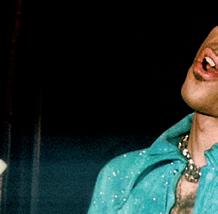





















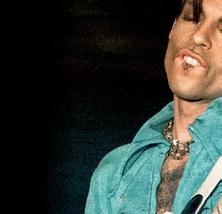



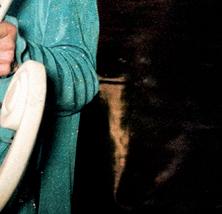
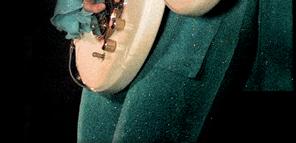
















Due to popular demand, Prince: The Immersive Experience is extending its purple run on Chicago’s Mag Mile January 1st! Don’t miss this incredible opportunity to experience an interactive journey through Prince’s musical universe. through 1 GET YOUR TICKETS NOW! PrinceTheExperience.com @PrinceTheExperience @PrinceTheExp A Superfly PRODUCTION. PRINCE name, logos and related indicia are © and TM Paisley Park Enterprises, Inc.
The Reader’s guide to
World Music Festival Chicago
The festival’s 11 free concerts, spread out over ten days and 11 venues, offer more than inspiration and fun—they invite us to forge new bonds of community and care
By LESLIE ALLISON, JACOB ARNOLD, NOAH BERLATSKY, AARON COHEN, HANNAH EDGAR, LEOR GALIL, MARK GUARINO, CATALINA MARIA JOHNSON, MONICA KENDRICK, JOSHUA MINSOO KIM, STEVE KRAKOW, JAMIE LUDWIG, BILL MEYER, PHILIP MONTORO, JAMES PORTER, KELLEY TATRO, AND SANDRA TREVIÑO
SEPTEMBER 29, 2022 - CHICAGO READER/WORLD MUSIC FESTIVAL CHICAGO 1
World Music Festival Chicago
WORLD MUSIC FESTIVAL CHICAGO
Full schedule on the back cover of this guide. Friday, September 30, through Sunday, October 9, various times and venues, all concerts free, many concerts all ages
The term “world music” has never been adequate to the task we’ve set it—even in its most benign reading, it implies a division between the listener and the rest of the world. And if that listener is in the United States, our country’s global hegemony in popular music colors the term’s meaning too.
Americans don’t have to listen outside our borders to participate in an influential, relevant, up-to-the-moment musical culture. Much of the rest of the world does—or, more accurately, much of the rest of the world is made to feel as though it does. When it comes to music, we export much more than we import.
Looked at in such a light, “world music” represents an opportunity for Americans to recognize our privilege in this area—and to level the playing field, at least between our own ears. The World Music Festival exists to encourage this sort of curiosity, empathy, and connection.
After shutting down for the first two years of the COVID-19 pandemic, the World Music Festival is returning to Chicago in 2022, with 11 concerts at 11 venues between Friday, September 30, and Sunday, October 9. While the aspiring fascists in the Republican Party escalate their campaign to turn nonwhite for eigners into targets for fear, resentment, and hatred, our city welcomes artists from India,
Colombia, Cuba, Mali, Mexico, Bolivia, and beyond. No other event gives so many of Chi cago’s diverse populations the joy of a concert that says “home.”
Founded in 1999, the World Music Festival is organized by David Chavez and Carlos Cuauh témoc Tortolero of the city’s Department of Cultural Affairs and Special Events, with Brian Keigher of People of Rhythm partnering with Tortolero on Ragamala, the marathon of Indian classical music that’s opened every fest since 2013. Though we can be grateful the festival is happening at all, the pandemic still got its licks in—DCASE wasn’t able to begin preparations till February, when the city decided that the risk of COVID-related cancel lation was low enough. Ordinarily work on the next festival starts as soon as the previous one ends.
Given the length of the visa process for over seas artists, losing four months meant losing many opportunities to book those artists. As a result, more than a third of this year’s acts are from Chicago—a huge increase from 2019, when their share was closer to one in seven.
That doesn’t seem so much like a compromise with circumstances, though, when you con sider that the local music on the bill includes the gritty East-West fusion of the Arab Blues, the Peruvian-flavored jazz of Juan Pastor Chinchano, the updated Mongolian and Tuvan folk of Tuvergen Band, and the rambunctious, hard-rocking ska en español of Malafacha.
The lineup of out-of-town artists is even more exciting, in part because DCASE chose to book a larger number of emerging acts instead of splashing out on a headliner big enough for Pritzker Pavilion. Millennium Park shows are great, sure, but so is the chance to see such a dazzling variety of music, all for free, in a little more than a week. La Dame Blanche (Cuba by way of France) pairs her fierce rhymes and dramatic flute with colossal beats from across the African diaspora; Paolo Angeli (Italy) turns his cleverly modified Sardinian guitar into a percussion engine; Gili Yalo (Ethiopia by way of Israel) honors the jazzy, funky grooves that his homeland made immortal in the 60s and 70s; and Kaleta & Super Yamba Band (Benin and Nigeria by way of New York City) fuse Afrobeat and juju for a driving, danceable sound that’s as cheerful as it is aggressive. By some metrics, the festival is smaller than in 2019—there were 18 concerts then, not 11, and they were spread out over 17 days rather than ten. But the total number of artists has stayed about the same, at around three dozen—the big change is that this year 16 of those artists appear at two big events, Raga mala and the Global Peace Picnic.
For 2022 DCASE has booked a slightly larg er share of the festival’s shows at conventional music venues (as opposed to city buildings or parks), which Tortolero says was intended in part to help those venues survive pandemic losses. The city covers every expense—artist
fees, hotels, transportation, sta and produc tion costs, back-line rental, rider fulfillment— so that all revenue the venue makes from bar sales and other sources stays in-house. In re turn, the city benefits from the venues’ estab lished audiences and marketing operations.
The festival’s use of conventional venues presents an accessibility issue—none of them admits concertgoers of all ages, and they’re mostly on the north side. But they provide better sound than you’d get in any park setting that isn’t Pritzker Pavilion, and they’re less dependent on good weather.
More important, World Music Festival con certs don’t put up barriers of their own—nei ther the literal fences that surround a public park when it’s occupied by a for-profit fest nor the metaphorical hurdles created by cover charges and tickets. We’ve all paid for this pro gramming already, and it’s for everyone.
That might be the best thing about the fest. Decades of right-wing depredations have en dangered the idea of a common good, replac ing the connecting threads of our society with “Fuck you, I got mine.” But the World Music Festival was created for no other reason than to make us happy and bring us closer togeth er—and it’s expressly designed to do that for as many di erent people as possible. In that way, it’s a lot like music itself.
PHILIP MONTORO
2 CHICAGO READER/WORLD MUSIC FESTIVAL CHICAGO - SEPTEMBER 29, 2022 ll
World Music Festival Chicago 2022 is pre sented by the Department of Cultural Affairs and Special Events. Additional support is provided by the following partners: Chicago Park District, Consulate General of Israel to the Midwest, Italian Cultural Institute of Chicago, Navy Pier, Old Town School of Folk Music, Reva and David Logan Center for the Arts, South Asian Classical Music Society-Chicago, and South Asia Institute.
World Music Festival Chicago
FRIDAY30
Ragamala: A Celebration of Indian Classical Music Presented in collaboration with South Asia Institute, South Asian Classical Music Society-Chicago, and People of Rhythm Productions. This event continues into the morning of Saturday, October 1. Fri 9/30, 6 PM-8 AM, Preston Bradley Hall, Chicago Cultural Center, 78 E. Washington, third floor, all ages
This year closes the first decade of Ragamala, the largest overnight Indian classical music concert in the country—it debuted as part of the World Music Festival in 2013. Think of it as a sophisticated and inspiring slumber party, and bring your cozy accou trements—thermos, pillows, snacks—so you can take in as much of this experience as possible. Ragamala offers a thrilling variety of performers in the genre’s two main styles, Hindustani (northern) and Carnat ic (southern). To arrive at a deeper understanding of these traditions and of what to expect at Ragamala, the Reader spoke with two of this year’s most innovative performers, Hindustani sarangi play er Suhail Yusuf Khan and Carnatic vocalist Roopa Mahadevan.
Hindustani and Carnatic music both consist of vast, elaborate systems of melodic structures (variously called raga, rag, or raag) and rhythmic cycles (tala or taal). “These ragas are your muse,” Mahadevan explains. “What is the essence of the raga? What does it look and feel like?”
positions in Hindustani music has nothing to do with how the composer composed it,” Khan says, “but the way an artist’s individuality allows for expression.”
“Designation of rags according to different times of the day [is part of] the Hindustani music system,” Khan adds, so all night concerts such as Ragamala “bring out a flavor of rag music otherwise hard to experience.”
“Concerts are getting shorter, people are mar keting via social media, smaller clips,” Mahadevan says. Meanwhile, Ragamala provides a space to slow down and luxuriate in the opulence of Indian clas sical music. Mahadevan has performed at Ragamala before, and she describes the vibe as a “one stop shop—people can just show up and there’s some thing intimate, like you’re in someone’s living room.”
Mahadevan also treasures what Ragamala offers her as a musician. “It’s a really heartwarm ing experience to see the number of people sit ting there at [3 AM],” she says. “Like, oh yeah, art does really mean something for a lot of people!” LESLIE ALLISON
6–7:15 PM Purbayan Chatterjee, Rakesh Chaurasia, and Ojas Adhiya


unfolding path through waving fields of microtones and crisply elaborated structures. In September 2022, Purbayan released the album Saath Saath in collaboration with Chaurasia, his friend of two decades.
Chaurasia’s bansuri radiates a warm cloud of mel ody, husky and smooth. He maneuvers the North Indian bamboo flute from a lilting, swooning dance into a meditative hum. He believes that the aesthet ic beauty of Hindustani music is inseparable from its healing and spiritual powers. “While performing . . . I feel as if I am praying in a temple,” he said in a 2016 interview for the Darbar Festival. “The notes have to do something within your system so it affects your chakras and your mind frame.” Tabla player Ojas Adhiya engages with his collaborators fully, shift ing like a hunter between loose, open focus and lightning- fast forward propulsion. His expressive face silently exchanges detailed musical informa tion with his collaborators as the syncopated pitch es of his paired drums ring out from under his agile hands.
This all star trio will immerse you in the sounds and sensations of twilight, helping you sink into alignment with the present moment—and pre paring your state of mind for the night ahead.
LESLIE ALLISON
Purbayan Chatterjee (le ) COURTESY THE ARTIST Rakesh Chaurasia (center) COURTESY THE ARTIST Ojas Adhiya (right) COURTESY THE ARTIST
The two styles differ somewhat in their approach to interpretation. “Carnatic relies more heavily on songs as the center—any improvisation you’re doing is around a particular song,” Mahadevan says. Hin dustani tradition, by contrast, encourages improvi sation as the focal point of a performance. “Unlike Western classical music, the interpretation of com
Ragamala kicks off with an unstoppable Hindustani trio of Purbayan Chatterjee (sitar), Rakesh Chaur asia (bansuri flute), and Ojas Adhiya (tabla drums). Coming off an August performance together at Carnegie Hall, these artists are deeply attuned to one another. Themes bounce among them with kinetic spontaneity as the bansuri sculpts the air, the tabla molds the earth, and the sitar performs a metallic alchemy between them.
Chatterjee, a Mumbai based sitarist, has per formed on almost every continent, solo and with ensembles Shastriya Syndicate and Stringstruck. His exploratory, incisive playing guides you on an
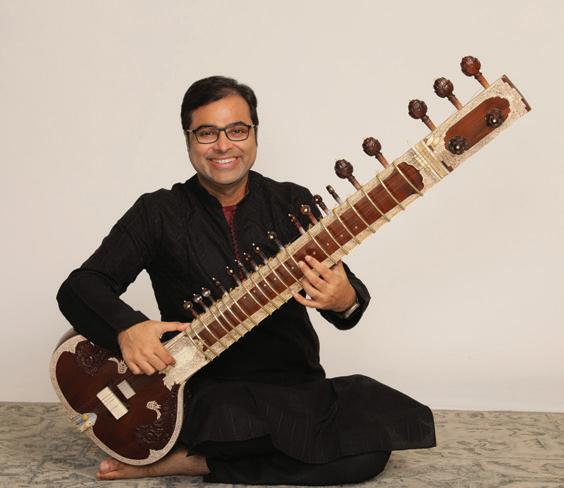
7:45–9 PM Roopa Mahadevan, Sruti Sarathy, and Rohan Krishnamurthy
Bay Area based vocalist Roopa Mahadevan is a torchbearer for the evolution of Carnatic singing in the diaspora. Her performance—the only vocal set at Ragamala—is a must see. Mahadevan presents the lyrical canon with charisma, thoughtfulness, and joy. Her lithe and nuanced melodies and her rich, grounded timbre are evocative on their own, but she adds extra dimensions by “pushing the Carnat ic concert format,” as she puts it, to include “what
SEPTEMBER 29, 2022 - CHICAGO READER/WORLD MUSIC FESTIVAL CHICAGO 3
World Music Festival Chicago
continued from 3
these compositions mean to us, to bring a new lens to the music.”
Mahadevan performs in art-world and popularmusic contexts, leading the crossover jazz and soul ensemble Roopa in Flux as well as a choir called the Navatman Music Collective. She also sings for Bharatanatyam and modern dancers, and this connection shapes her practice: “I love mov ing,” she says. “So much of Indian music is how you play around with space, how the notes glide and connect; it means a lot to me to be able to gesture and respond to that with my entire body. That’s the aliveness of it—it brings all of you to the performance.”
Mahadevan and violinist-composer Sruti Sarathy are currently creating new pieces exploring con temporary themes using Carnatic forms. “In some ways, the cultural ethos of the Carnatic music world is at odds with what we care about in the diaspo ra,” Mahadevan says. “But we don’t want to give up on the beauty of the tradition, the complexity it has to offer. So we asked, ‘Are there ways we can do both?’” Their original album advancing the Carnat ic repertoire will be released in 2023. Mahadevan’s Ragamala set, with Sarathy and mridangam player Rohan Krishnamurthy, will draw on the three musi cians’ long-standing collaboration.
For Mahadevan, “the singing of these songs is transformative.” Listeners will be transformed as well. LESLIE ALLISON
9:30–10:45 PM Anupama Bhagwat and Amit Kavthekar
The sitar is the most familiar Indian instrument to
American ears, but its incredible range and power can still startle even an experienced listener—espe cially in the arms of Anupama Bhagwat. She de ly plies the shiny loom of her sitar’s silvery strings to weave a three-part cloth: vibrant melody plays out against a backdrop of echoing drones, all draped in a shimmering veil of sympathetic vibrations. Though Bhagwat improvises and interprets in the Hindustani style particular to her musical lineage, she leads with the commanding presence and sidesmiling coolness of her own artistic voice.
Bhagwat’s sitar speaks a cogent language that awakens the emotions and stimulates the imagina tion. On up-tempo compositions, her momentum is magnetic as she alternates vigorous cascades of rapid melody and swirling eddies produced by bending her strings. On chiller jams, her melodies pulse through a mist of resonance, as though mov ing in a dream. Simply put, she shreds.
Bhagwat, now living in Bangalore, has earned her reputation with more than 25 years of beguil ing performances across India, Europe, and the States. At Ragamala, her sitar will converse with the rounded pitches and burbling rhythms of the tabla, played by energizing and innovative Boston-based master Amit Kavthekar . Alongside its virtuosity, Kavthekar’s playing also delivers a distinctive, wink ing charisma. From the multilayered phrases of his drums, emotive expressions surface—jokes, ques tions, murmurs, retorts.
In a 2021 interview with the Suromurchhana Music Festival, Bhagwat explained how the fluctuat ing emotions evoked by each rag shape the music’s interpretation. The rag communicates with the vocabulary of the unconscious, she said: “The rag will take over, and the musician becomes one of the
listeners.” In this set, two inquisitive artists will care fully listen and channel what the rags wish to tell us. LESLIE ALLISON
11:15 PM–12:30 AM Indrajit Banerjee, Rupak Kulkarni, and Hindole Majumdar
Sitarist Indrajit Banerjee occupies a prestigious position in the venerated Maihar gharānā (a per formance community of northern Indian Hindustani music), and he’s also collaborated with all kinds of global artists—similar to the approach of another Maihar gharānā musician, Ravi Shankar. (Banerjee’s uncle and teacher, Kartick Kumar, was one of Shan kar’s top students.) Banerjee’s family legacy includes a commanding technique, particularly in the way he finesses lead lines while drawing resonance from his instrument’s sympathetic strings on piec es such as “Ahir Bhairav: Alap.” His music has also been included in a short film on Hindu rituals titled Cloth Paper Dreams. Like his predecessors, Baner jee teaches the traditions of the sitar to emerging generations of musicians, specifically at the Antara School of Indian Classical Music in Austin, Texas. He has also combined his instrument with elec tronic keyboards on the aptly titled “Sitar Jl Chill,” available on Soundcloud. Banerjee has previously worked with jazz guitarist Fareed Haque and sax ophonist Jeff Coffin, but at Ragamala he’ll perform in a traditional format with Rupak Kulkarni and Hin dole Majumdar. Kulkarni is a virtuoso on the bansu ri, a bamboo flute that’s been integral to Hindustani music for centuries. He sounds especially vibrant in a fast-paced combo with an equally dextrous per cussionist—someone like Majumdar. Based in Mil
waukee, Majumdar is a tabla player who’s mastered numerous complex rhythms (talas) from across India. He’s also a teacher, and he founded the Hin dole Majumdar School of Music and Dance in Wis consin. AARON COHEN
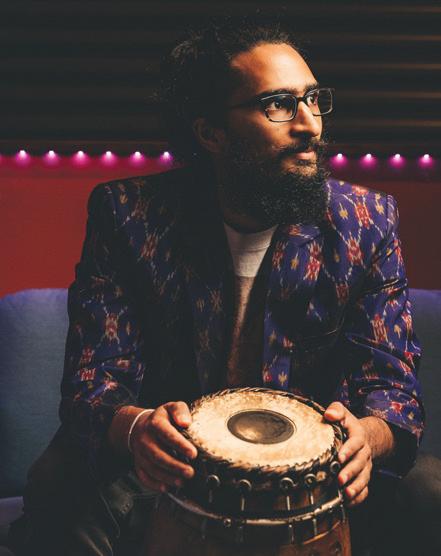
1–2:15 AM Saraswathi Ranganathan, Sruti Sarathy, and Rohan Krishnamurthy
Chicago-based musician Saraswathi Rangana than has brought the veena—specifically the longnecked South Indian lute used in Carnatic music—to a wide array of collaborations. Several of them fea ture her original compositions, such as the quiet ly inspirational “Ennai Azhaithaen—I Embrace Me,” a multilingual song commissioned by the Chica go Humanities Festival. Her cross-cultural meet ings also include accompanying a Buster Keaton silent film, engaging with hip-hop rhythms along side Colorado-based singer Sofie Reed, and help ing bring together musicians from across Europe, Asia, and Africa as founder of the Surabhi Ensem ble (who perform at the World Music Festival later in the week). But Ranganathan remains dedicated to her instrument’s traditions and legacy—she stud ied primarily with her mother, Shantha Rangana than, in Bangalore. She’s a Ragamala veteran, and her set at the 2018 event highlighted her devotion to that history as well as her striking technique. Ran ganathan shares a universalist perspective with the other members of this trio: violinist Sruti Sarathy, also a composer and singer, has been immersed in the Carnatic tradition since childhood, but she’s also worked in Hindustani music and collaborated with Japanese taiko drummers and Romani artists; mri


4 CHICAGO READER/WORLD MUSIC FESTIVAL CHICAGO - SEPTEMBER 29, 2022 ll
Roopa Mahadevan
COURTESY THE ARTIST
Sruti Sarathy SANDRA HERCHEN
Rohan Krishnamurthy
COURTESY
THE ARTIST
World Music Festival Chicago

dangam player Rohan Krishnamurthy has branched out from Indian classical to play jazz and funk.

Indian violinists Mysore Manjunath and Mysore Nagaraj, originally scheduled for this slot, canceled their tour due to visa problems. AARON COHEN
2:45–4 AM Suhail Yusuf Khan and Amit Kavthekar
Suhail Yusuf Khan is a versatile and sensitive per former, and you can trust him to carry you through the darkest hours of early morning. In the Hindu stani system, performances are a duet between the rags and the time of day: “Rags are structured melo dies designed to evoke certain feelings and height en the emotional state of the mind,” Khan explains.
“My rags for this concert will be selected accord ing to the time allotted.” If you’ve ever lain awake at 3 AM, wondering what it all means, this is an excep tional opportunity to delve into that mystery.
Khan carries forward the legacy of his grandfather, who was likewise a master of the North Indi an sarangi—a type of bowed viol carved from a sin gle block of wood. He’s been absorbed in Hindu stani music culture since childhood, and he’s also a composer and an ethnomusicology scholar who has written extensively about the sarangi and the con temporary transformations of Indian classical music. He relishes expanding the scope of his instrument.
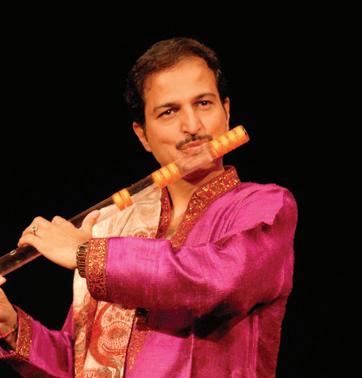

“Sarangi’s ability to be inclusive is what I love the most!” he says. “It can be tuned to any key, fit into any genre, and still maintain its own unique sound.”
That luscious, distinctive sound blends the bowing of the melody and drone strings with subtle rever berations emitted from a large complement of sym pathetic strings (anywhere from 11 to 37). Thanks to the cavernous, almost aromatic resonance of these sympathetic vibrations, the sarangi stands out among folk instruments for its resemblance to the human voice.


In Amit Kavthekar’s second set of the night, the tabla player will entwine his grooves with Khan’s rags. These two musicians have been collaborating since 2015, and their connection onstage is palpa ble. Combined with the soulful journey of Khan’s sarangi, Kavthekar’s fresh and responsive play ing will swirl out into your senses and linger there.
LESLIE ALLISON
4:30–5:45 AM Raman Kalyan and Rohan Krishnamurthy
Raman Kalyan , also known as V.K. Raman and “Flute Raman,” comes by his nickname honestly. A long standing master in the Carnatic bamboo flute, the venu, Kalyan has released more than 80 albums, performed for hundreds of commercials and films, and composed many scores for dance and theater productions. Kalyan breathes a living complexity into his instrument, and he does it with lively charis ma and a twinkling eye.
The venu looks simple, but Kalyan can draw an astounding diversity of textures and pitches from it. His melodies seem to escape the confines of the performance, skittering across the water, rumbling
SEPTEMBER 29, 2022 - CHICAGO READER/WORLD MUSIC FESTIVAL CHICAGO 5
Indrajit Banerjee, Rupak Kulkarni, Hindole Majumdar COURTESY THE ARTIST
Anupama Bhagwat
COURTESY THE ARTIST
Saraswathi Ranganathan
COURTESY THE ARTIST
Natty Nation M.O.D. PHOTOGRAPHY
World Music Festival Chicago
in the soil, zigzagging through the forest canopy. Whether bouncingly buoyant or thickly rooted, the irresistible tones of Kalyan’s flute crackle irresistibly with an unpredictable, playful electricity.
Kalyan has devoted his career to advocating for Carnatic music. He’s the founder of the Indo Amer ican Academy of Classical Music, an institution based in Virginia that also offers free online instru mental and vocal lessons. For his ongoing project 1000 Ragas @ 1000 Locations, he performs ragas in places he feels match the energy of the piece, o en playing outdoors and, charmingly, for nonhuman audiences—whether peacocks in someone’s yard or a bayou landscape buzzing with insects. He records
music for meditation and sound healing, and he col laborates with ensembles across global traditions— an expansive approach that’s also audible in the openhearted enthusiasm and fun of his playing.
At Ragamala, Kalyan will summon the spirits of dance and devotion with mridangam accompani ment by Rohan Krishnamurthy , in his second set of the event. Krishnamurthy is a percussionist and composer based in the Bay Area, and in his trio the Alaya Project, he integrates Carnatic music, jazz, and funk. He’s developed a hybrid drum kit that bridges the practices of playing with sticks and by hand, and he’s patented a novel drum-tuning sys tem. His inventiveness also comes across in the epic narratives of his mridangam lines, wide in dynamic
6:15–7:30 AM Manik Khan and Hindole Majumdar
There’s no finer way to clear out the night’s dreams, collect your thoughts, and welcome the morn ing sun than with the sarod, a lutelike Hindustani stringed instrument with a calm, pure sound. Manik Khan ’s treatment of the sarod is confident, warm, and soothing, and his phrasing creates a relaxed and spacious environment for the tabla to unfurl its tendrils of rhythm.
Khan’s father, Ali Akbar Khan, a member of Hin dustani music royalty, trained him in sarod and ini
tiated him into the world of performance by having him play on tour alongside him. Now an esteemed solo musician in the Bay Area, Khan builds on his lin eage through traditional performances, crossover collaborations, and educational programs and part nerships with local symphonies and school youth orchestras.

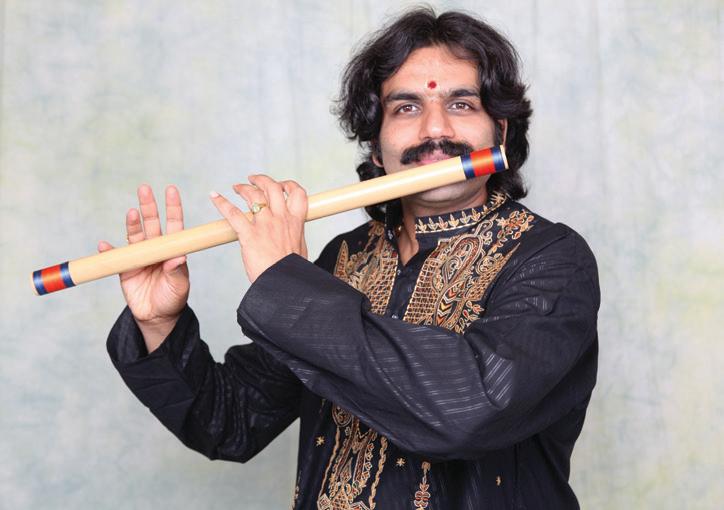
For this final Ragamala set, tabla master Hindole Majumdar will make his second appearance of the event. In addition to being a dedicated teacher, Hin dole has toured the world as a soloist and accom panied renowned dancers and instrumentalists. Though he’s also trained in mridangam, he’ll play tabla in this duo with Khan using his contemplative, exhaling lines to help cast the spell of the morning rags.


As sunrise pours down through the stained glass of the Cultural Center, congratulate your self for experiencing an absurd amount of worldclass art for zero dollars. Then get yourself home, rest, and digest the revelations of the past 14 hours.
LESLIE ALLISON
SATURDAY1
Global Peace Picnic This mini festival features eight acts on two stages. Sat 10/1, 1-7:30 PM, Humboldt Park Boathouse, 1301 N. Sacramento, all ages
Global Stage, 1 PM Tamburica Haus Bend
The word “tamburica” (spelled several ways in English, including “tamburitza”) refers to a family of stringed instruments widespread throughout East ern and Central Europe, particularly the countries of the former Yugoslavia and other Balkan nations. These long-necked lutes are close kin to the Indi an tamboura and the Persian tambura by way of the Silk Road and the Ottomans, and they belong to the same family of instruments as the viola-like kontra. Large formal tamburica orchestras have existed since the 19th century, but the instrument is more commonly played in a small string band with a bass, as it is in Chicago’s Tamburica Haus Bend. This for mat is closer in size and spirit to a traditional village ensemble that plays for community occasions both festive and somber.
For seven years, the Tamburica Haus Bend have been playing together at festivals and other events throughout the Chicago area. The ensem ble is slightly unusual in that bassist Zoran Miletić, tamburica player Joe Kirin, and kontra player Bob Persa are joined by an accordionist, Zoran Radova nović. They get a great deal of sound out of such a small group of players, bringing a joyful, infectious energy to a raucous and bittersweet repertoire that comes from Serbia, Croatia, Bosnia, and other nearby countries. I reached Kirin for an online chat, and he described two of his favorite songs from the band’s usual set: the upbeat, clap-along dance num ber “Evo Banke” (“Here’s the Bank”) refers to the
6 CHICAGO READER/WORLD MUSIC FESTIVAL CHICAGO - SEPTEMBER 29, 2022 ll
range and deep in rhythmic power. LESLIE ALLISON
continued from 5
Raman Kalyan, Manik Khan COURTESY THE ARTIST
Suhail Yusuf Khan, Amit Kavthekar COURTESY THE ARTIST
World Music Festival Chicago

tradition of audience members showering Romani musicians with money when they’re moved by the music, while “Moja Mala Nema Mane” (“My Girl Has No Flaws”), made famous by Croatian band Zlat ni Dukati, is a playful love song with a slightly sin ister denouement. The Global Peace Picnic is an excellent setting to experience the Tamburica Haus Bend live; their music is ripe for dancing and for cel ebrating the persistence of culture and community through adversity.
MONICA KENDRICK
¡Súbelo! Stage, 1:30 PM Sones de México Ensemble
Formed in Pilsen in 1994, the Sones de México Ensemble have made it their goal to promote tra ditional Mexican son, a centuries-old form of folk music that fuses elements from Spanish, African, and Indigenous cultures. The Chicago group’s mas tery of regional Mexican musical styles has been central to their mission, and they’ve spent the past three decades performing live shows, selfreleasing albums, collaborating with dance compa nies, and holding classes and workshops. Their pas sion runs deep, and it overflows on their records. On their 1996 debut album, ¡Que Florezca! , they cull from huapango, mariachi, and more, creating a palpably jubilant mix. “¡Que Florezca la Luz!” over flows with cheerful group vocals in beautiful har mony, while “Xipe” highlights how easily the group can make simple percussion feel life-affirming. The celebratory vibe continues on 2002’s Fandango on 18th Street , where even the song titles (“Pol kas,” “Boleros”) affirm the group’s desire to deliver joy through as many genres as possible. Sones de México took more liberties on Esta Tierra Es Tuya, tackling Bach, Led Zeppelin, and the Woody Guth rie song that gives the album its title; here, more than on any of their other works, they aim to cap ture the Mexican immigrant experience in its infinite variety. The Sones de México Ensemble’s two most recent albums, 2010’s ¡Viva la Revolución! and 2013’s 13 B’ak’tun , both respond to specific events. The former celebrates the Mexican Revolution on the 100th anniversary of its beginning; it features music from the early 20th century and ends with a sprawl ing four-part suite that ranks among the group’s most epic recordings. The latter came shortly a er the Mayan calendar completed one of its many cycles on December 21, 2012, and includes an espe cially beautiful recording called “Xochipitzahuatl,” named after the traditional marriage song and dance. Listening to the Sones de México Ensem ble is to experience the richness of Mexico’s musical history.

 JOSHUA MINSOO KIM
JOSHUA MINSOO KIM
Global Stage, 2:30 PM Shanta Nurullah
When Shanta Nurullah le the U.S. for India in 1969, she wasn’t aware that she was joining a wave of musicians looking eastward for inspiration. A native Chicagoan, she’d joined a study-abroad trip to escape a lonely winter at her small Minnesota col lege, where she was one of only a handful of Black
SEPTEMBER 29, 2022 - CHICAGO READER/WORLD MUSIC FESTIVAL CHICAGO 7
Tamburica Haus Bend COURTESY THE ARTIST
Sones de México Ensemble HENRY FAJARDO
Shanta Nurullah LAUREN DEUTSCH
World Music Festival Chicago
from
students on campus. She fell in love with the sitar shortly a er arriving in Pune, in the western state of Maharashtra, and she spent the next six months absorbed in learning to play it. “It was just what I had to do,” Nurullah recalls. Still, she left India feeling discouraged because she’d been told that she’d have to practice eight hours per day for at least five years before she’d be a decent player. But when she returned to Chicago a er graduation and began collaborating with Phil Cohran of the Asso ciation for the Advancement of Creative Musicians (AACM) at his Black music workshops, he encour aged her to think beyond Indian classical music and even wrote some new material for her. “That was all the permission I needed,” Nurullah remembers. She began to find a voice, employing the sitar’s distinc tive timbres and textures to re-create spirituals and other songs as well as to improvise. In 2015, Nurul lah formed Sitarsys, a Chicago-based collective informed by her decades-long career as a musician, storyteller, and teacher. On their 2016 recording, Sitar Black, the group uses a variety of instruments, among them oud, trumpet, mbira, guitar, bass, voice, and percussion (including the madal, a Nepalese hand drum). They play blues, jazz, and tradition al tunes and also perform group improvisations, an eclectic approach that allows the musicians “to express who we are and what’s important to us as
citizens of the world,” says Nurullah. KELLEY TATRO
¡Súbelo! Stage, 3 PM AfriCaribe
AfriCaribe ’s bomba performances create a cele bration for the eyes and ears. The ensemble’s many members converse with one another in a complex interplay: A semicircle of women in white blouses, headscarves, and long, colorful ruffled skirts dance and sing a call-and-response melody. Two hand drummers accompany them, with the primo drum mer following the lead dancer’s improvised move ments and the buleador drummer keeping a con stant bass rhythm. A third percussionist accompa nies on cuá (a wooden barrel on its side, played with two sticks) while one of the singers plays a maraca.
Bomba is a Puerto Rican folk music, dance, and song with West African origins. Between the 16th and 19th centuries, the Spanish empire enslaved tens of thousands of Africans to work on sugar plantations. These Africans and their descendants helped shape Puerto Rican culture, including its art and music. Bomba was also influenced by the tradi tions of the Taíno people native to the island and by European dancing.
Evaristo “Tito” Rodriguez founded AfriCaribe in 2000 “to celebrate the African influence in Puer to Rico and other Caribbean lands.” The Chicago nonprofit maintains not just a bomba ensemble but
also a production company and a cultural center at 2547 W. Division, where it holds all-ages classes and other community activities. Before the pandemic hit, AfriCaribe had hosted monthly “bombazos” for more than 18 years.
The AfriCaribe ensemble, which ranges from eight to 15 members, consists of volunteers and focuses on education. Its activities, according to Rodriguez, include performances, lectures, demon strations, workshops, and residencies; it also devel ops curricula for teachers. “Bomba has always been part of the history of Latino music,” he explains. “We would listen to salsa groups of the 1950s and ’60s without realizing that some of those rhythms were based on bomba.”

The pandemic “really did a number on us,” Rodri guez acknowledges. “We tried on a few occasions to do the virtual thing, but it’s hard to perform in front of a camera. It’s not dishing out any kind of energies,” he says, laughing. “Bomba is very commu nal.” JACOB ARNOLD
Global Stage, 4 PM Natty Nation
Natty Nation are a Madison institution. In 2010, the alt-weekly Isthmus named the reggae band’s second album, 1998’s rootsy Earth Citizen , the 24th-best pop album to come out of Madison; in 2008, Natty Nation had begun a 12-year run of Black Friday
shows at the High Noon Saloon, a streak that might still be going if it weren’t for COVID-19. More than two dozen musicians have passed through the line up since the band began in 1995, and they’ve weath ered the loss of a cofounder, vocalist-guitarist Jef frey “J-Maxx” Maxwell, who died in 2001; bassistvocalist Demetrius “Jah Boogie” Wainwright is the sole remaining original member. Natty Nation have maintained a solid base in classic reggae grooves and themes (Rastafarianism, peaceful lifestyles, radical equity) while expanding their sound. The 2008 album Reincarnation , for example, stitches in elements of hip-hop, enlisting a handful of out side producers to add light boom-bap beats, dubby samples, and snatches of rapping that highlight the soulfulness of Natty Nation’s reggae. On the group’s most recent full-length, 2016’s Divine Spark , their relaxed melodies highlight reggae’s great capacity for transcendent repetition. “I’ve been into medita tion for a while,” Wainwright told Isthmus a er the release of Divine Spark . “We’re picking up people through that.” I have no trouble believing him, since these guys prefer to reach fans by playing live—and they’ve had nearly three decades to perfect their hypnotic reggae riddims. LEOR GALIL
¡Súbelo! Stage, 4:30 PM La Dame Blanche
8 CHICAGO READER/WORLD MUSIC FESTIVAL CHICAGO - SEPTEMBER 29, 2022 ll
Flutist, singer, and percussionist Yaite Ramos Rodri
AfriCaribe’s bomba ensemble COURTESY THE ARTIST
continued
7
guez, aka La Dame Blanche, was born in 1979 into a musical family in Pinar del Río, the westernmost province of Cuba; her father, Jesus “Aguaje” Ramos, is a trombonist and musical director of the Orquesta Buena Vista Social Club, and her uncle Mayito Rive ra spent more than two decades as the front man for legendary Cuban band Los Van Van. She began conservatory training in classical flute at age eight, then relocated to Paris in the late 90s. A er mak ing her mark as backup singer with French-Spanish punk raggamuffin band Sergent Garcia, she began developing her own musical persona as La Dame Blanche. Ramos Rodriguez’s stage name is meant to evoke a fearsome yet benevolent mythical figure—a witch, sorcerer, and healer—as well as to reflect her beliefs as a practitioner of Santería (an Afro-Cuban spiritual system with roots in Yoruban beliefs). Her tunes inject traditional sounds—notably batá drums, used in many religious ceremonies—into a compel ling, ultra-danceable fusion of styles from across the African diaspora, including rumba, reggae, dancehall, cumbia, and moombahton. Masterfully backed by French sound engineer and beat maker Marc “Babylotion” Damblé, La Dame Blanche spits fierce feminist calls to power and pride in the face of sexist violence, her rhythmic flow marked by fla vorful Cuban slang; she also punctuates her vocals with dramatic flute lines that reflect the Latin-jazz grooves she explored at Havana’s Escuela Nacional de Arte de Cuba. La Dame Blanche’s buoyantly cre ative performances feel as if they map out the road from rumba to rap. CATALINA MARIA JOHNSON
Global Stage, 5:45 PM Jina Brass Band Chicago
The newly established Jina Brass Band Chica go shares DNA with a New York group founded in 2005 under a similar name—they’re both baraat brass bands, named for the groom’s processional in a South Asian wedding, and they capture the ener gy and excitement of that celebration with tradition al baraat songs, classic Punjabi tunes, and upbeat Bollywood numbers. Both bands also get support from New York-based percussionist Sunny Jain, leader of the group Red Baraat: the son of Punja bi immigrants, he runs a company called Jainsounds that supplies live music for weddings. The local ver sion of Jina Brass Band is led by one of his many Red Baraat collaborators, Chicago-based tubaist Akshat Jain, who also teaches at the Merit School of Music and plays principal tuba in the Chicago Com posers Orchestra. He’s joined in the core lineup by trombonist Catie Hickey, who cofounded the work shop Taller de Trombones de Panamá in 2014, and percussionist Kabir Dalawari, who released a jazzy debut album in March 2022 called Awareness. Jina Brass Band Chicago fills out its lineup with a shi ing cast of musicians, so that its complement of instruments always includes sousaphone, trombone, trumpet, saxophone, and percussion—including the double-headed dhol, a drum long associated with rambunctious bhangra beats and other forms of South Asian folk music. Akshat Jain is also part of
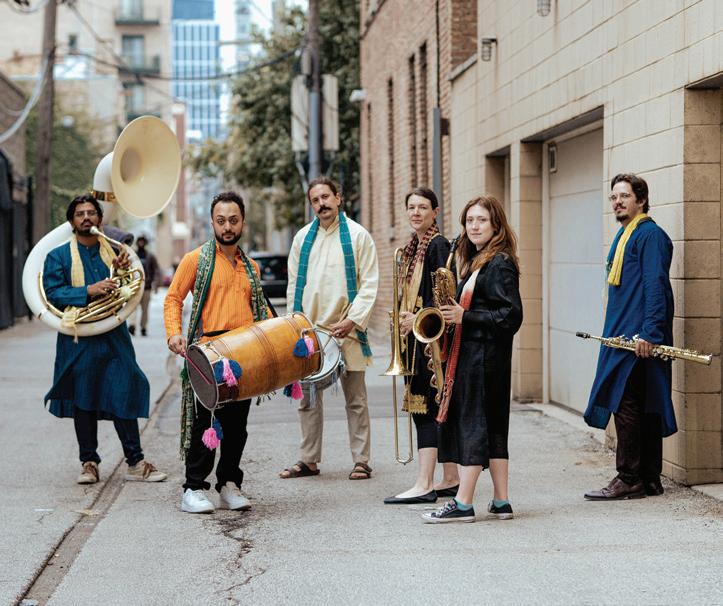
World Music Festival Chicago
party-happy marching band Mucca Pazza, so you’d better believe he knows how to keep a crowd on its feet. LEOR GALIL
¡Súbelo! Stage, 6:15 PM Bazurto All Stars
Colombian band the Bazurto All Stars build supremely danceable grooves upon the musical pil lars of champeta, a vibrant Afro-Colombian musi cal style and dance that originated along the coun try’s Atlantic-Caribbean coast—particularly in the urban centers of Cartagena (where the All Stars are based) and Barranquilla. Rooted in the music of the descendants of the free Black communities who populated the region in the 18th century, champe ta jelled into its contemporary form in the late 70s and early 80s. U.S. audiences caught a glimpse of its fancy, hip-shimmying footwork and irresistible beats when Shakira (who’s from Barranquilla) brought it to the Super Bowl stage during her 2020 hal ime performance.

The Bazurto All Stars seamlessly blend classic champeta with rhythms from many of the African genres that helped inform it, such as Congolese soukous and Ghanaian highlife. They also veer into Caribbean grooves from Jamaica and Haiti, adding dollops of reggae as well as hip-hop and reggaeton. Four of the group’s seven members are vocalists, and they o en come together in tight, fluid harmo nies. One of those vocalists, Jeison Guerrero, is also an accomplished rapper, and his rhymes accentuate the band’s party-time themes.
Champeta songs typically flow from an intro duction and chorus into the genre’s most lively ele ment, a repetitive passage called the despeluque. In Caribbean slang, the term has come to refer to let ting your hair down in the wildest way and is now synonymous with partying. In the despeluque, the guitars and bass pull back, and the percussion—in the Bazurto All Stars, conga and drums—lays a foun dation for simple chants that facilitate audience par ticipation. For example, a 2020 single about travel ing with or without a visa is called “Pa’Lante,” a con traction of “para adelante” that usually means “go ahead,” “onward,” or “go for it”—and its repetition in the chorus echoes its use throughout the Americas as a popular chant in rallies advocating for social and political change. The Bazurto All Stars are put ting out the call: pa’lante Chicago, with a major moment of despeluque! CATALINA MARIA JOHNSON
La Chica, Beats y Bateria, DJ Fanita Banana Sat 10/1, 10 PM (doors at 9 PM), Martyrs’, 3855 N. Lincoln, 21+
La Chica is the creation of French-Venezuelan art ist Sophie Fustec. Born in Paris, she began play ing music at age six—first violin, then piano, which became her instrument of choice. Fustec visited Venezuela often while growing up, and at age 19 she decided to split her time between Europe and South America while studying classical piano and analog synthesizers. In 2010, when she was in her late 20s, she joined Bastien Picot, Florent Mateo,
SEPTEMBER 29, 2022 - CHICAGO READER/WORLD MUSIC FESTIVAL CHICAGO 9
Jina Brass Band Chicago MARK HALE
Bazurto All Stars COURTESY THE ARTIST
World Music Festival Chicago
continued from 9
and Anthony Winzenrieth to form French elec tro-pop band 3SomeSisters.
In 2015, Fustec debuted her solo work as La Chica, which combines R&B, pop, classical, elec tronic music, and other contemporary sounds. And she doesn’t just sing, she roars—manifesting her femininity and Latinidad as well as the healing pow ers of music. La Chica’s first EP, Oasis, dropped in 2017, followed by Cambio in 2019.

“I love rhythm. I grew up with Caribbean percus sion, so it naturally shows in my music,” Fustec says. “I usually build everything from the beat, even if it’s implicit. I need to feel a pulse to be able to create the rest. The colors in my harmonies come from many different inspirations, but the biggest is prob
ably my love for Debussy, on one side, and the UK scene with the Beatles, Radiohead, and James Blake on the other.”
Fustec’s latest release, 2020’s La Loba, is dedicat ed to her late brother, Pablo, who died in summer 2020 a er trying to rescue one of his dogs from a scalding hot spring. She fondly remembers Pablo as her companion on the road and in art, and their bond may explain the urgency in her voice through out La Loba—it channels pain, sorrow, and rage. But with this record, Fustec has transformed these emo tions into poetic vignettes of hope. “I’ve composed those songs to heal,” she explains. “It’s an ongoing transformation.” SANDRA TREVIÑO
Beats y Bateria are too eclectic for the mainstream
spotlight, but that variety also makes this globalmusic trio unpredictable and interesting. The Chi cago band’s far-reaching vision combines centuryold folk tunes and ancient rhythms with a modern electronic sheen, informed by the members’ diverse backgrounds: vocalist Ana Everling (see below) is Moldovan, and draws from her homeland’s music as well as jazz, fado, samba, and other styles; drummer Daniel Crane loves salsa, jazz, Afro-Brazilian music, hip-hop, house, and more; Cuban DJ and producer AfroQbano, aka Harold Gonzalez Medina, worked as a house and hip-hop DJ in Havana clubs and developed a taste for the rhythms of Afrobeat, funk, and bhangra.
A er moving to Chicago, Medina joined Beats y Bateria as well as Latinx music and arts collec
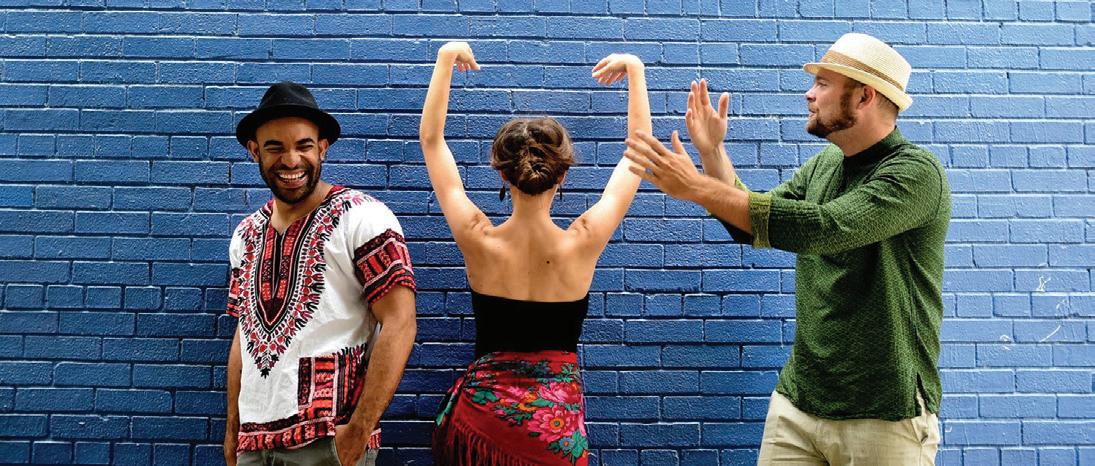
tive Future Rootz, and he’s shared stages with the likes of Mos Def, Pete Rock, Antibalas, and Hyp notic Brass Ensemble. He tied for runner-up in the Reader ’s 2016 Best of Chicago poll for “Best DJ.” Crane picked up drums at age 11 and started play ing professionally at 16. He took his first tour of Europe at 18, and a er college (where he studied jazz, Afro-Cuban, Afro-Brazilian, and West African rhythms) he traveled to São Paulo to learn more about Brazilian drumming. Everling became part of the Chicago scene in 2015, joining projects playing jazz and pop as well as Latin American and Balkan music. She has also added her vocals to Amada, Alfonso Ponticelli & Swing Gitan, and La Peña Orchestra, and her newest group is Taraf de Chica go, a folk ensemble that specializes in old Moldovan peasant songs.
Everling sings in several different languages, underlining the wildly hybridized nature of Beats y Bateria’s sound—the lyrics on their most recent sin gle, “Carolina” (from summer 2020), are in Portu guese. The tune starts like a traditional ballad, but then electronic textures begin to ebb and flow as the track morphs to encompass jazz, house, disco, bossa nova, and more. Beats y Bateria say they’re close to completing their first full-length album, which ought to be out in late 2022 or early 2023. They also plan to drop another single in time for their World Music Festival performance. STEVE KRAKOW
SUNDAY2
Paolo Angeli, Surabhi Ensemble
Additional support for Paolo Angeli provided by the Italian Cultural Institute of Chicago. Sun 10/2, 5 PM, Reva and David Logan Center for the Arts, 915 E. 60th, all ages
Plenty of critics have suggested that the age of guitar music is over, but they must be thinking of somebody besides Paolo Angeli . The Sardinian musician, vocalist, and ethnomusicologist might be one of the world’s most innovative guitarists, judg ing not just by his experimental compositions but also by the instrument he’s created to play them: a prepared chiterra sarda (“Sardinian guitar,” a largebodied baritone) that he’s outfitted with hammers, pedals, propellers, additional strings, and more, morphing it into a hybrid between guitar, cello, and percussion section. Angeli’s influences include traditional Sardinian music, postrock, jazz, and fla menco, and the techniques he’s mastered are just as varied: he strums and plucks (sometimes with a giant metal plectrum), he uses a bow, he taps out percussion with his bare feet, and he processes everything through a battery of effects pedals. His music is avant-garde, but it rarely feels abstract: the warmth at its core and its cinematic qualities make it supremely approachable. In 2019, he released 22.22 Free Radiohead, where he refracts ten Radiohead songs through his vision—and in a low-key power move, he recorded them with no overdubs. Angeli’s
10 CHICAGO READER/WORLD MUSIC FESTIVAL CHICAGO - SEPTEMBER 29, 2022 ll
La Chica COURTESY THE ARTIST
Beats y Bateria COURTESY THE ARTIST
latest album, Rade , came out earlier this year, and its fusion of breezy Mediterranean atmospheres with lush instrumentation feels like it reveals more secrets on repeat listens.
JAMIE LUDWIG
The Surabhi Ensemble create a cross-cultural fusion that includes Indian raga, Spanish flamenco, Mexican folk, and Arab maqam. These Chicagobased musicians, dancers, and artists work to demonstrate the commonalities among cultures—a mission they took on the road for a 2019 tour of Vietnam, Senegal, Portugal, and Spain—and they’re developing a new performance piece that draws on their collective experience of the pandemic. The show is sung in Arabic, Spanish, and Hindi and includes traditional and folkloric styles such as son jarocho, flamenco, and salsa, as well Rajasthani and Bharatanatyam dances. It also features poetry, man tras, meditations, and stunning visuals captured during the group’s travels to Oaxaca and Tahiti.
The Surabhi Ensemble consists of about a dozen artists, who bring a diversity of cultural backgrounds into the fold. Though this new performance high lights traditional music and dance, it’s not an exer cise in aesthetic purism, says Surabhi member Carlo Basile, also of of Las Guitarras de España.
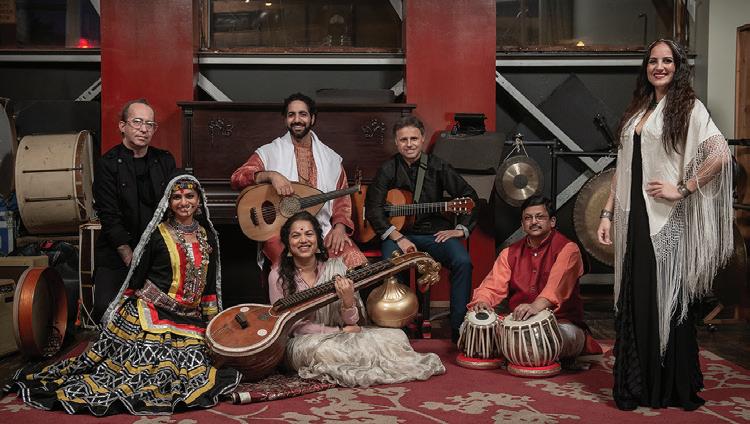

“Yes, there are many traditional aspects in the show, but there is much more going on,” Basile explains. “This isn’t so much about the dances or music being traditional, because they morph throughout the performance—it is more about us as human beings.”
COVID-19 and the uprisings following the police murder of George Floyd colored the pro duction from the start. “We had a big workshop about all the different feelings that we encoun tered, not just personally, but collectively as a soci ety, maybe, through the pandemic,” Basile says. “Things we went through as protocols, and what we went through with grief, and the loss, obviously, is astounding. All of these things came out in differ ent sections [of the performance] that we’re calling vignettes or scenes from the pandemic.”
At a concert this summer, the Surabhi Ensem ble put out a limited-edition prerelease version of their forthcoming album, Un Respiro Libre , which contains those pandemic songs. Some of that material, along with tunes they haven’t shared yet, will appear in their set at this World Music Festival showcase—and they’re hoping to have a final version of the album ready too.
SANDRA TREVIÑO
MONDAY3
Gili Yalo, Juan Pastor Chinchano
Additional support for Gili Yalo provided by the Consulate General of Israel to the Midwest. Mon 10/3, 7 PM (doors at 6 PM), Constellation, 3111 N. Western, 18+

When singer-songwriter Gili Yalo was four years old, he and his family were airli ed from Sudan with
World Music Festival Chicago
thousands of other Ethiopian Jews, who’d immigrat ed to escape the mid-1980s famine in their home land and ended up caught in the middle of Sudan’s civil war. The crisis prompted the Israeli government and the CIA to launch Operation Moses to resettle this vulnerable population in Israel. Yalo was lucky to survive the perilous journey—many children did not—but he still found it challenging to adjust to his adopted home. African immigrants faced discrimi nation, and because few Israelis understood Amhar ic, he had to learn to speak Hebrew. He got his start in music by singing in an army choir, pop cover bands, and a dub group, but then he went back to his Ethiopian roots. Yalo’s self-titled 2017 album, released when he was 36 years old, asserts his iden tity in an eminently danceable way, highlighting the
beats, horns, and keyboards of the Ethiopian funk and jazz that emerged in the 1960s (documented on the ongoing Éthiopiques series of albums release by French label Buda Musique). His songs use Ethi opian pentatonic scales (he began with the most common, called “tezeta,” and branched out from there), but he’s shifted some of their East African rhythms to fit with reggae grooves. Yalo returned to Ethiopia to shoot the 2017 video to “Selam,” which depicts him surrounded by children—many of whom are around the age he was when he first le the country. Two years later, Yalo recorded the 2019 EP Made in Amharica with the team of producers at Texas studio Niles City Sound, highlighting rockbased song structures and electric guitar leads. His recent singles, whose lyrics mix Amharic, Hebrew,
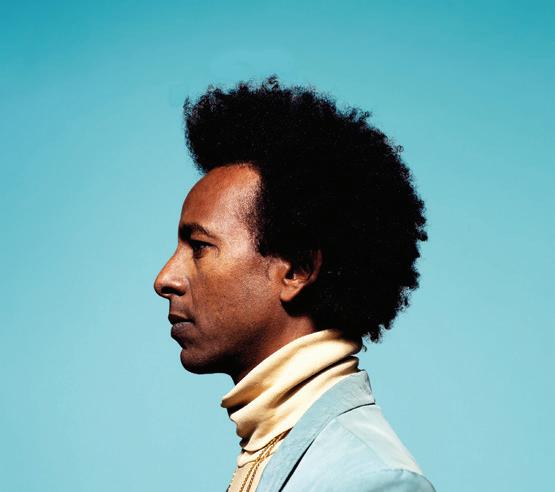
and English, embrace a variety of international sounds and some reliably universal themes: the lat est, this summer’s ballad “Yom Ehad Yavo” (Hebrew for “The Day Will Come”), is a plaintive cry for lost love. AARON COHEN
If Peruvian traditional music can be visualized as overlapping spheres of influence—indigenous Andean instruments, Spanish colonial dances, Afri can rhythms—then drummer Juan Pastor sits at the intersection of nearly all of them. In the years since he moved to Chicago in 2006, lured by the city’s jazz tradition and the university program at DePaul, he’s added even more elements to that nexus. Pastor got his start learning folkloric per cussion from family members and other musicians
SEPTEMBER 29, 2022 - CHICAGO READER/WORLD MUSIC FESTIVAL CHICAGO 11
Paolo Angeli COURTESY THE ARTIST
Surabhi Ensemble COURTESY THE ARTIST
Gili Yalo MICHAEL TOPYOL
Juan Pastor, drummer and bandleader of Chinchano COURTESY THE ARTIST
World Music Festival Chicago
continued from 11
in Lima, where he grew up, and when he heard jazz for the first time, he was “amazed.” As he recalls in the liner notes to Juan Pastor Chinchano, his 2014 recording debut, “I knew I wanted to learn to play it.” That album inaugurated his band of the same name, Chinchano, whose core lineup is now Pastor on drums and percussion, Stu Mindeman on piano, Matt Ulery on bass, and Dustin Laurenzi on tenor saxophone. On Chinchano’s new album, Carlitos , dedicated to Pastor’s late father, they’ll be joined by saxophonist Greg Ward, trumpeter Victor Gar cia, and percussionists Javier Quintana and Flavio Donoso (all based in Chicago except for Donoso, who’s from Lima).

“Chinchano” refers to someone from Chin cha province, south of Lima, or from its capital city, Chincha Alta, where Pastor first learned to play the box-shaped drum called the cajón (literal ly “crate” or “drawer”). The cajón is a cornerstone of Afro-Peruvian music, with roots both deep and bloody. Enslaved Africans in Peru repurposed wooden crates to circumvent bans on percus sion instruments, which slaveholders feared could encode insurrectionist messages. (Here in the Unit ed States, the patting juba—a dance that uses the body as percussion—was born out of a similarly dra conian ban.) Pastor has never left the cajón, and it’s become a central part of Chinchano’s sound: Pastor o en steps out from behind his drum kit to solo on it or to lead the band from his perch atop it.
HANNAH EDGAR
TUESDAY4
Seffarine, the Arab Blues Tue 10/4, 7 PM (doors at 6 PM), Sleeping Village, 3734 W. Belmont, 21+
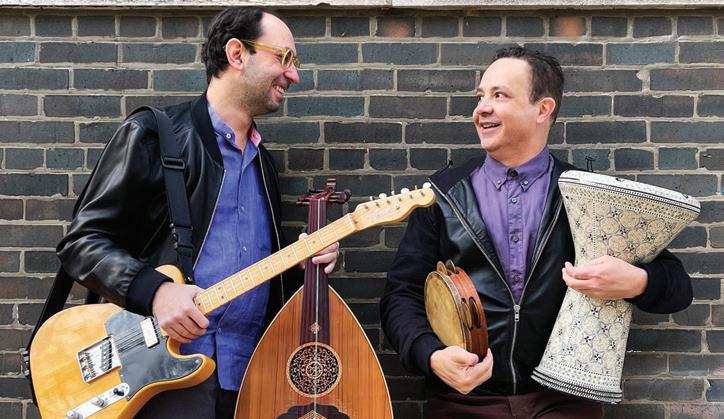
Genre fusion is sometimes seen as a relatively new
phenomenon, accelerating as technologies such as radio, television, streaming, and social media have lowered the barriers between communities. But humans have been mixing and matching sounds and influences basically since they started making music. Led by vocalist Lamiae Naki and flamenco guitarist and oud player Nat Hulskamp, Seffarine participate in that age-old tradition, connecting people by threading the needle between past and present. Based in Portland, Oregon, they’re named for an ancient square in Naki’s hometown of Fez, Morocco, famous for centuries for its metalwork ing (a tradition her family continues today). Much as Motown songwriters borrowed from the noises of Detroit’s automobile factories, Seffarine take some of their rhythms from the sounds of artisans at their craft. Their 2015 debut album, De Fez a Jerez , is rooted in the historical ties between Fez and Anda lusia, Spain, where Hulskamp has studied music— especially the period between the ninth and 15th centuries, when people, culture, and ideas flowed relatively peacefully between the two cities via the Strait of Gibraltar. The group function as a duo with guests in the studio, but when they play live they’re joined by Damian Erskine on bass, Madagascar-born Manavihare Fiaindratovo on percussion, and Ira nian multi-instrumentalist Bobak Salehi on kaman cheh, sehtar, tar, and violin. Seffarine’s music can melt the coldest hearts—the gorgeous, plaintive “Une Autre Chance” perfectly balances melancholy and romance. And their performances reach even greater emotional heights when cajón player Manu el Gutierrez, who’s also a celebrated flamenco danc er and choreographer, lights up the stage with his moves. JAMIE LUDWIG
Egyptian percussionist, DJ, and dancer Karim Nagi is a ubiquitous presence on the Chicago music scene. He performs solo concerts, which include dancing and storytelling; he leads Huzam, a quar tet of Arab American musicians who play original compositions in traditional forms; and he plays in
the Arab Blues project developed by Rami Gabri el, who’s not just a musician but also a professor of psychology at Columbia College. Gabriel switches between electric guitar, oud, and buzuq, while Nagi accompanies on riqq (a small tambourine-like frame drum), tabla (a goblet-shaped hand drum, often called a “darbuka” in the West), or an unconvention al trap kit assembled mainly from traditional instru ments (for a bass drum, he sometimes uses a box drum). Like the name says, the Arab Blues seek con nections between the Middle Eastern composition al and improvisational canon—called the turath—and the Western traditions of blues and jazz. This isn’t an entirely new approach, and in the duo’s sets you can hear occasional echoes of earlier East-West hybrids, such as Dick Dale’s surf-rock workout on the East ern Mediterranean folk song “Misirlou” or Rabih Abou-Khalil’s oud fusion classic “Blue Camel.” The Arab Blues’s synthesis is accessible, gritty, and exhilarating, and Nagi is a born performer—he always seems to be having the time of his life onstage. He and Gabriel create a sound that’s sometimes grace ful, sometimes bracingly noisy, like a Middle Eastern garage band. NOAH BERLATSKY
WEDNESDAY5
Eva Salina, Ana Everling Wed 10/5, 7 PM (doors at 6:30 PM), Schubas, 3159 N. Southport, 21+
In the United States, the general populace knows Romani music mostly via Spain and the flamenco guitar. But Romani traditions are much broader than a single country or instrument. New York-based singer Eva Salina has spent the past decade using her flexible voice and considerable intelligence to explore the wide range of Balkan Romani tradi tions. Her self-released 2013 debut, Solo , consists mainly of a cappella renditions of hymnlike songs—
even Salina’s breathing becomes part of the per formance, and her powerful keening vocals evoke Middle Eastern performers such as the great Oum Kalthoum. On the marvelous 2016 album, Lema Lema: Eva Salina Sings Šaban Bajramović, by con trast, she twines her melismatic lines around Balkan brass-band arrangements—it’s party music for extro verted flirtation. Her most recent record, 2018’s Sudbina, takes another le turn; Salina and Romani accordion player Peter Stan collaborate on a set of fleet, polka-tinged dance tunes and heartbreak bal lads associated with Vida Pavlović, a Serbian sing er known as “the Queen of Roma Music.” (Mace donian singer Esma Redžepova, a contemporary of Pavlović’s who also earned that epithet, is much more famous in the West.) A highlight of Sudbina is “E Laute Bašalen Taj Roven,” a jaunty tune whose rhythms suggest a waltz on a pitching ship deck and whose lyrics (by historian Milan Vasić) describe the torture and murder of Romani people in the Nazis’ Banjica concentration camp. Salina’s career so far is testament to an admirably restless aesthetic— she’s helped shine light on a repertoire whose true extent is mostly ignored even in traditional- and world-music circles. Stan has become a regular col laborator, and he’ll be accompanying Salina at the World Music Festival. NOAH BERLATSKY
Moldovan-born singer and guitarist Ana Everling moved to Chicago in 2010, and since joining the world music scene here in 2015, she’s grown into a mesmerizing artist. She adapts her clear, lucid voice deftly to multiple styles, singing jazz, fado, bossa nova, and various Eastern European genres with equal ease. In 2016 she collaborated with bass ist Jerry Fuller and guitarist Jarvis Raymond on Under Paris Skies, a tribute to more than 100 years of music from France’s most iconic city. In 2018 she released Soleira, a duo album with guitarist Caroli na Folmer that’s full of heartfelt renditions of works by Spanish and Latin American composers. She also does a dazzling Middle Eastern-inflected rendition
12 CHICAGO READER/WORLD MUSIC FESTIVAL CHICAGO - SEPTEMBER 29, 2022 ll
Lamiae Naki and Nat Hulskamp of Seffarine
COURTESY THE ARTIST
Rami Gabriel and Karim Nagi of the Arab Blues
COURTESY THE ARTIST
World Music Festival Chicago
of Duke Ellington’s “Caravan.”
Everling’s latest release, from early August, is a collaboration with guitarist David Onderdonk called The Music of Guinga . It celebrates the work of underappreciated Brazilian composer and guitarist Guinga (aka Carlos Althier de Souza Lemos Esco bar), who has collaborated with the likes of Sergio Mendes and Clara Nunes and had his songs record ed by Elis Regina, Chico Buarque, Cauby Peixoto, and many others. For decades, he also held down a day job as a dentist. Guinga has a light touch with his eloquent rhythms and melodies, and Everling and Onderdonk are a perfect duo to bring his com positions to elegant life.
Everling is also a member of Beats y Bateria, who play a World Music Festival show at Martyrs’ on Sat urday, October 1 (see above). MONICA KENDRICK

THURSDAY6
Al Bilali Soudan, Tuvergen Band This concert is part of the Old Town School of Folk Music’s Ojalá! series, supported by the Doris Duke Foundation for Islamic Art. Thu 10/6, 7 PM (doors at 6 PM), the Promontory, 5311 S. Lake Park Ave. W., 21+

Performers such as Tinariwen, Mdou Moctar, and Bombino have popularized and internationalized the Tuareg guitar sound of the West African Sahel, a fiery mix of desert blues and traditional Middle Eastern-tinged melodies and rhythms. Malian band Al Bilali Soudan stick closer to the music’s acous tic roots than most of their peers, but they have as impressive a pedigree as anyone in the genre. Abel low Yattara, the 69-year-old group leader, learned to play from his father when he was seven and appeared on the early 1970s cassette recordings of Ali Farka Touré; one of his uncles was a mem ber of Le Mali des Sables, who were included in the series of 1971 LPs that German label BärenreiterMusicaphon claimed as the first recorded anthol ogy of Malian music. Abellow formed Al Bilali Sou dan with his uncle Aboubacrine Yattara, and they’re accompanied by their sons Mohamed ag Abellow and Ibrahim “Tchiale” ag Aboubacrine. The core of their sound is an instrument known in the Tamasheq language as the tehardent, a fretless three-string precursor to the banjo (better known in the West by its Bambara name, “ngoni”); for percussion they use the calabash, a hollowed half gourd.

Al Bilali Soudan’s self-titled acoustic debut album (released in 2012 by Clermont Music) is mesmeriz ing and absolutely essential listening for anyone interested in Tuareg music—few recordings give you such a stark sense of the style’s ancient origins, with its jagged rhythms, stabbing runs of notes, and chanted phrases. The band go electric on their 2020 album, Tombouctou (also on Clermont Music), but even with amplification they remain distinct from their more Western-leaning contemporaries. You can hear parallels with the deep blues of Son House or Charley Patton, but they seem more like
convergence than influence, and the hints of Hen drix or Van Halen in the psychedelic solos of Mdou Moctar are almost entirely absent. Rather than adapt to the electric sound, Al Bilali Soudan sim ply perform as they always do while plugged in. The result is soulful, loud, and gloriously raw. This is the band’s first North American tour. NOAH BERLATSKY
By some counts, Mongolia’s horses outnumber its humans, and the country enshrines its long his tory of equestrianism in its music. The cello-like morin khuur, whose two strings and bow are tra ditionally made with horsehair, is the most recog nizable symbol of Mongolian musical culture. The neighboring Tuvan republic, now part of the Rus sian Federation, has its own analogue: the igil, sim ilar to the morin khuur but occasionally made with goatskin, stretched over the face of the sound box banjo-style. Because of the figurative carvings that o en adorn the instruments’ scrolls, both are collo quially called horse-head fiddles.
You’ll spot both instruments in Tuvergen Band , a Chicago-based trio that derives its name from the Mongolian word for “galloping.” Tamir Harga na and Naizal Hargana (no relation) lived in Inner Mongolia before moving to the U.S. for university, and they bring some of the country’s most distinc tive sounds to Tuvergen, including a variety of folk lutes (the Tuvan doshpuluur, the western Mongolian tovshuur) and a style of overtone singing native to Inner Asia called khoomei, which allows vocalists to layer one or more additional notes atop the fun damental—it creates instantly recognizable combi nations of buzzing, rumbling, and whistling tones.
Tuvergen’s take on Mongolian and Tuvan folk music frequently uses the ancient horseback rhythms of those styles, but it also roves as widely as their name implies, reflecting the band’s self-description as “modern nomadic music.” Much of Tuvergen’s fusion twist comes via American percussionist and ethnomusicologist Brent Roman. He plays five con tinents’ worth of instruments to evoke and augment the sounds of traditional Mongolian ensembles— including the Irish bodhrán (a frame drum, usual ly played by hand but here mounted on a kit), the Afro- Peruvian cajón (a box drum, which doubles as Roman’s seat), and the Indigenous Australian didgeridoo, whose overtone-rich drone comple ments Tamir’s khoomei singing. HANNAH EDGAR

FRIDAY7
Son Rompe Pera, Malafacha, DJ Kinky P Fri 10/7, 9 PM (doors at 8 PM), Reggies Rock Club, 2105 S. State, 18+
Son Rompe Pera are youthful, energetic, cosmo politan, and muy chilango—very much of Mexico City. The five-piece band, founded by three broth ers nicknamed Kacho, Kilos, and Mongo Gama, have built a driving, danceable sound around the marim ba. The brothers learned the instrument from their
SEPTEMBER 29, 2022 - CHICAGO READER/WORLD MUSIC FESTIVAL CHICAGO 13
Eva Salina DEBORAH FEINGOLD
Ana Everling
COURTESY THE ARTIST
Al Bilali Soudan COURTESY THE ARTIST
Tuvergen Band SUSIE INVERSO
World Music Festival Chicago
late father, who made a living as a musician in Nau calpan, on the outskirts of Mexico City. In their teen years, they left the marimba behind to play punk, rockabilly, and ska, and now that they’ve returned to it, their style carries the stamp of that musical jour ney—as well as a history of migrations upon migra tions that can make your head spin. The marim ba’s long journey tells of the forced relocation of African people to the Americas, but its presence in Mexico City provides evidence of 20th- century arrivals from the country’s rural south (especial ly Chiapas and Oaxaca, where marimba music is most established) who came to the burgeoning megalopolis in search of opportunity. Son Rompe Pera add to these associations a dizzying array of border-crossing sounds, including cumbia (likewise a well-traveled genre, and one of the band’s most beloved), a cover of a ska classic, and a remake of
Lalo Guerrero’s “Los Chucos Suaves,” which recalls the comings and goings of the 1940s subcultural figure of the pachuco. The band’s play with history coexists with street-savvy humor and a style that reflects Mexico City’s love affair with rock, punk, and metal—at Chicago’s Mole de Mayo festival ear lier this year, the crowd even got a circle pit going for a couple of numbers. Son Rompe Pera’s combi nation of irresistible intensity, impish iconoclasm, and deep musical roots ought to get your mind working, and it’ll definitely keep your feet moving.
KELLEY TATRO
Twenty-two years ago in Pilsen, two sets of broth ers—Ezequiel and Alejandro Cruz and Ivan and Moi ses Bello—formed the Latin rock-ska cover band Pirámides. In 2003, having become popular doing that, they decided to add more musicians, start writing original music, and change their name to

Malafacha
Malafacha are now reaping the rewards of stay ing together for almost 20 years, though the band have had about that same number of musicians come and go around the Cruz and Bello brothers. “It’s much easier now to put your music out there and get gigs, because there are so many festivals, so many venues, and so many more opportunities than we had when we began,” says Moises Bello. “I believe it’s because many who were involved since the beginning of the [Latin rock] scene in Chica go are still involved, but on a larger scale. For us to have seen these changes, from when there was nothing to now having options, it’s been amazing.”
Malafacha’s exuberant sound combines ska, alter native rock, metal, and punk en español, and their lyrics protest injustices, especially those directed at immigrants. Their music draws out the youth of the community while continuing to appeal to listeners

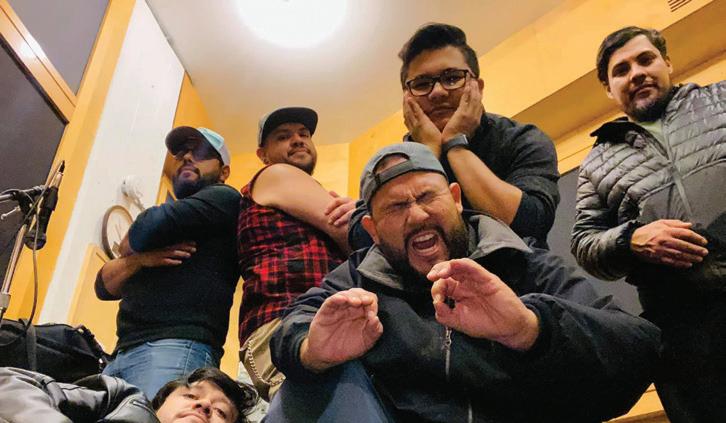

who grew up with the band—at their vivacious per formances, their original fans still turn out, while those fans’ children are now the ones fueling the mosh pit. In 2014, Malafacha helped launch the Chi cago Ska Collective to support bands from across the city and organize shows for touring bands.
In addition to the brothers—Moises and Ivan Bello on lead vocals and lead guitar, respective ly, and Ezequiel and Alejandro Cruz on bass and drums—Malafacha now also includes keyboardist Carlos Gutierrez, guitarist Roberto Carlos Tovar, trumpeter Jesse Escobar, and saxophonists Angel Lorenz and Ramón Esparza. This fall, Malafacha plan to release a new album produced by two heavy weights in regional Mexican music: Kevin Villalpan do (Alacranes Musical) and Armando Terrazas (Los Horóscopos de Durango). They’ve already put out the advance singles “Muy Temprano” and “Enterra dos en la Historia.” SANDRA TREVIÑO
14 CHICAGO READER/WORLD MUSIC FESTIVAL CHICAGO - SEPTEMBER 29, 2022 ll
Son Rompe Pera MARC VAN DER AA
Malafacha
COURTESY THE ARTIST
Kaleta & Super Yamba Band COURTESY THE ARTIST
Occidental Brothers Dance Band International COURTESY THE ARTIST
World Music Festival Chicago
places him in the lineage of his powerful mentors. The band has since made appearances (sometimes virtual, for obvious reasons) at several important music festivals, and two songs from Mèdaho were licensed for Zoë Kravitz’s 2020 Hulu series High Fidelity
Because Mèdaho came out only a few months before the pandemic, leaving little opportunity for touring, Kaleta’s live shows today are especial ly cathartic. He and Super Yamba have recently resumed playing in-person shows a er a two-year absence, and they feel it acutely. Their music was urgent already, and with this extra drive it’s ready to explode like a split atom. JAMES PORTER
SATURDAY8
Kaleta & Super Yamba Band, Occidental Brothers Dance Band International, DJ Mwelwa Sat 10/8, 10 PM (doors at 9 PM), Chop Shop, 2033 W. North, 21+
If it’s true you can tell a musician’s personality by their playing style, then Leon Ligan-Majek, aka Kaleta, is a man of contradictions. His fleet guitar pick ing feels almost introspective, weaving an intricate, subtle web of rhythm, but when he opens his mouth all hell breaks loose—his guttural holler demands your full attention. When Kaleta and his jaggedly
funky New York-based band, Super Yamba, record ed live at Paste magazine’s New York studio in 2018, he caught the host off-guard with a loud grunt before she could even introduce the group.

Kaleta was born in Benin, and during his adoles cence his family moved to Lagos, Nigeria, where Fela Kuti had just fused West African highlife with American soul and funk to create Afrobeat. Kale ta began performing in church in the late 70s, then spent a few years backing juju star King Sunny Adé before joining Fela’s band Egypt 80, where he got his grits with a long stint in the 80s and 90s. Psy chedelic rock was also a huge influence on him as a young man, and you can hear that too on his debut album with Super Yamba, 2019’s Mèdaho , which
Guitarist Nathaniel Braddock first convened the Occidental Brothers Dance Band International in 2005 as an instrumental four-piece with alto sax ophonist Greg Ward; they played mostly covers, focusing on the vintage West African styles that Braddock had begun teaching at the Old Town School of Folk Music. As the combo added mem bers, their repertoire shi ed. Their self-titled debut CD, released in 2006, consisted of sparse instru mental showcases for sweet reed melodies and lilt ing guitar picking, but its successor, Odo Sanbra , consisted mainly of high-energy dance tunes from Ghana that showcased the extroverted vocals of Kofi Cromwell, who was aboard from 2006 till ’08. By the time Congolese singer Samba Mapangala began his stint with the group in 2009, they were playing mostly originals. The Occidental Brothers’ performance schedule has waxed and waned over the years as musicians have moved in and out of town; Braddock relocated to Australia for a couple years in 2014 and currently lives in Cambridge, and Ward was based in New York for six years before returning to Chicago in 2015. But it has nonethe less persisted, taking on a series of collaborative endeavors, not just with Mapangala but also with Zambian vocalist Mathew Tembo and Brooklynbased choreographer Edisa Weeks. Sometimes the band still get back to their instrumental roots, and that’s how they’ll appear for their first Chicago gig since February 2020. Besides Ward and Braddock, the Occidental Brothers Dance Band Internation al will include longtime bassist Joshua Ramos and returning drummer Daniel “Rambo” Asamoah, for merly Cromwell’s bandmate in Ghanaian highlife group the Western Diamonds; he played on Odo Sanbra, and he’s filling in here for regular drummer Greg Artry. BILL MEYER
SUNDAY9
Cha Wa, Héctor Guerra Sun 10/9, 3 PM, Lake Stage, Navy Pier, 600 E. Grand, all ages
With the Neville Brothers and the original Meters both long out of commission, the group now carry ing the torch of New Orleans street music are Cha Wa . They named their 2016 debut album Funk ’n’
Feathers , and its sound combines the call-andresponse chants of Mardi Gras Indians, wild brassband revelry, and raw New Orleans funk. Cha Wa pay homage to those three traditions, and they do the job well. Their 2021 release My People (Single Lock), the band’s latest album, overflows with earthy grooves, rowdy group singing, syncopated secondline rhythms, smooth neosoul, and sophisticated horn arrangements. Many of their songs engage with social-justice concerns: the title track address es homelessness, and a cover of Bob Dylan’s “Mas ters of War” turns it into a mournful lament. But Cha Wa aren’t just rehashing the spirit and glory of past New Orleans masters; both their feet are in the present. Touches of rapping and sampling and an appearance by New Orleans singer Anjelika “Jelly” Joseph (a touring member of Tank & the Ban gas) give the songs a playful li . The band’s record ings can transport a walking parade into your living room, and their restless onstage energy and swag ger will bring a crowd to its feet. But even a strictly cerebral listener will get something to think about from Cha Wa. MARK GUARINO

Héctor Guerra ’s mestizo fusion has a Pan- Latin shamanic cumbia vibe, flavored by his Bolivian Andean and Andalusian Spanish background as well as his time living in Mexico with Indigenous artists and healers. In 2000, while still a teenag er, he cofounded Pachamama Crew, a collective inspired by Public Enemy but rooted in Latine style, whose music reflects the struggle of Latine immigrants in Spain. He began developing his own beats in 2003, and at 18 he toured as an opener for DJ Lord (a late-career member of Public Enemy).
A er Pachamama Crew’s sole full-length album in 2011, he moved to Mexico and began a solo career with the 2012 release Amor. His compositions, orig inally centered on rap, have evolved with the addi tion of cumbia, tropical bass, and Mexican folkloric music, along with reggae and dancehall. During his time in Mexico, Guerra collaborated with rockers such as Café Tacvba’s Rubén Albarrán and spent time with Indigenous people around the country, including the Comcáac in the northwestern state of Sonora. The pandemic shutdown brought about his latest album, 2021’s Perreo Cósmico, an ode to sexual liberation created in collaboration with a transatlantic roster of producers and musicians; its danceable grooves fit solidly within the global bass movement, sliding among trap, Afrobeats, reggae, hip-hop, dancehall, and cumbia. (“Perreo,” from the word for “dog,” is a dance popularized in the Dominican Republic and Puerto Rico, characterized by rhythmic grinding with one dance partner facing the back of the other.) Now living in Bolivia, Guer ra continues on a globe-trotting musical path that more intentionally highlights the Andean flavors of his paternal heritage. His upcoming album, Cum biando el Mundo , features Bolivian folk maestro Donato Espinoza, and on Spanish-language Bolivian podcast Lo Que Dice un Jilguero, Guerra described it as “cumbia for bettering the human experience.”
CATALINA MARIA JOHNSON v
SEPTEMBER 29, 2022 - CHICAGO READER/WORLD MUSIC FESTIVAL CHICAGO 15
Héctor Guerra COURTESY THE ARTIST
Cha Wa PATRICK NIDDRIE
FRIDAY30
Ragamala: A Celebration of Indian Classical Music This event continues into the morning of Saturday, October 1. 6 PM-8 AM, Preston Bradley Hall, Chicago Cultural Center, 78 E. Washington, third floor, all ages
6–7:15 PM Purbayan Chatterjee, Rakesh Chaurasia, and Ojas Adhiya
7:45–9 PM Roopa Mahadevan, Sruti Sarathy, and Rohan Krishnamurthy
9:30–10:45 PM Anupama Bhagwat and Amit Kavthekar
11:15 PM–12:30 AM Indrajit Banerjee, Rupak Kulkarni, and Hindole Majumdar
1–2:15 AM Saraswathi Ranganathan, Sruti Sarathy, and Rohan Krishnamurthy
2:45–4 AM Suhail Yusuf Khan and Amit Kavthekar
4:30–5:45 AM Raman Kalyan and Rohan Krishnamurthy
6:15–7:30 AM Manik Khan and Hindole Majumdar
SATURDAY1
Global Peace Picnic This mini festival features eight acts on two stages. 1-7:30 PM, Humboldt Park Boathouse, 1301 N. Sacramento, all ages
Global Stage, 1 PM Tamburica Haus Bend
¡Súbelo! Stage, 1:30 PM Sones de México Ensemble
Global Stage, 2:30 PM Shanta Nurullah
¡Súbelo! Stage, 3 PM AfriCaribe
Global Stage, 4 PM Natty Nation
¡Súbelo! Stage, 4:30 PM La Dame Blanche
Global Stage, 5:45 PM Jina Brass Band Chicago
¡Súbelo! Stage, 6:15 PM Bazurto All Stars
La Chica, Beats y Bateria, DJ Fanita Banana 10 PM (doors at 9 PM), Martyrs’, 3855 N. Lincoln, 21+
SUNDAY2
Paolo Angeli, Surabhi Ensemble 5 PM, Reva and David Logan Center for the Arts, 915 E. 60th, all ages
MONDAY3
Gili Yalo, Juan Pastor Chinchano 7 PM (doors at 6 PM), Constellation, 3111 N. Western, 18+
TUESDAY4
Seffarine, the Arab Blues 7 PM (doors at 6 PM), Sleeping Village, 3734 W. Belmont, 21+
WEDNESDAY5
Eva Salina, Ana Everling 7 PM (doors at 6:30 PM), Schubas, 3159 N. Southport, 21+
THURSDAY6
Al Bilali Soudan, Tuvergen Band 7 PM (doors at 6 PM), the Promontory, 5311 S. Lake Park Ave. W., 21+
FRIDAY7
Son Rompe Pera, Malafacha, DJ Kinky P 9 PM (doors at 8 PM), Reggies Rock Club, 2105 S. State, 18+
SATURDAY8
Kaleta & Super Yamba Band, Occidental Brothers Dance Band International, DJ Mwelwa 10 PM (doors at 9 PM), Chop Shop, 2033 W. North, 21+
SUNDAY9
Cha Wa, Héctor Guerra 3 PM, Lake Stage, Navy Pier, 600 E. Grand, all ages v
16 CHICAGO READER/WORLD MUSIC FESTIVAL CHICAGO - SEPTEMBER 29, 2022 ll



 By ALEJANDRO HERNANDEZ 40
By ALEJANDRO HERNANDEZ 40






















































































































 By MIKE SULA
By MIKE SULA


 by John Greenfield
by John Greenfield












































































 By DEBBIE-MARIE BROWN
By DEBBIE-MARIE BROWN











 By DMITRY SAMAROV
By DMITRY SAMAROV




















































 DIRECTED BY KATE WHORISKEY
DIRECTED BY KATE WHORISKEY
























































































































































































































 JOSHUA MINSOO KIM
JOSHUA MINSOO KIM




















